Artist Room
A Beginning

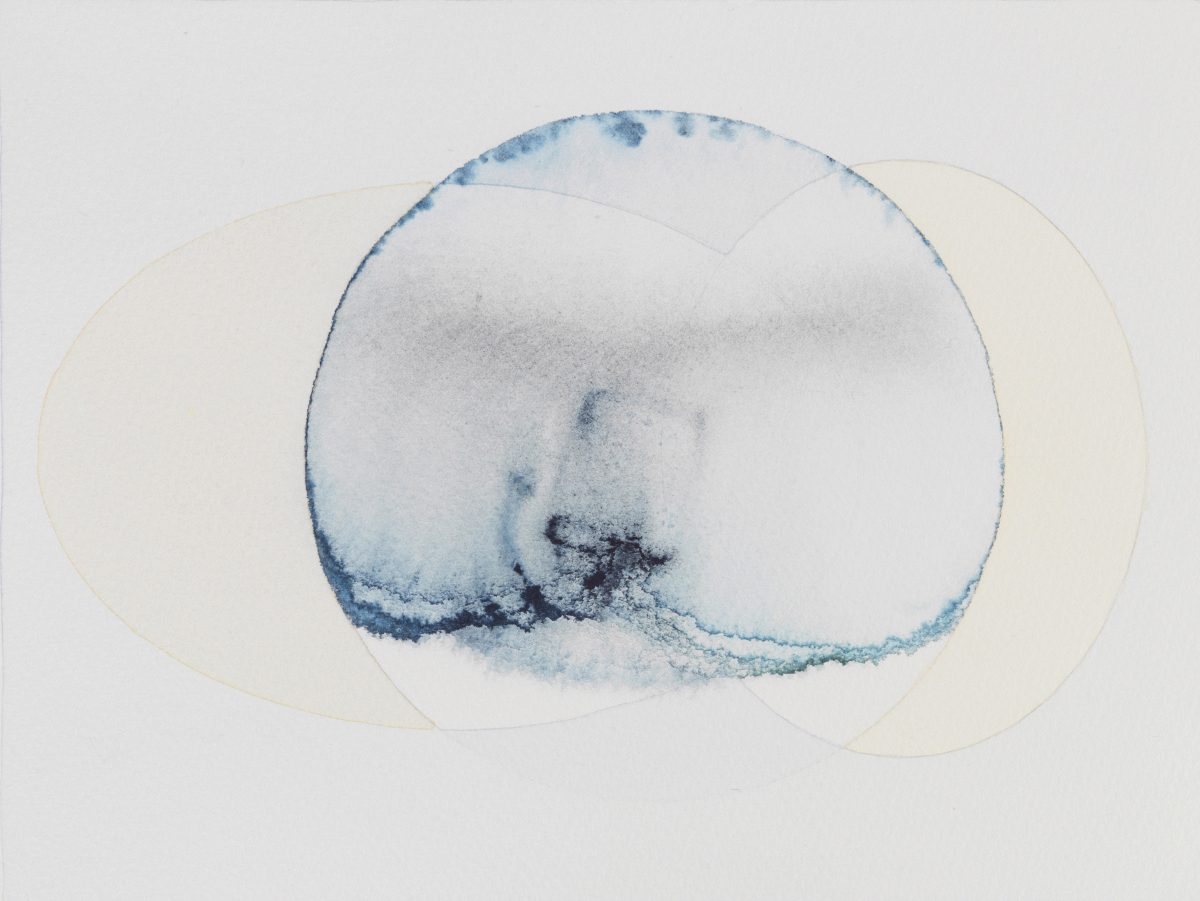
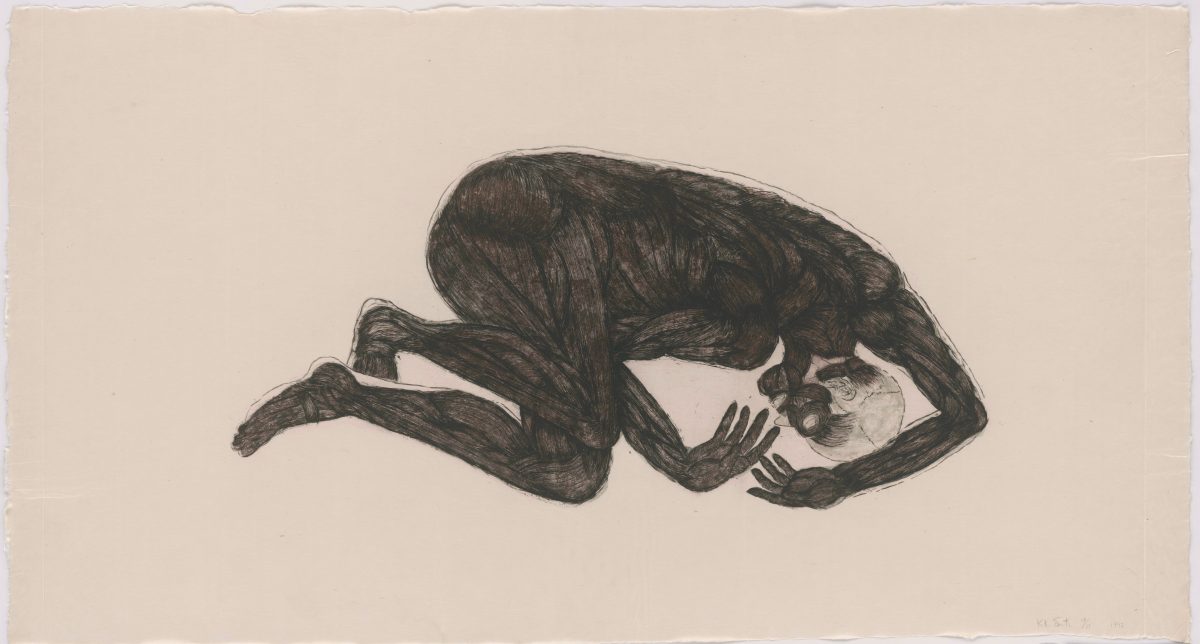
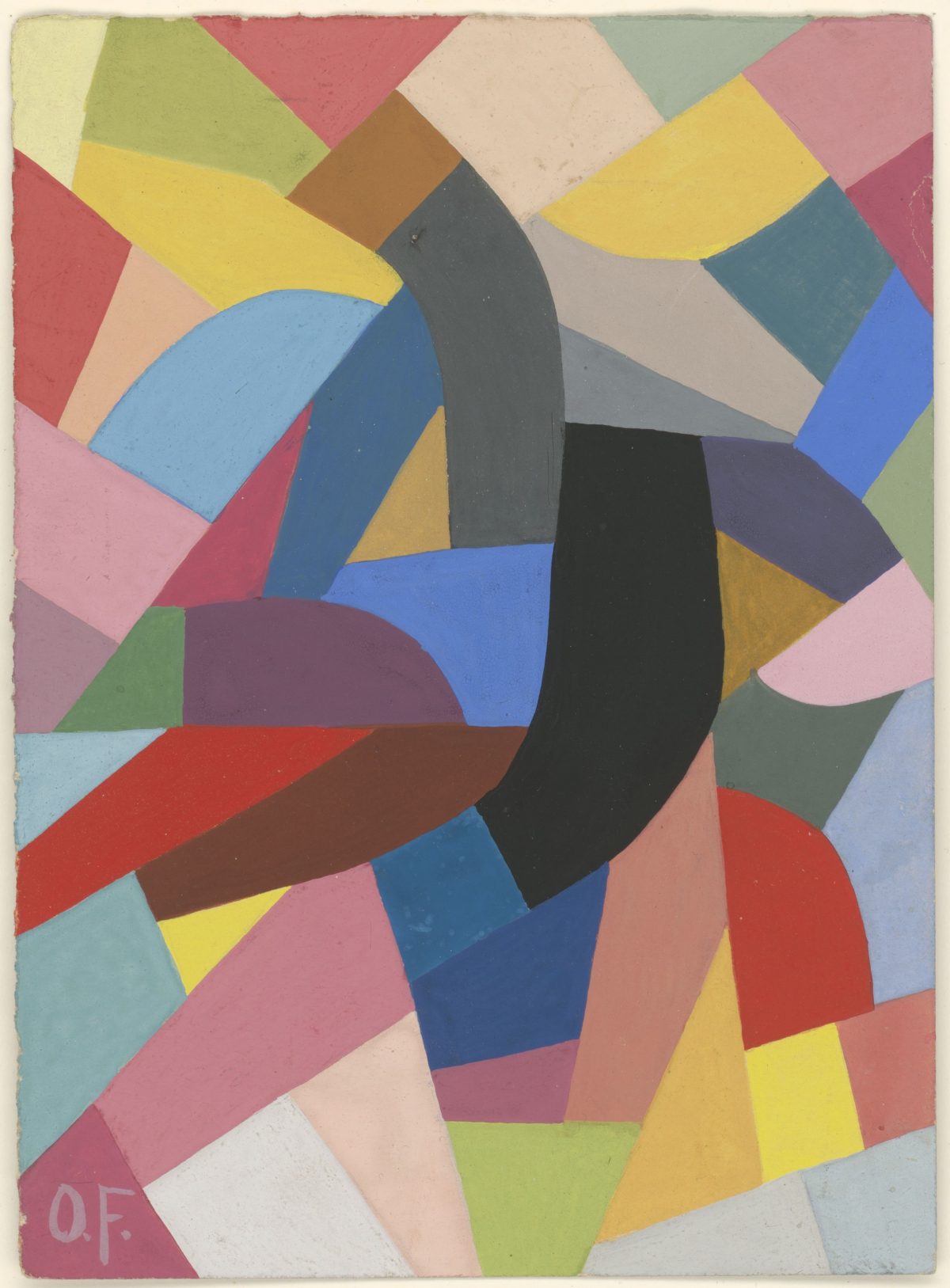
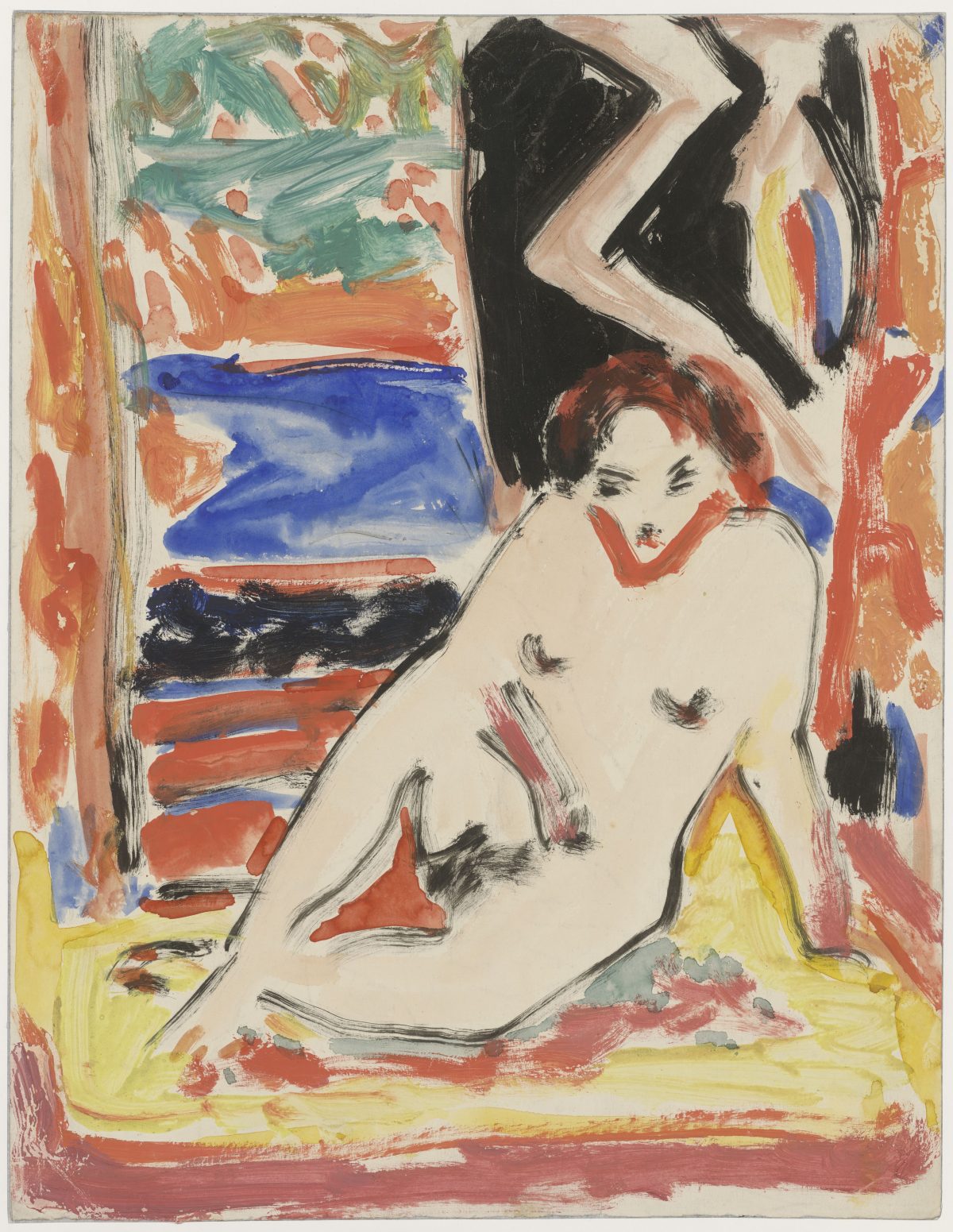
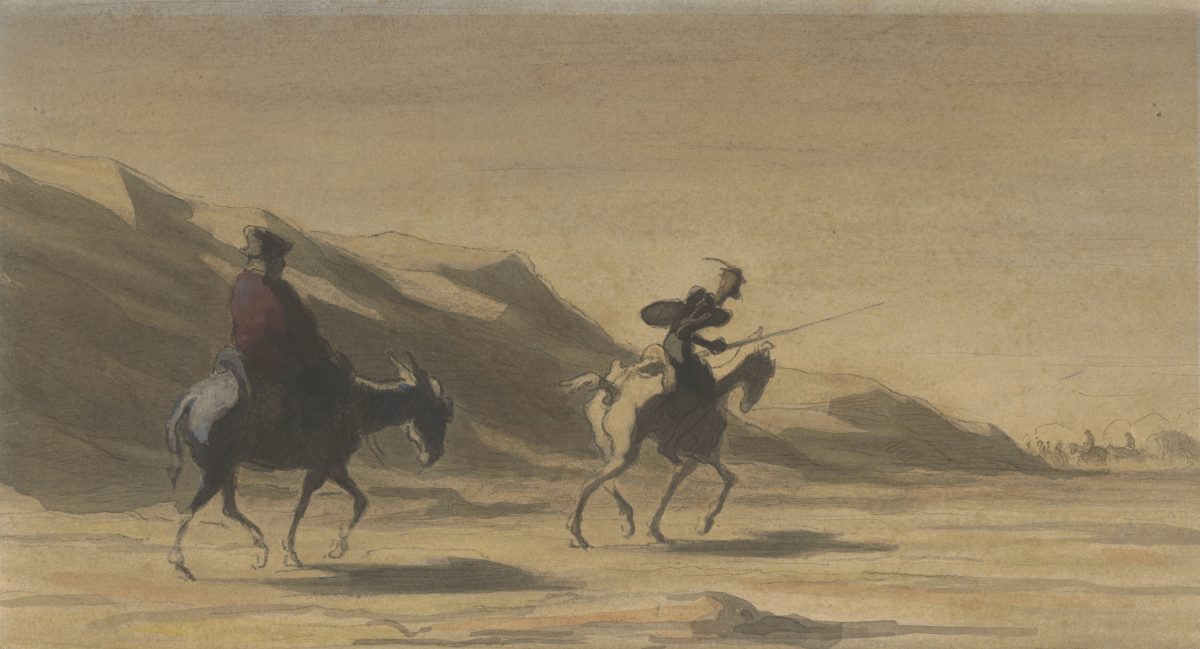
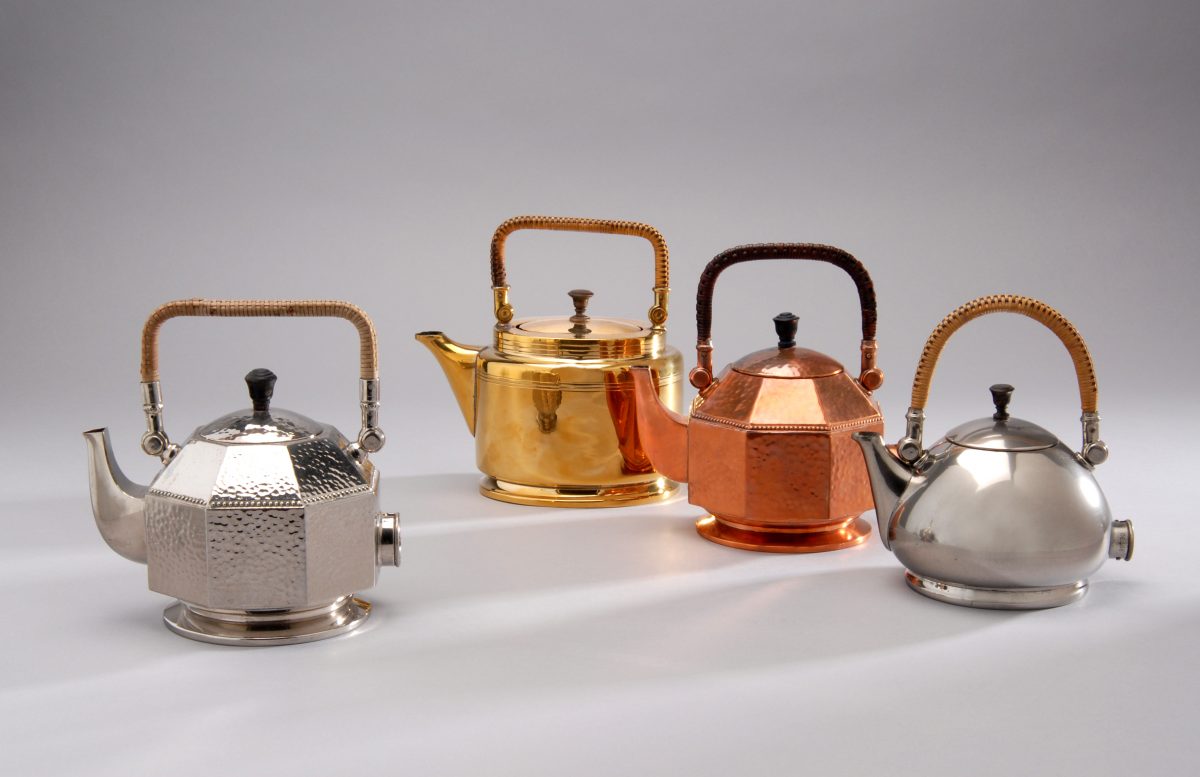
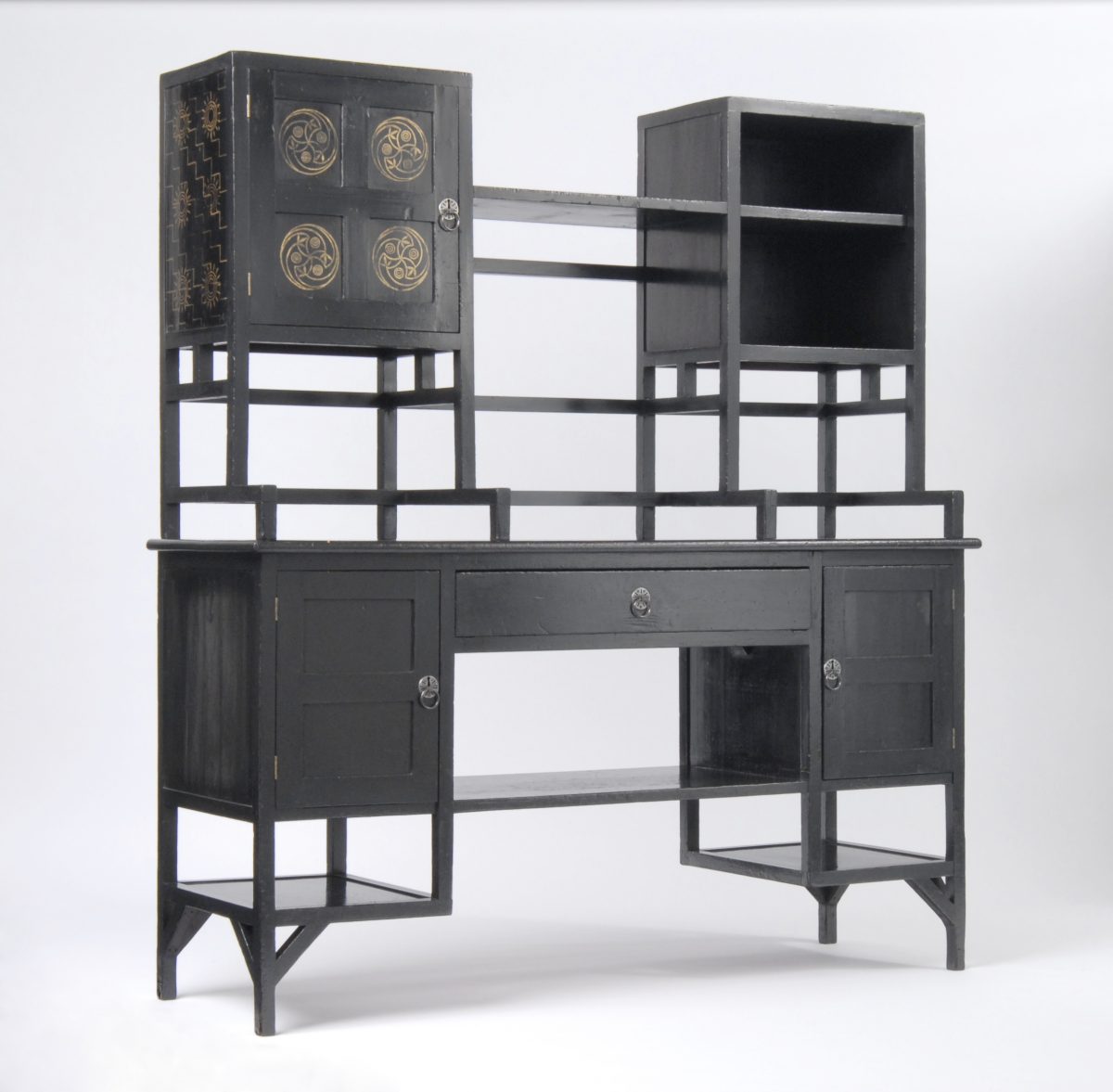
Künstler-Verzeichnis A-Z
- A
- Anni Albers
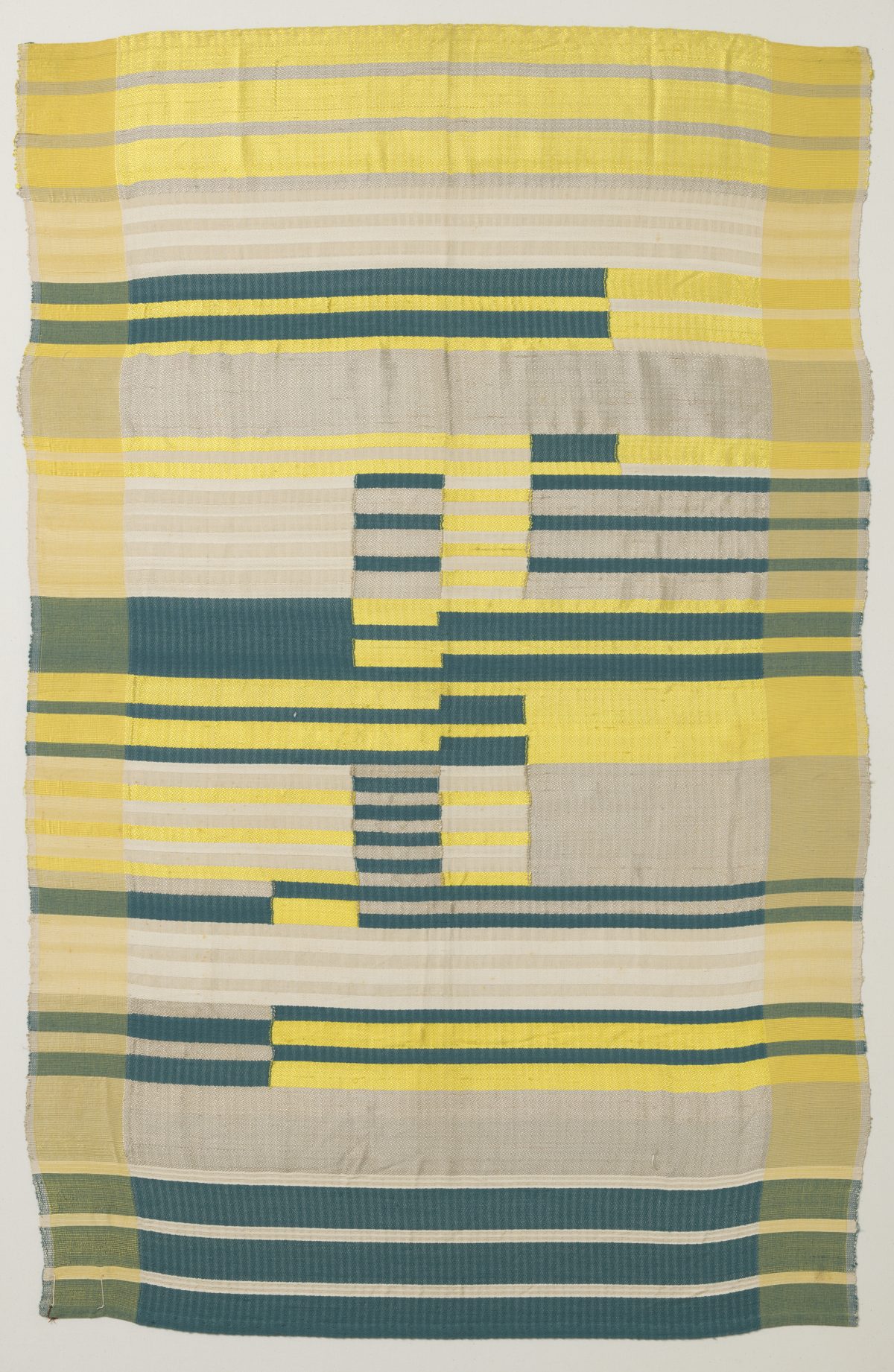 Albers, Anni, Wandbehang Nr. 81, 1925, Gewebe, Herst.: Staatliches Bauhaus, Dessau, Foto: Die Neue Sammlung — The Design Museum
Albers, Anni, Wandbehang Nr. 81, 1925, Gewebe, Herst.: Staatliches Bauhaus, Dessau, Foto: Die Neue Sammlung — The Design MuseumIllustrative of the new aesthetics of Bauhaus is the geo-metrically flattish design, which rigorously opposed the taste conventions that prevailed at that time. Examples of this are to be found in narrative-figural tapestry, which had experienced a new blossoming in the period of Jugendstil.
- Rudolf von Alt
1802 - 1905
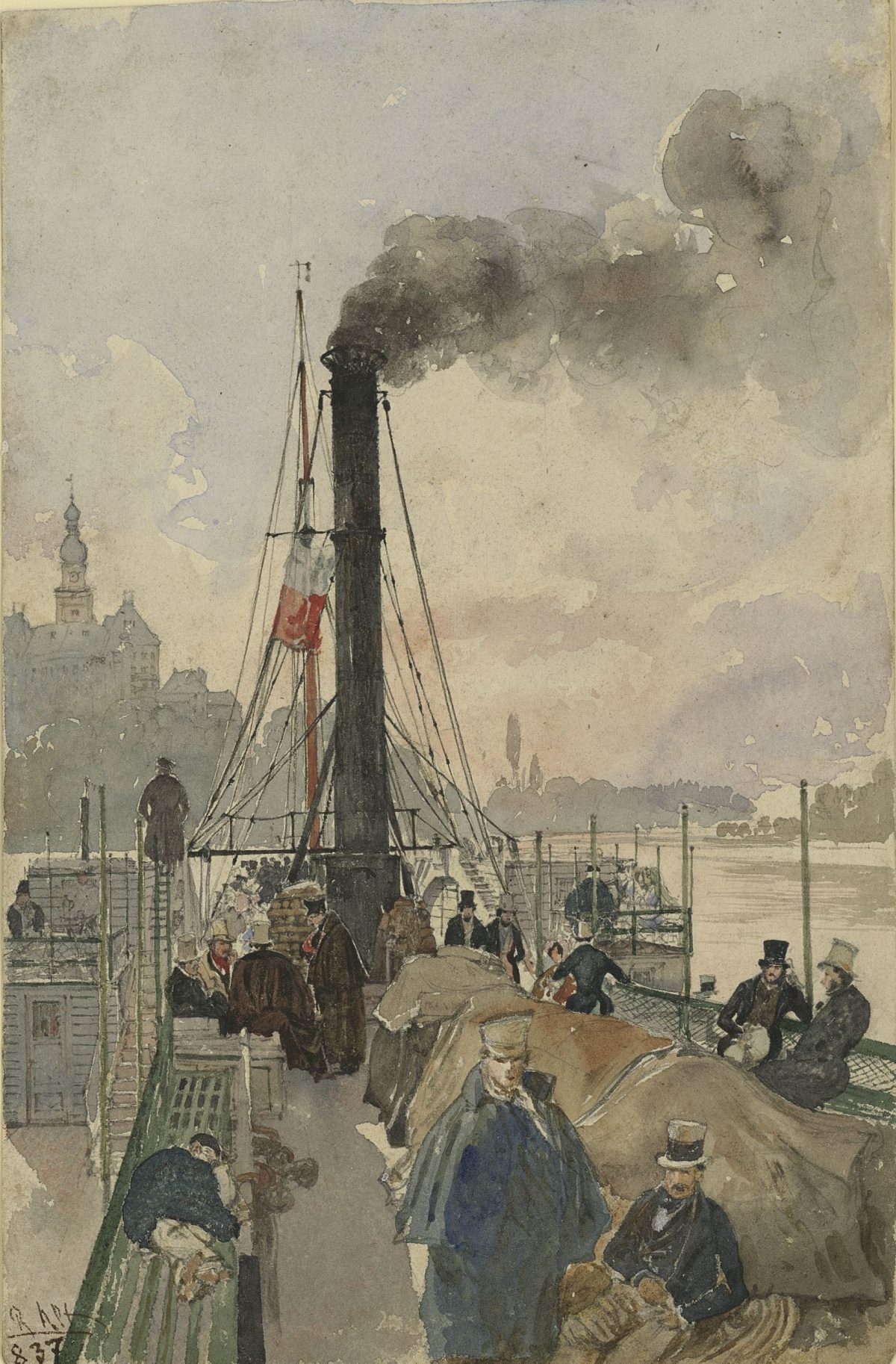
Rudolf von Alt, An Bord des Donaudampfers Maria Anna, 1837, Aquarell über Bleistift, 217 x 144 mm Blattmaß © Staatliche Graphische Sammlung München
-
- B
- Max Beckmann
1884 - 1950
Both the life and work of the German painter were shaped by the traumatic experiences he underwent during the First World War. In numerous self-portraits he explored in depth the effects of these on his person and psyche – and also on his social position. The drawing shown here, which he created during the war, allows the observer to share in the inner conflicts of the artist, whose facial features reflect the inhuman conditions that prevailed at the time and indicate Beckmann’s contempt for the world.
- Peter Behrens
1868 - 1940
 Behrens, Peter, Elektrische Wasserkessel, 1908/09, Metall, Rohrgeflecht, Herst.: AEG, Berlin, Foto: Die Neue Sammlung — The Design Museum, Herst.: AEG, Berlin, Foto: Die Neue Sammlung — The Design Museum
Behrens, Peter, Elektrische Wasserkessel, 1908/09, Metall, Rohrgeflecht, Herst.: AEG, Berlin, Foto: Die Neue Sammlung — The Design Museum, Herst.: AEG, Berlin, Foto: Die Neue Sammlung — The Design MuseumPeter Behrens is one of the pioniers of modern industrial design. His water kettle models for the company AEG are prime examples of rationalised production. With three basic types, three different kinds of material and surface treatments – together a selection of handles and spouts –he was able to produce numerous variations.
- Joseph Beuys
1921 - 1986
With his idea of social plastic the sculptor and graphic artist influenced art in the 20th century like practically no other. His drawings open up a perspective on his complex concept of art by serving as notes and ideas.
- Aenne Biermann
The declared aim of photographer Aenne Biermann was to achieve a ‘greater intimacy with things’. Using tight cropping, unconventional perspectives, and high-contrast lighting, she captured the detail and characteristic features of her subjects. Biermann used her lens to reveal the surprising, delightful charm of everyday phenomena. The candid childish gaze of Biermann’s daughter Helga is thus more than simply the subject of this photographic ‘View’ – it is at the heart of the photographer ’s approach to her work.
- Arnold Böcklin
1827 - 1901
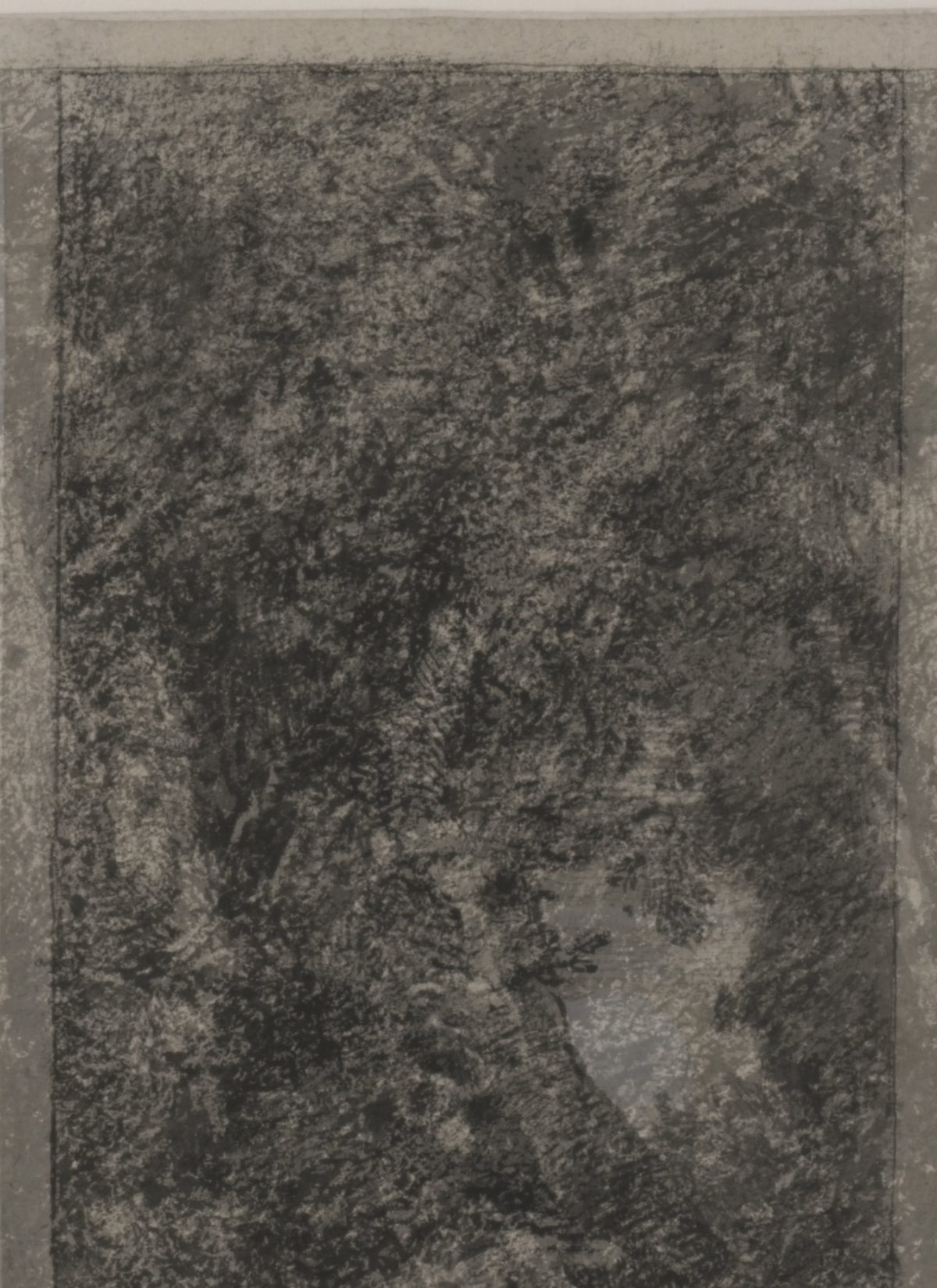
Arnold Böcklin, Das Irrlicht, um 1855/60, Feder und Pinsel in Schwarz, grau laviert, weiß gehöht, mit Federlinie umrandet, auf hellbräunlichem Papier, 280 x 206 mm Blattmaß © Staatliche Graphische Sammlung München
- Theodor Bogler
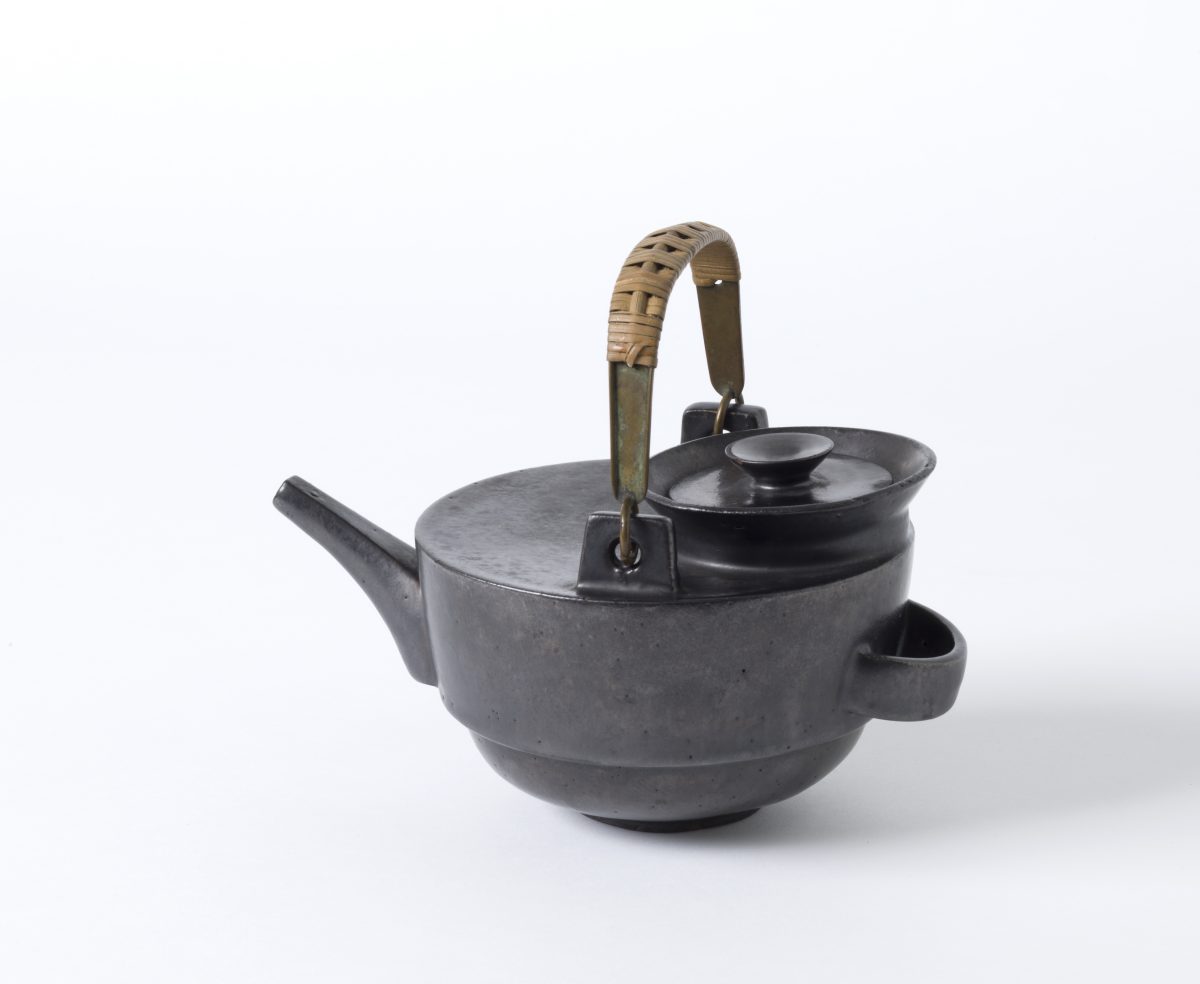 Bogler, Theodor, Kombinationsteekanne, 1923, Steinzeug, lasiert, Silber, Weidenschiene, Herst.: Staatliches Bauhaus, Töpferwerkstatt, Foto: Die Neue Sammlung — The Design Museum
Bogler, Theodor, Kombinationsteekanne, 1923, Steinzeug, lasiert, Silber, Weidenschiene, Herst.: Staatliches Bauhaus, Töpferwerkstatt, Foto: Die Neue Sammlung — The Design MuseumThe Combination Tea Pot of 1923 is one of the earliest works of Bauhaus created for industry (or for industrial series production). The individual basic elements of the teapot — graduated body, spout, lid, handle — could, in part, be prefabricated and combined with each other in a number of different ways that allowed for standardised types with possibilities of variation for inexpensive serial production. However, they remained valuable individual items, as they never went into series production.
- Pierre Bonnard
1867 - 1947
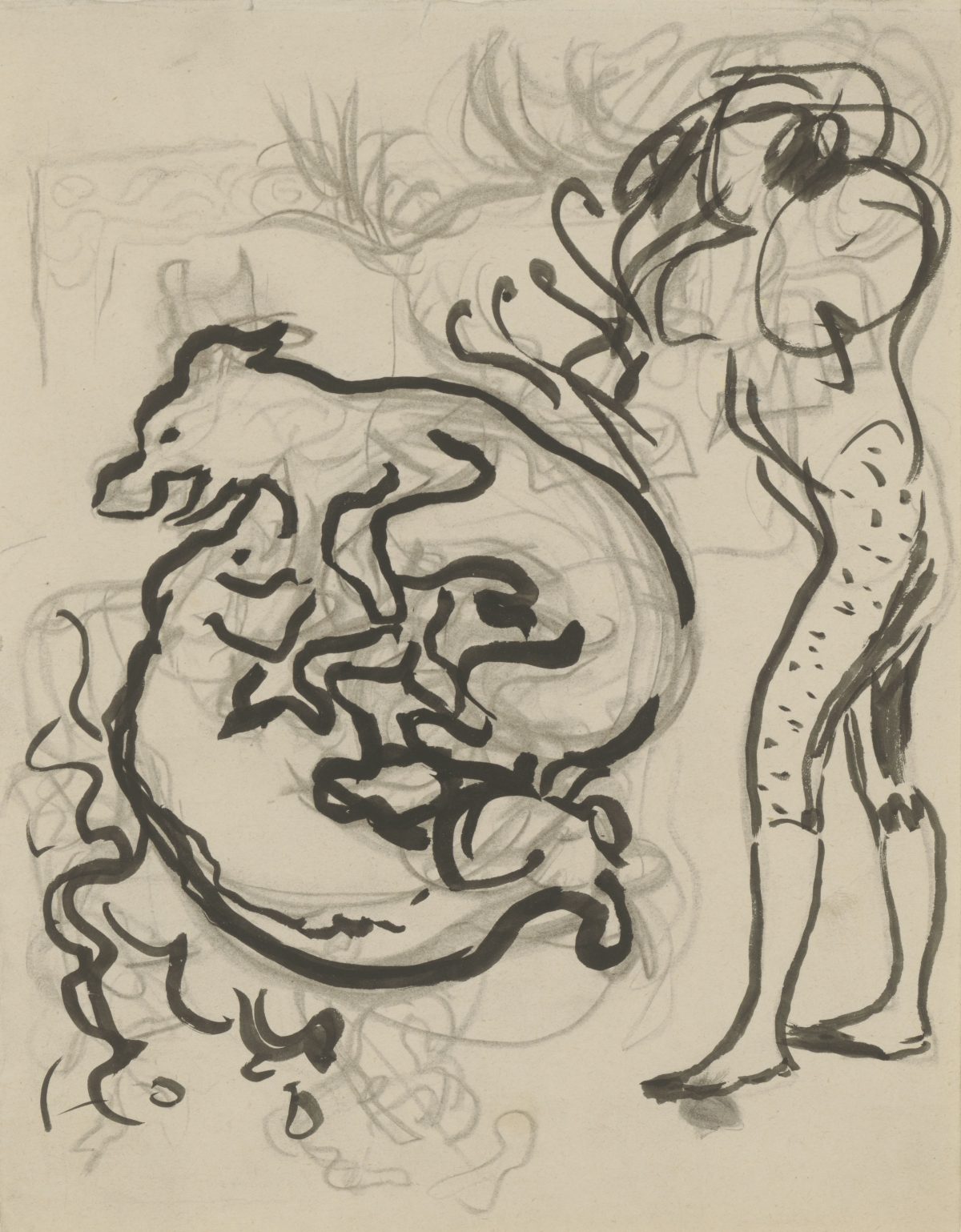
Pierre Bonnard, recto: Spielende Hunde und Figur; verso: Fragment einer Skizze, um 1891, Bleistift, Pinsel in Schwarz, 234 x 190 mm (unregelmäßig) Blattmaß © Staatliche Graphische Sammlung München
- (Gyula Halàsz) Brassaï
The photographer Brassaï wandered the streets of Paris by night, driven by fascination for the ‘world at the margins of our own’. This pushed him out into the streets and commercial establishments, and away from the splendid avenues and art monuments. Using photoplates, Brassaï captured impressions otherwise only seen by criminals, pimps, prostitutes, and their clients. Deep shadows, faces concealed in darkness, glances obscured or exchanged in reflective surfaces: these are all characteristic of his photographs. Even today, Brassaï ’s pictures have considerable influence on our image of seedy Parisian milieus of the 1930s.
- Marcel Breuer
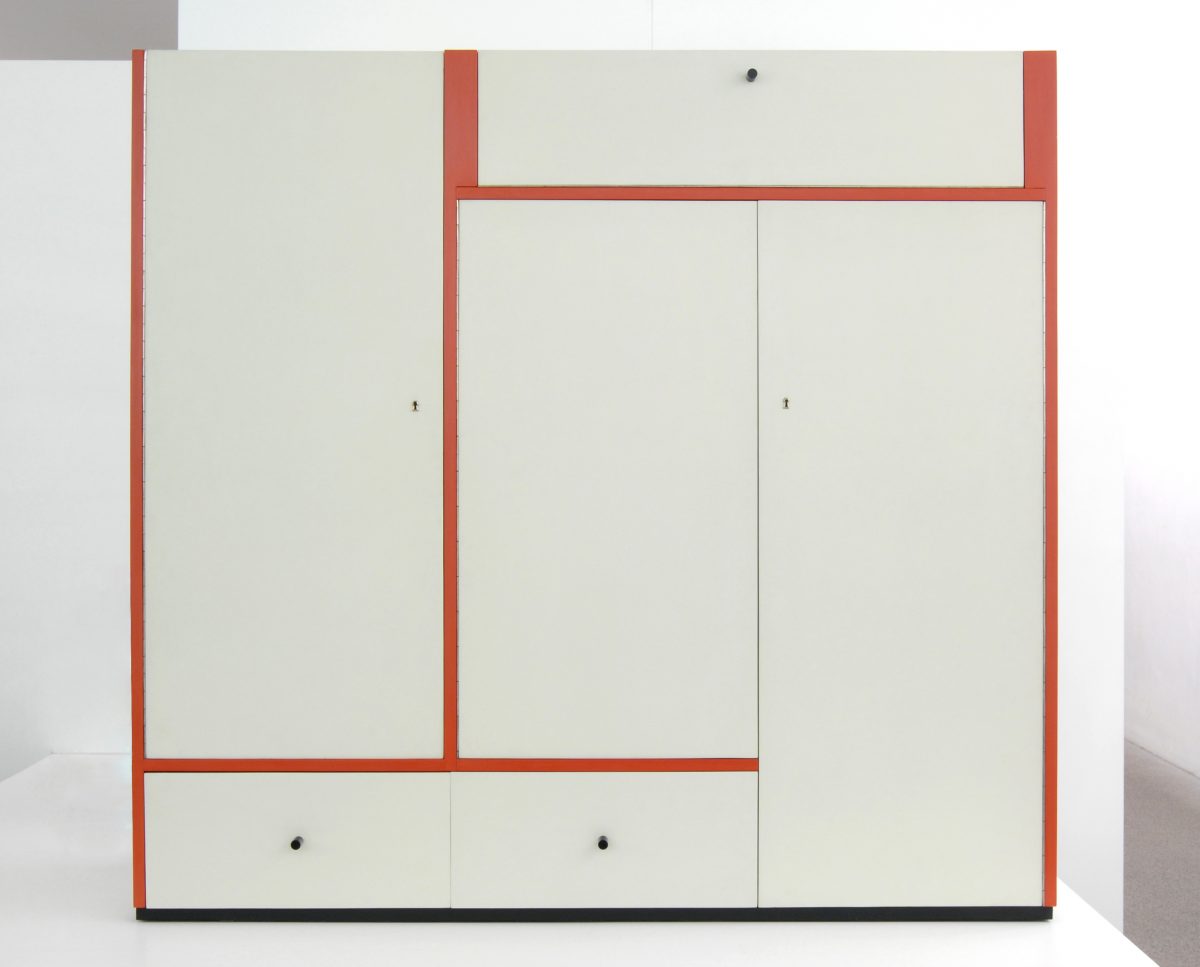 Breuer, Marcel, Kleiderschrank ti 113, 1925/26, Holz, lackiert, Herst.: Staatliches Bauhaus, Dessau, Foto: Die Neue Sammlung — The Design Museum
Breuer, Marcel, Kleiderschrank ti 113, 1925/26, Holz, lackiert, Herst.: Staatliches Bauhaus, Dessau, Foto: Die Neue Sammlung — The Design MuseumBright, uniform varnished surfaces form an effective contrast to the constructive scaffold of thin, red strips. Form and function combine here to create an exciting unity that comes close to the formal quality of an abstract painting.
- Wilhelm Busch
1832 - 1908
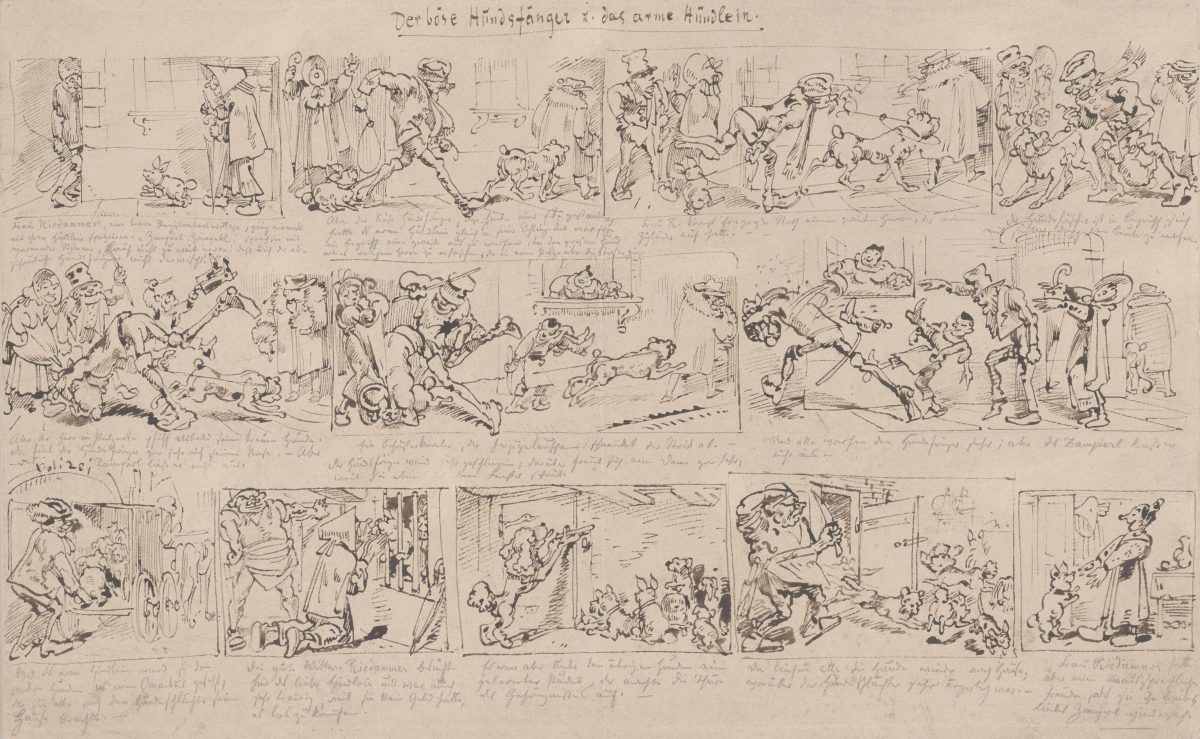
Wilhelm Busch, 1832 - 1908, Der böse Hundefänger und das arme Hündlein, um 1866, Bleistift, Feder in Braun, Beschriftung: Bleistift, 280 x 447 mm Blattmaß © Staatliche Graphische Sammlung München
-
- C
- Paul Cézanne
1839 - 1906
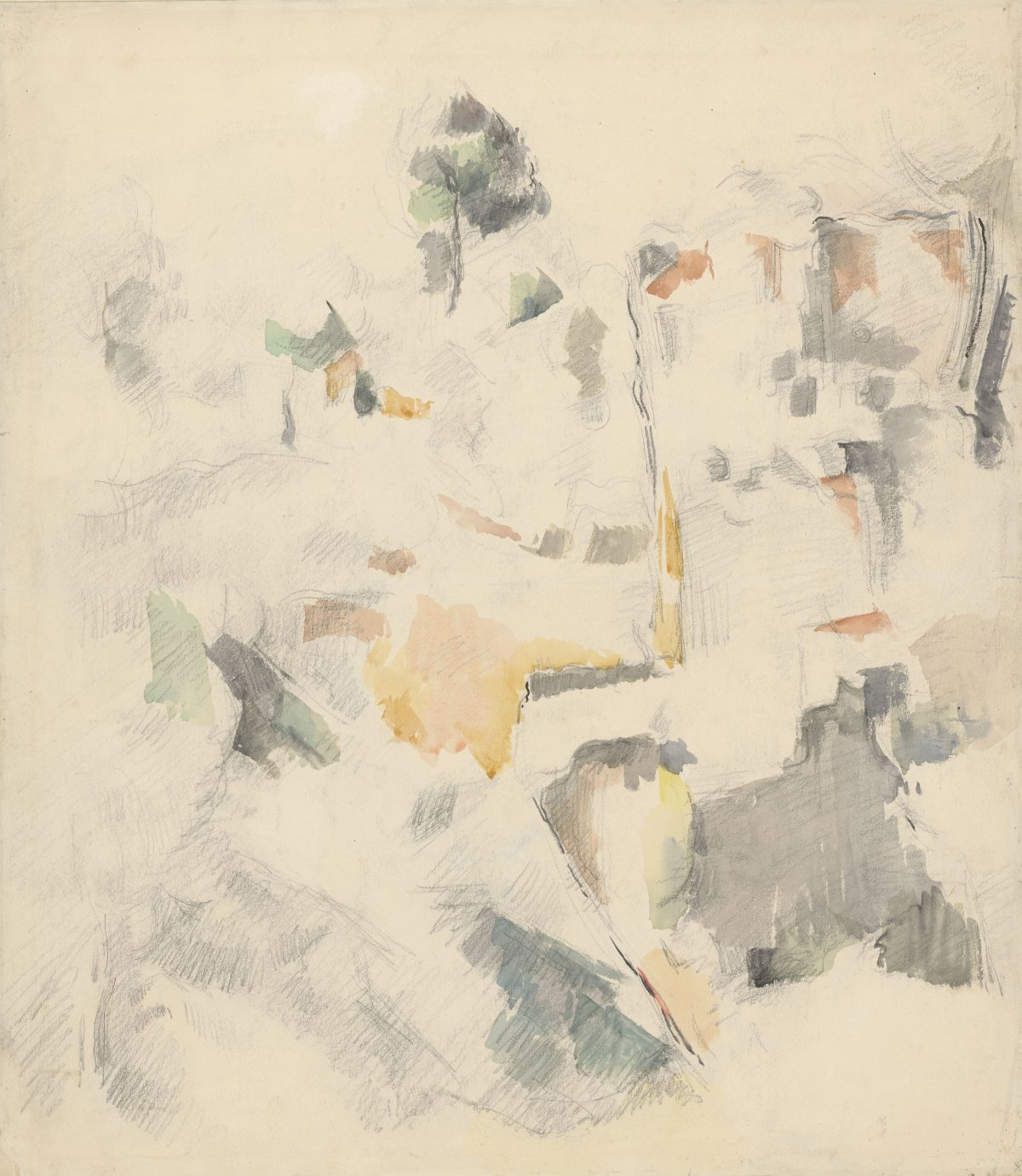
Paul Cézanne (Cezanne), Steilhang mit Pinie (Felsen von Bibémus), 1895 - 1898, Aquarell über Bleistift, 475 x 415 mm Blattmaß © Staatliche Graphische Sammlung München
- Eduardo Chillida
1924 - 2002
Chillida is ranked as one of the most significant sculptors of the 20th century. He made his understanding of form and its relationship to space the subject of discussion in his works on paper. And these went on to become a block of works in their own right within his oeuvre.
- Larry Clark
Dead 1970 is part of the groundbreaking photo series Tulsa, which documents the drugfilled, violent lives of youths in Larry Clark’s hometown in Oklahoma. Himself part of the group and addicted to drugs, the photographer introduces us to a subculture which is located outside of the 1960s American ideals of either the single-family household or ‘flower power’. The images are created in the style of a photo diary and confront the viewer with weapons, heroin needles, gunshot wounds, sex, and death. Their intimacy and directness were shocking and they set new standards for coming generations of photographers for what photography could show.
-
- D
- Honoré Daumier
1808 - 1879
 Honoré Daumier, Don Quijote und Sancho Panza, um 1878, Aquarell, Bleistift, Conté-Kreide (am Rand Pinsel-, Kreide- und Federproben), 202 x 281 mm Blattmaß © Staatliche Graphische Sammlung München
Honoré Daumier, Don Quijote und Sancho Panza, um 1878, Aquarell, Bleistift, Conté-Kreide (am Rand Pinsel-, Kreide- und Federproben), 202 x 281 mm Blattmaß © Staatliche Graphische Sammlung MünchenHonoré Daumier, Don Quijote und Sancho Panza, um 1878, Aquarell, Bleistift, Conté-Kreide (am Rand Pinsel-, Kreide- und Federproben), 202 x 281 mm Blattmaß © Staatliche Graphische Sammlung München
- Eugène Delacroix
1798 - 1863
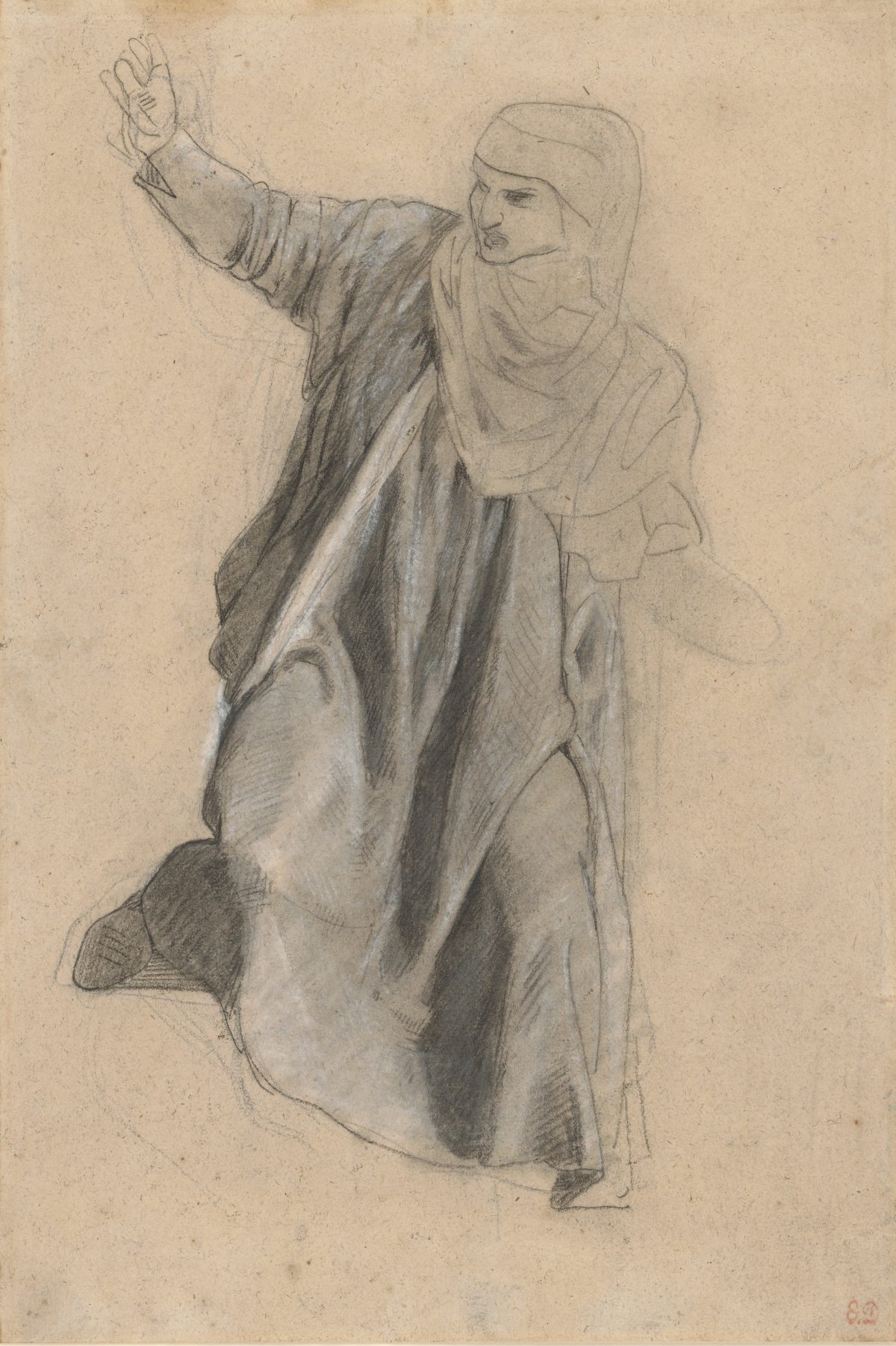
Eugène Delacroix, Studie zu „Die Dantebarke“, 1821 - 1822, Bleistift und Kreide, 407 x 274 mm Blattmaß © Staatliche Graphische Sammlung München
- Johann Georg von Dillis
1759 - 1841
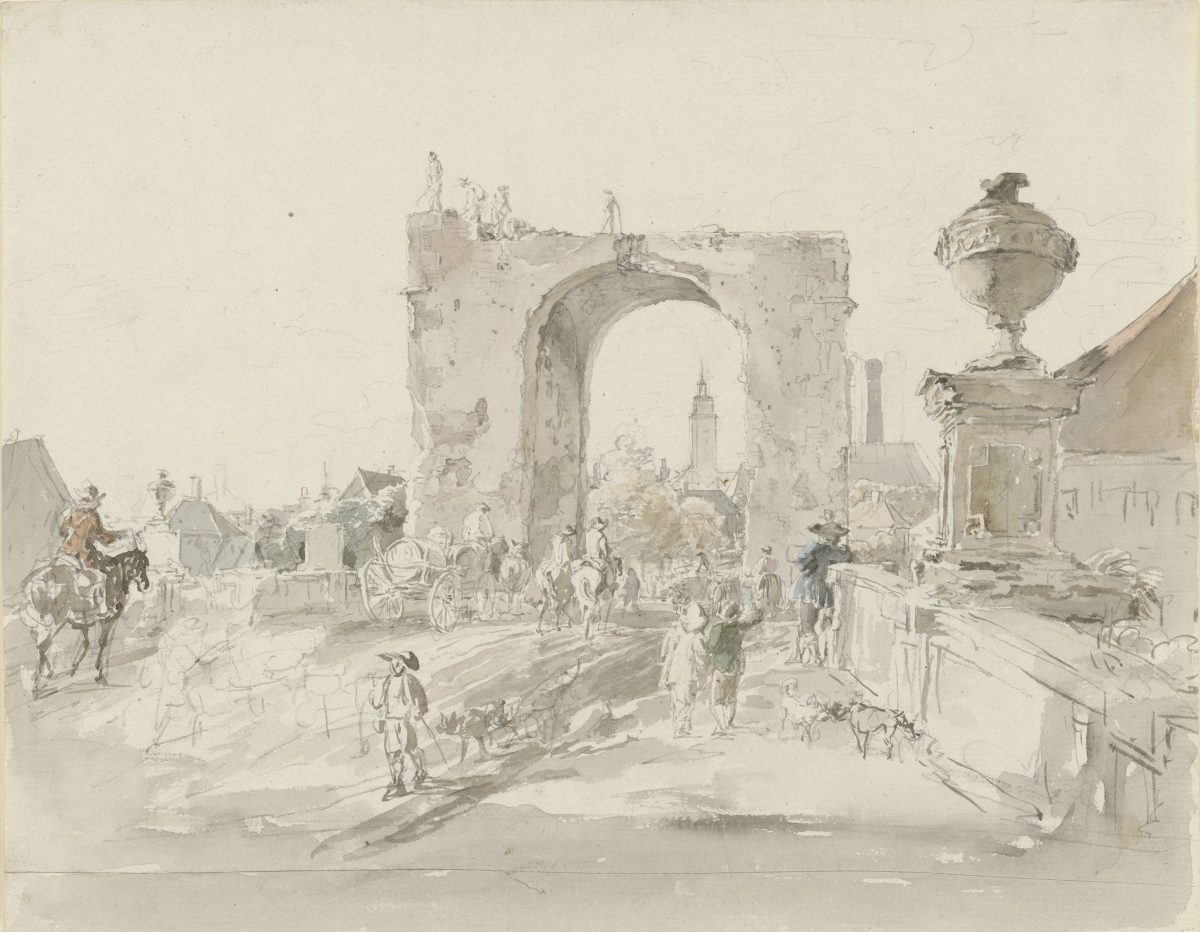
Johann Georg von Dillis, Abbruch des Roten Turmes in München, 1796, Bleistift, aquarelliert, 225 x 289 mm Blattmaß © Staatliche Graphische Sammlung München
- Peter Doig
Behind the man in the top hat a bright green landscape rises up like a high wall bearing the outlines of imaginary images. The figure’s clothing is reminiscent of the 19th century, making him look as if he has ‘fallen out of time’. The tropical environment also contributes to this atmosphere of strangeness. Metropolitain is based on Honoré Daumier ’s portrayal of a man looking at art (L’amateur d’estampes). Every picture, the painting tells us, is made up of things we have already seen and is capable of suggesting new images.
-
- E
- Charles & Ray Eames
The “Leg Splint" is a functional object with the lightness and grace of a sculpture. Ray & Charles Eames designed it for die US-American Navy, which had no suitable leg splints for its war-wounded. What they created was, on the one hand, a utility item but, at the same time, a fantastic design: a lightweight wooden object, leg re-shaping and with its numerous openings for secure fixing one that comes very close to being a modern sculpture.
- Olafur Eliasson
1967
 Olafur Eliasson, Spheres of power and care, 2016, Aquarell, Tusche und Bleistift, ca. 210 x 275 mm © Olafur Eliasson
Olafur Eliasson, Spheres of power and care, 2016, Aquarell, Tusche und Bleistift, ca. 210 x 275 mm © Olafur EliassonMit seinen in engem Verhältnis zur Naturwissenschaft stehenden Kunstwerken, hat sich der isländisch-dänische Künstler seit den 1990er-Jahren als wichtige Größe in der internationalen Kunstwelt etabliert. Seine Arbeiten erwecken eine oftmals durch physikalische Phänomene hervorgerufene visuelle und sensuelle Faszination, die eines tiefergreifenden Sinngehalts nicht entbehrt.
- Slawomir Elsner
1976
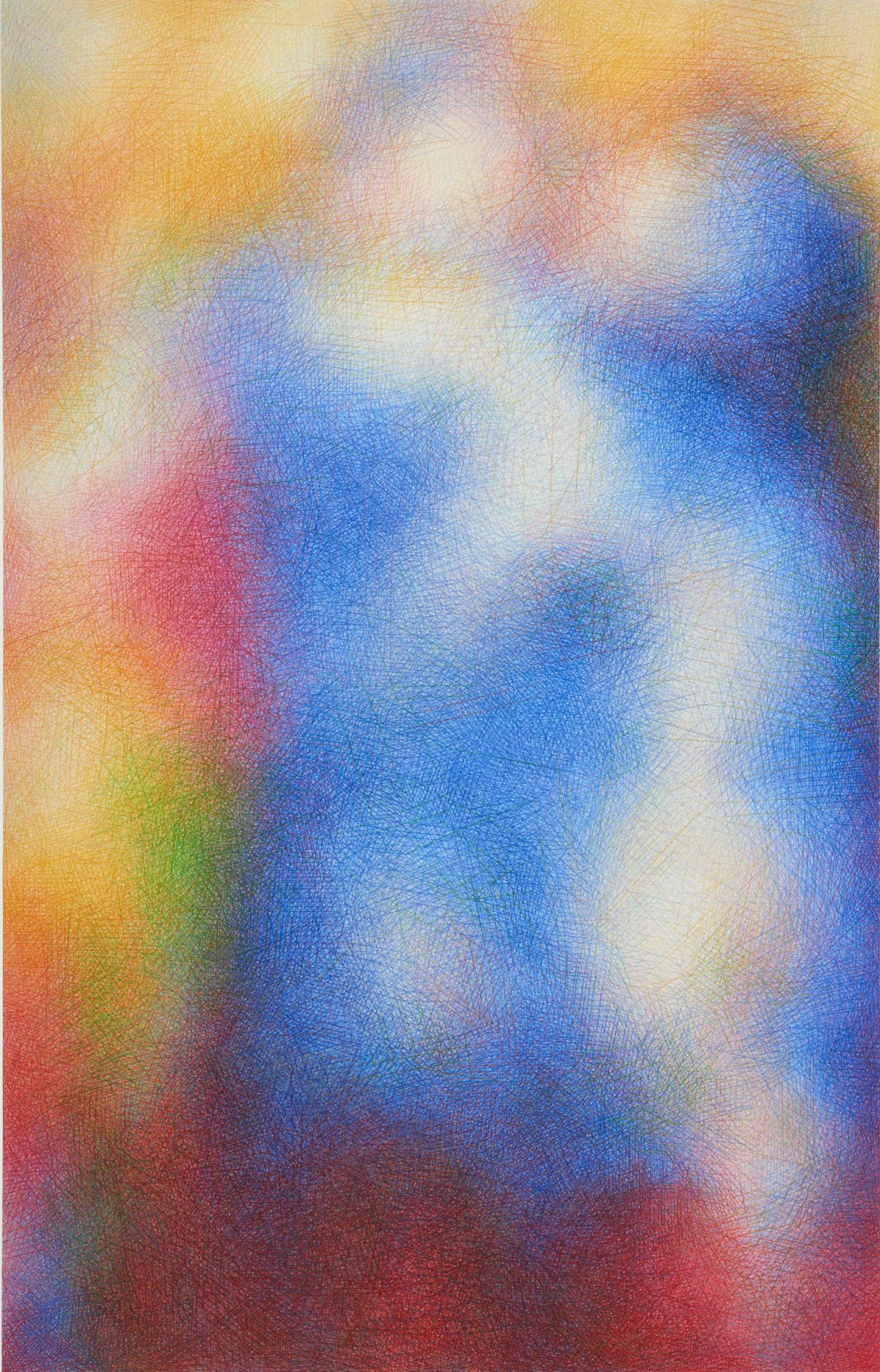 Slawomir Elsner, Der Turm der blauen Pferde (nach Franz Marc, 1913), 2016, Farbstift auf Papier, 2000 x 1300 mm © Staatliche Graphische Sammlung München
Slawomir Elsner, Der Turm der blauen Pferde (nach Franz Marc, 1913), 2016, Farbstift auf Papier, 2000 x 1300 mm © Staatliche Graphische Sammlung MünchenElsners tafelbildartige Zeichnungen beeindrucken durch ihre technische Virtuosität. In feinen Strichen konstruiert er nach photographischen Vorlagen mit Farbstift abstrakte Adaptionen berühmter Gemälde. Dabei lässt gerade die absichtsvolle Unschärfe die Graphiken zu eigenständen Werken werden mit offenen Assoziationsfeldern, die mit dem Erinnern und Wiedererkennen von bekannten Meisterwerken spielen, und so neue Betrachtungsangebote stellen.
- James Ensor
1860 - 1950
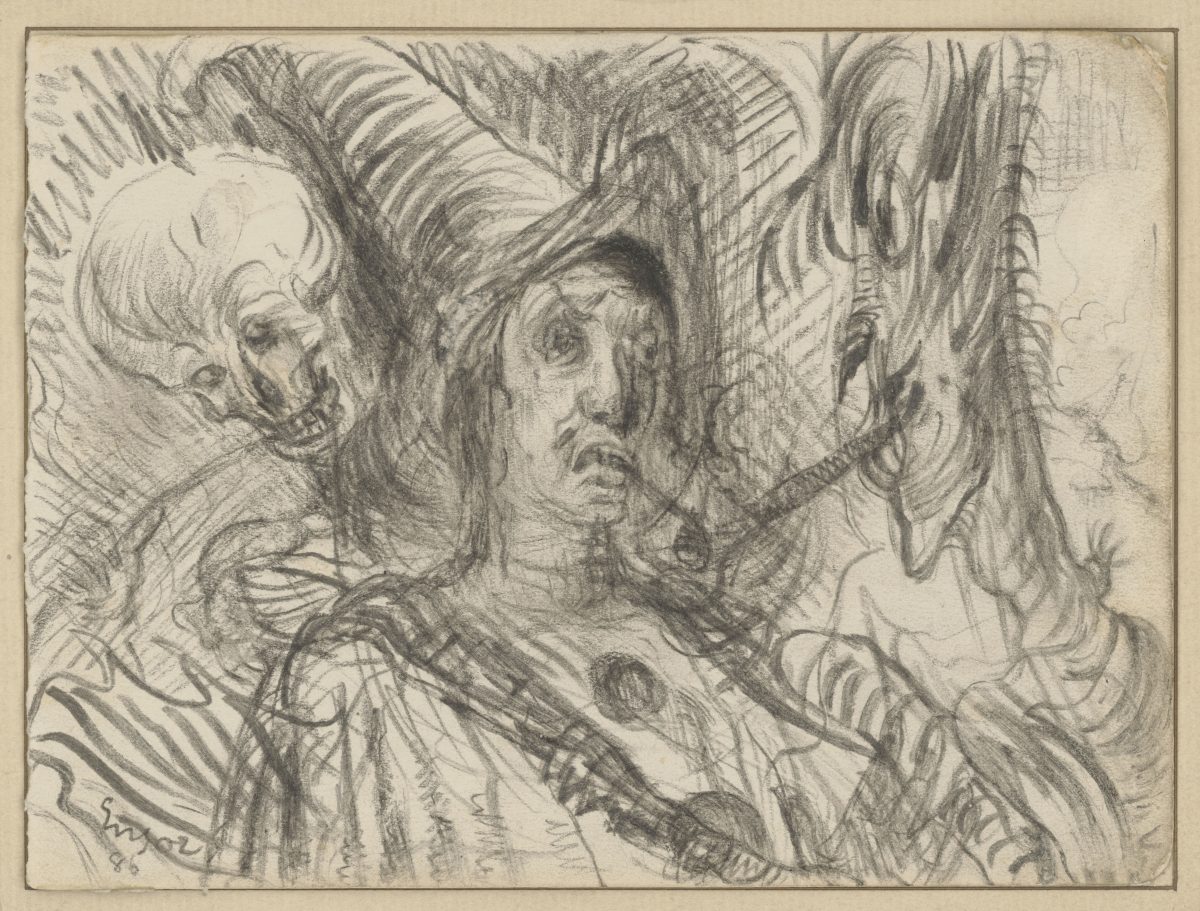
James Ensor, recto: Maskenball (Le sablier); verso: verworfene Studie mit Köpfen, 1886, Schwarzer Stift und schwarze Fettkreide, 128 x 173 mm Blattmaß © Staatliche Graphische Sammlung München
-
- F
- Anselm Feuerbach
1829 - 1880
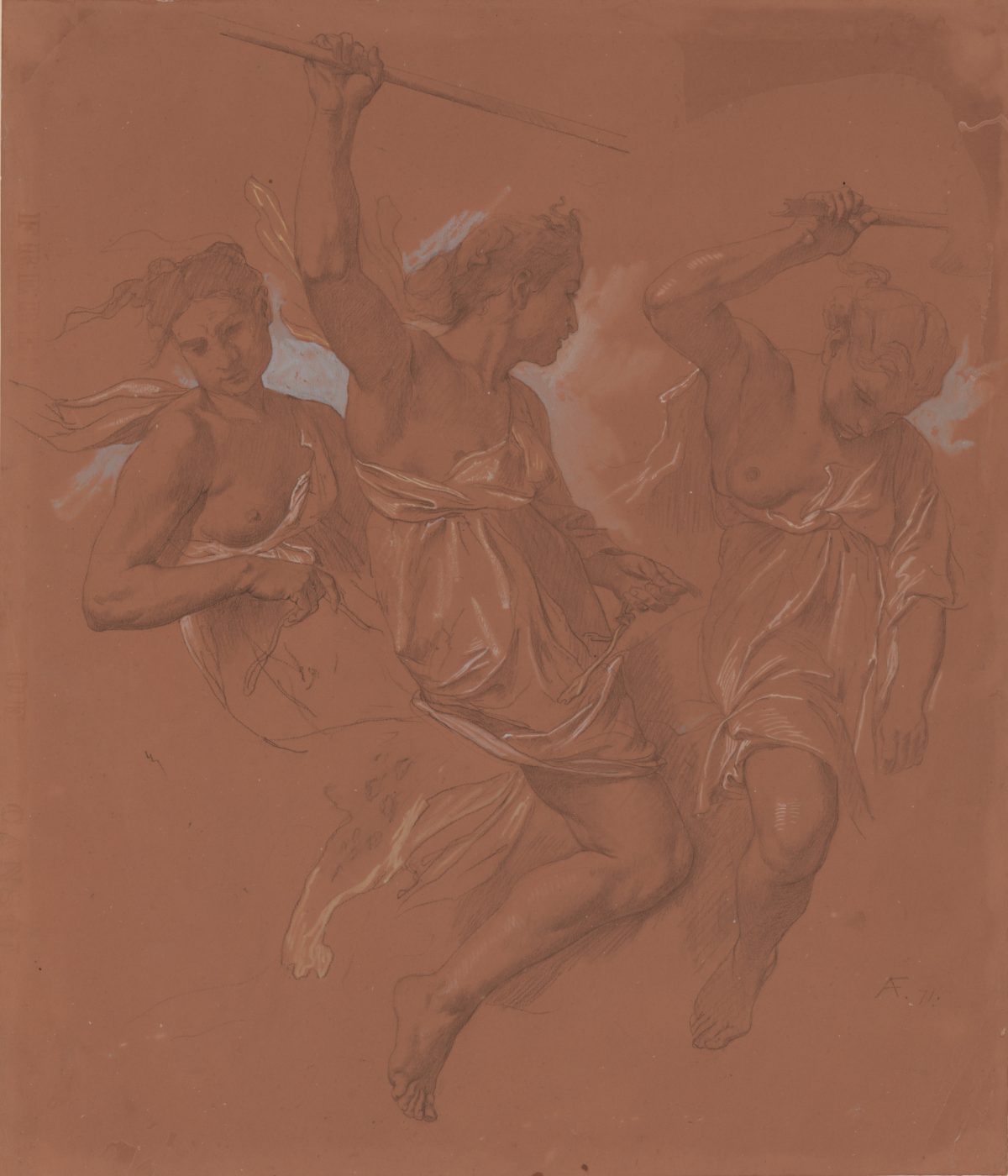
Anselm Feuerbach, Drei reitende Amazonen, 1871, Schwarze und farbige Kreiden, Deckfarbe in Hellblau, 504 x 432 mm Blattmaß © Staatliche Graphische Sammlung München
- Carl Philipp Fohr
1795 - 1818
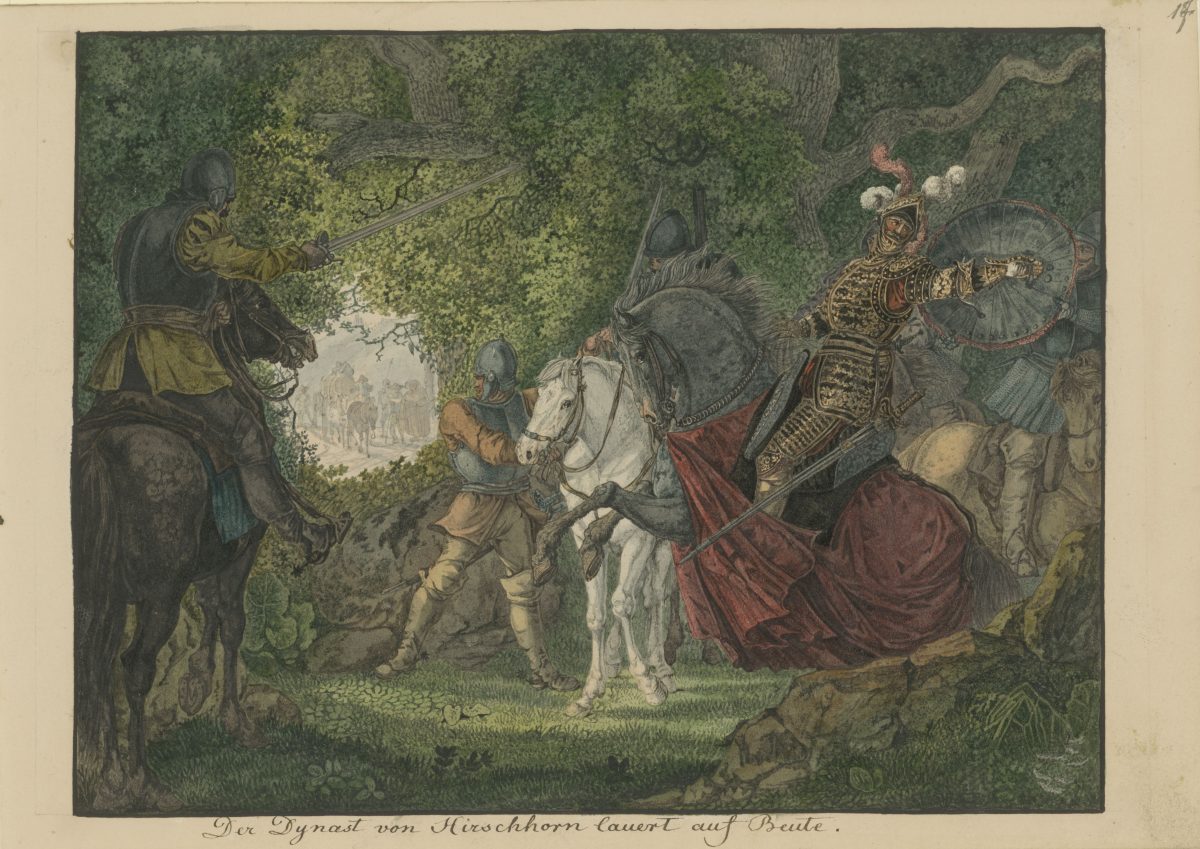
Carl Philipp Fohr, Der Dynast von Hirschorn lauert auf Beute, 1813 - 1814, Bleistift, Aquarell, 181 x 239 mm Blattmaß © Staatliche Graphische Sammlung München
- Lucio Fontana
1899 - 1968
Fontana’s work, well known in particular for his slit-open canvasses, stands for space art that unifies diverse artistic genres with, in part, metaphysical charm. The idea of a link between art and real space continued into the 1950s and 1960s through art groups such as the German Zero-Movement and the French Nouveau Réalisme.
- Helen Frankenthaler
1928 - 2011
Frankenthaler ist eine führende Künstlerin des Abstrakten Expressionismus der zweiten Generation. Anders als bei vielen ihrer Kollegen weist ihr Werk noch einen gewissen Bezug zu gegenständlichen Motiven, allen voran zur Landschaftsmalerei, auf.
- Otto Freundlich
1878 - 1943
 Otto Freundlich, Composition autour de deux plans noir et gris, 1942, Gouache, 169 x 122 mm © Staatliche Graphische Sammlung München
Otto Freundlich, Composition autour de deux plans noir et gris, 1942, Gouache, 169 x 122 mm © Staatliche Graphische Sammlung MünchenThe Jewish theoretician and artist Otto Freundlich was an intellectual mentor of socially oriented art, the aim of which was to remove social barriers and create forms of coexistence between people based on humanistic standards. But both his work and he as a person were also synonymous with the condemnation of the artist through National Socialism and correspondently defamed and pursued. The work on show here was created a year before his deportation and subsequent murder.
- Caspar David Friedrich
1774 - 1840
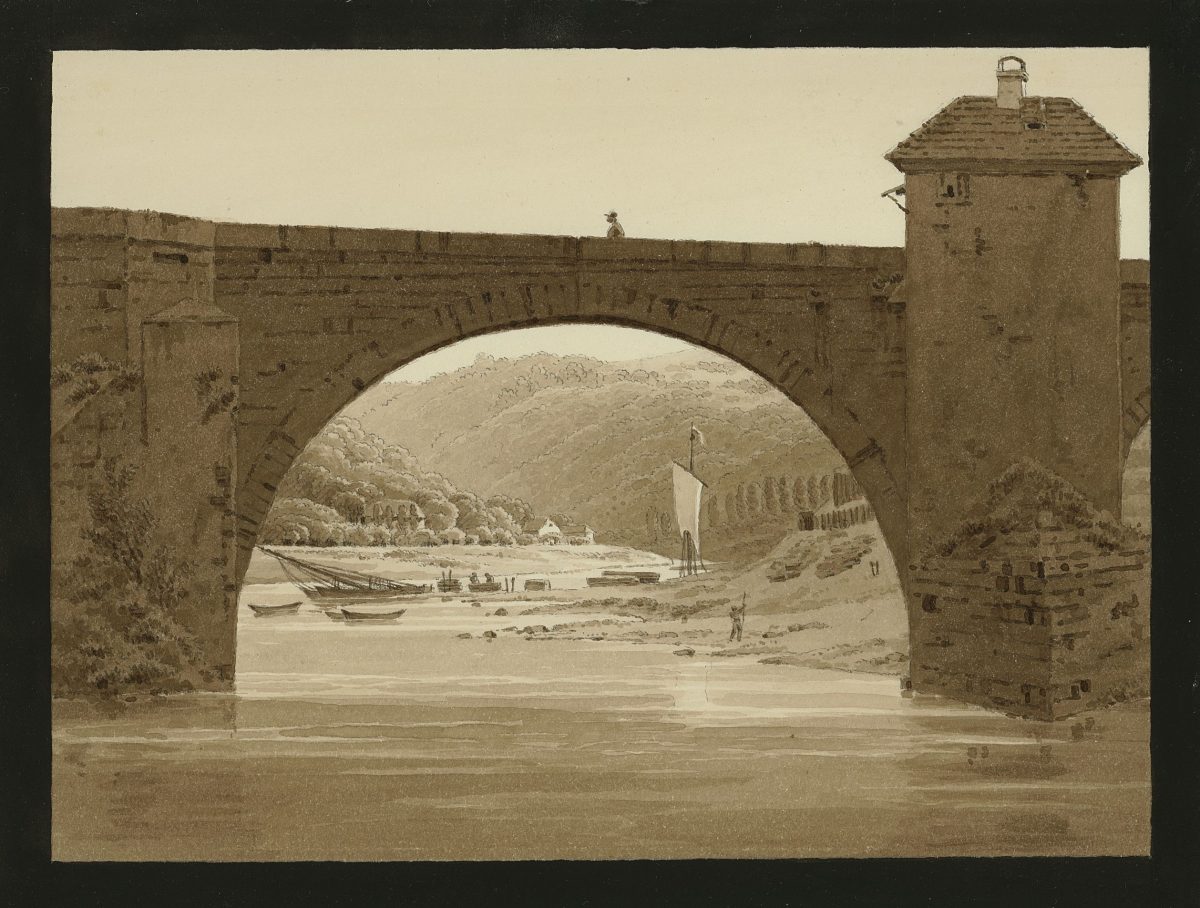
Caspar David Friedrich,Alte Elbbrücke bei Meißen, um 1816 Lt. Inventar 65: "Flusslandschaft mit Steinbrücke", Bleistift, Pinsel in Braun, schwarz umrandet
164 x 215 mm Blattmaß, 144 x 194 mm Darstellung © Staatliche Graphische Sammlung München
-
- G
- Isa Genzken
1948
Seit den 1970er-Jahren hat Genzken mit ihren unkonventionellen Arbeiten neue Maßstäbe in der Bildhauerei gesetzt. Das sehr frühe Münchner Blatt aus einer singulären Suite von sieben gibt bereits einen Verweis darauf, wie radikal die Künstlerin in den folgenden Jahren den etablierten Formenkanon der bildenden Kunst befragen und sprengen sollte. Es ist zugleich als eine kritische Reaktion auf die US-amerikanische Kunst – oszillierend zwischen buntem Pop und zurückhaltendem Minimal – und als eine subversiv-spielerische Antwort auf die gestalterischen Prinzipien des Informel zu verstehen.
- Théodore Géricault
1791 - 1842
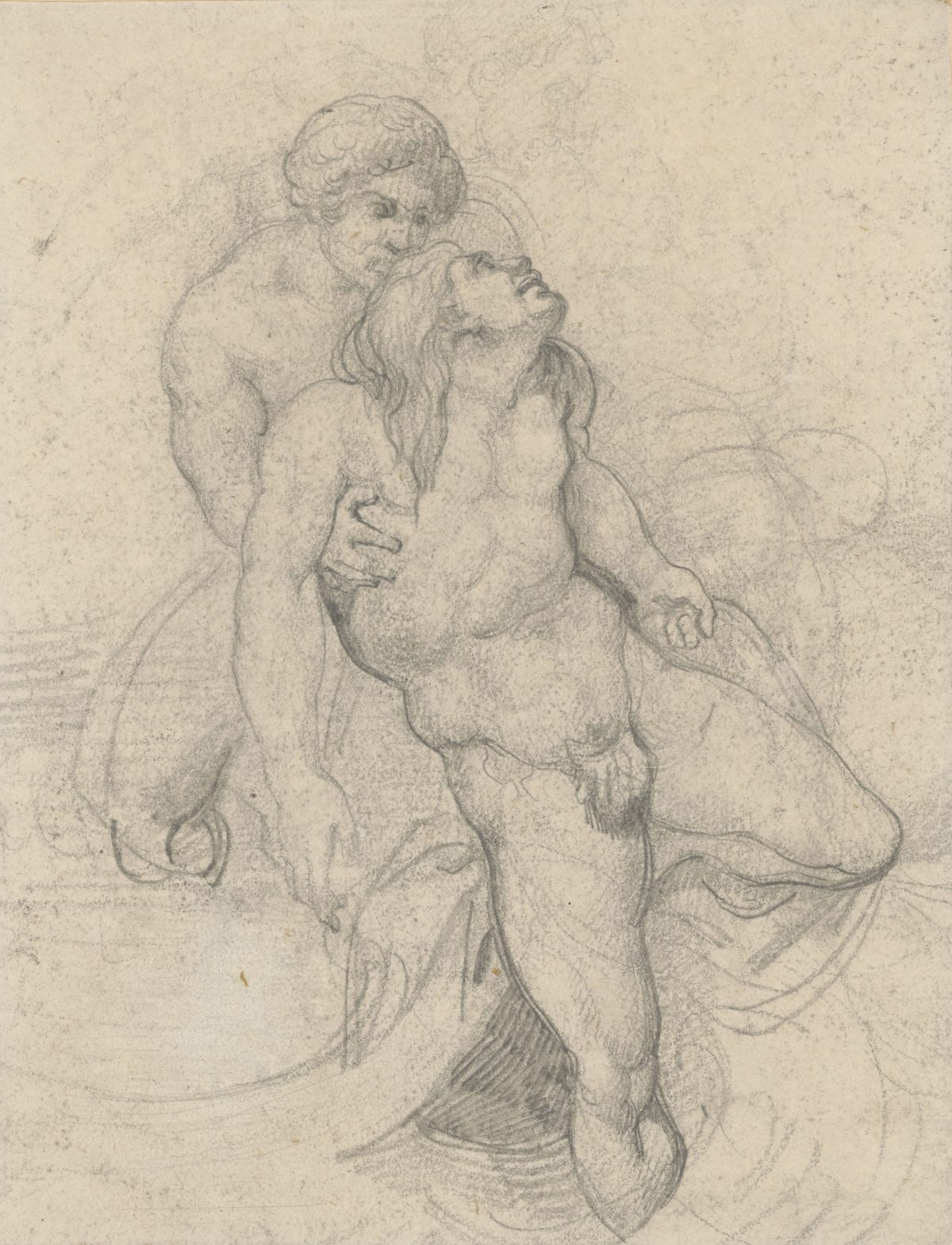
Théodore Géricault, Studie zu „Das Floß der Medusa“, 1818, Bleistift, 231 x 179 mm Blattmaß © Staatliche Graphische Sammlung München
- Hermann Glöckner
1889 - 1987
It is only in the past two decades that the work of the Dresden sculptor, painter and graphic artist has been discovered beyond his sphere of activity –an oeuvre that circulates equally between figuration and abstraction. Today his works must be ranked among the most important positions in the field of German classical modernism. His plate work belongs to the most important artistic-conceptual creations of the Moderne.
- Edward William Godwin
1833 - 1886
 Sideboard, um 1867, Herst.: William Watt, London, Foto: Die Neue Sammlung — The Design Museum, Erworben mit Unterstützung der Ernst von Siemens Kunststiftung
Sideboard, um 1867, Herst.: William Watt, London, Foto: Die Neue Sammlung — The Design Museum, Erworben mit Unterstützung der Ernst von Siemens KunststiftungEdward William Godwins Möbel entstand unter dem Einfluss japanischer Kunst, das sich durch strenge Grundform, durch Verbindung von Einfachheit und ästhetischer Raffinesse sowie durch Verzicht auf jegliche plastische Applikation grundlegend von den gleichzeitigen historistischen Möbeln unterscheidet.
- Vincent van Gogh
1853 - 1890
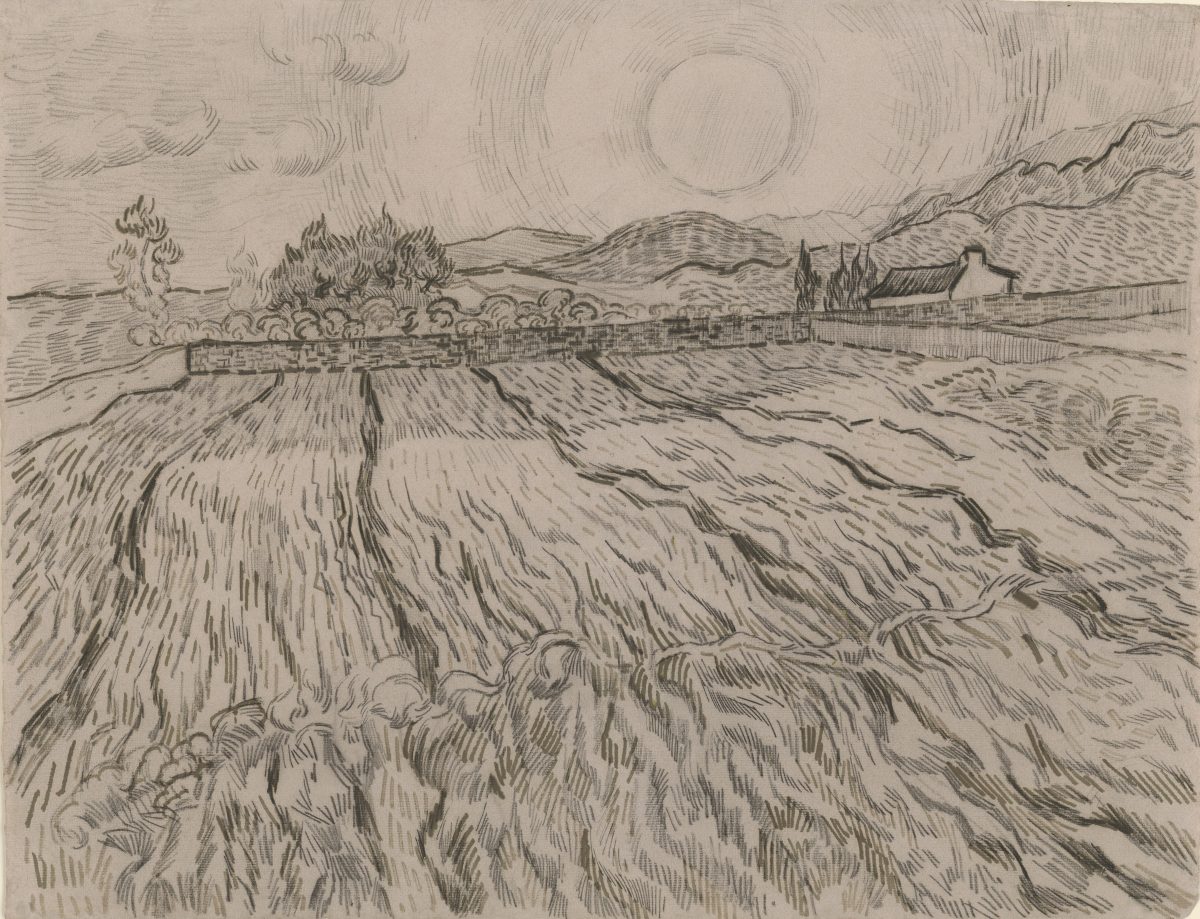
Vincent van Gogh, Weizenfeld mit aufgehender Sonne, 1889, Schwarze Kreide und Rohrfeder in Braun, 474 x 620 mm Blattmaß © Staatliche Graphische Sammlung München
- Dan Graham
This work offers us two views from a typical American diner, where a family is on their Sunday outing. Through the windows, which are set up like wide-screen panoramas, we can see a highway lined with prefab buildings in a suburb in the middle of nowhere. A place for moving through, not for staying. Public interiors and urban spaces have been central topics within photography since its beginnings. As places where past and present, as well as community and individual, interact, they provide a kaleidoscopic view on the state of society.
- Konstantin Grcic
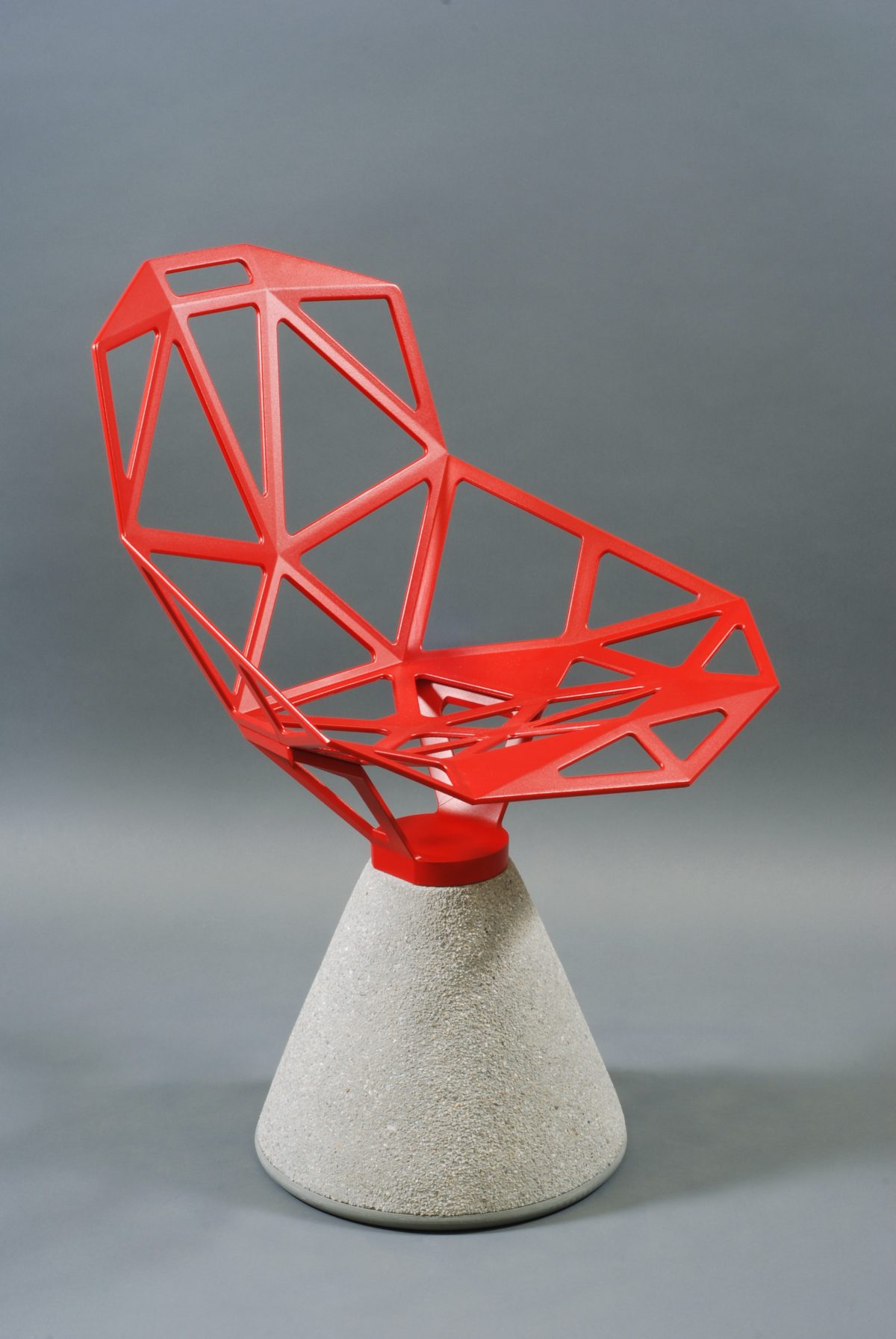 Grcic, Konstantin, chair_ONE, 2004, Metall (Aluminium), gegossen, rot lackiert, Beton, grau, Herst.: Magis srl., Italien, Foto: Die Neue Sammlung — The Design Museum
Grcic, Konstantin, chair_ONE, 2004, Metall (Aluminium), gegossen, rot lackiert, Beton, grau, Herst.: Magis srl., Italien, Foto: Die Neue Sammlung — The Design MuseumMit dem Chair One entwickelte Konstantin Grcic ein kantiges Netzwerk aus Aluminiumstreben, dessen kristalline Ästhetik an die Gitternetzkonstruktionen grober digitaler Renderings in CAD-Programmen erinnert. Entsprechend thematisiert der Chair One auch das Verhältnis zwischen digitalen und analogen Gestaltungsprozessen. Tatsächlich ist der Stuhl ist das Resultat intensiver gestalterischer Forschungsarbeit über die Materialeigenschaften und strukturelle Logik des Aluminiums.
- Andreas Gursky
Rhine II is a modern representation of a river that has served a crucial role in forging Germany’s identity, myths, and visual clichés. A view captured on location has been digitally manipulated so that the viewer perceives a nearly monochrome image composed of greyish-green colour fields. Dipped into a leaden seriousness, the current’s flow is relieved of its temporality, simultaneously taking on a crystalline presence and an inapproachability. Andreas Gursky wanted to formulate a contemporary picture of the Rhine. He found reality insufficient for his purposes and therefore found this fictional construction necessary.
-
- H
- Zaha Hadid
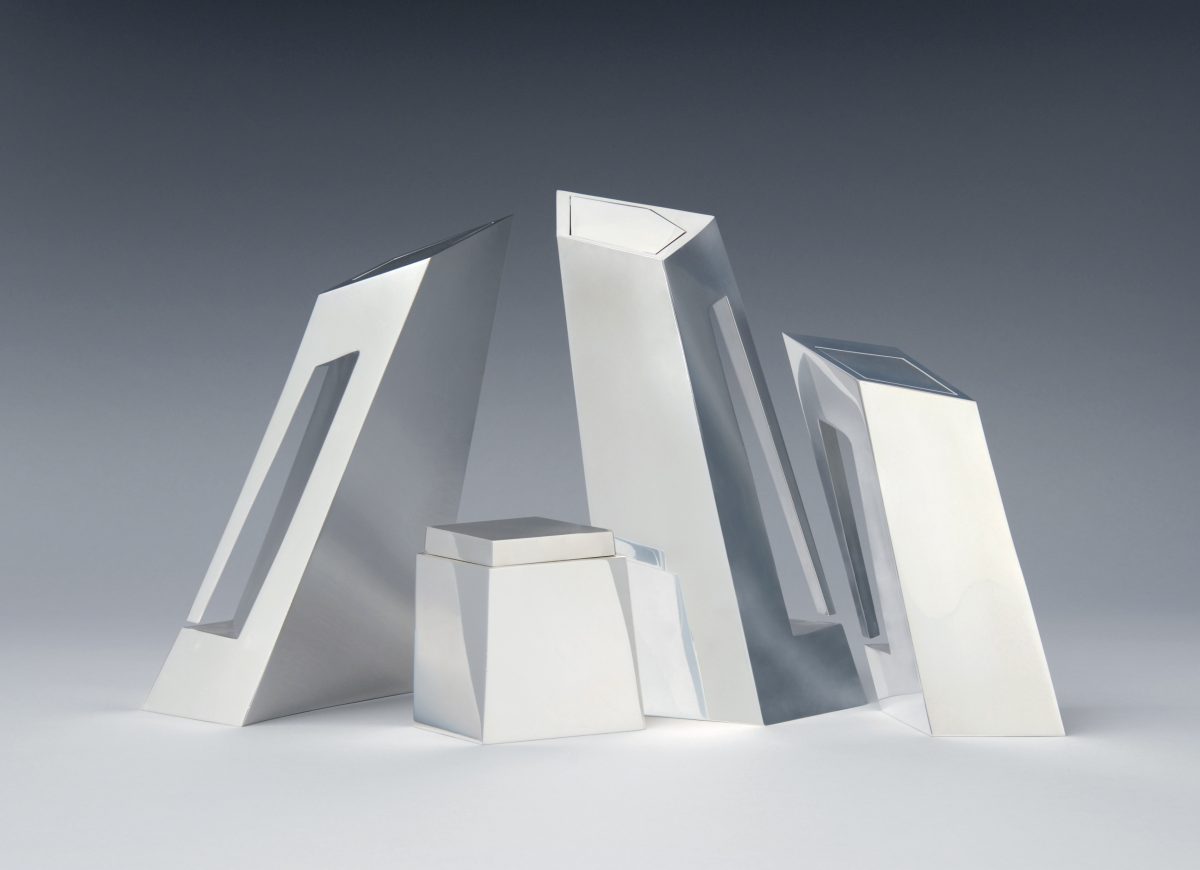 Hadid, Zaha, Tee- und Kaffee-Service, 1996/97 (Entwurf), Silber, Herst.: Sawaya & Moroni, Mailand, Foto: Die Neue Sammlung — The Design Museum
Hadid, Zaha, Tee- und Kaffee-Service, 1996/97 (Entwurf), Silber, Herst.: Sawaya & Moroni, Mailand, Foto: Die Neue Sammlung — The Design MuseumDie Einzelteile dieses Sevices passen ineinander und bilden zusammen ein Ganzes wie in einem 3D Puzzle. Die Form ändert sich, je nachdem, ob das Service in Gebrauch ist oder nicht. Ungenutzt ergibt sich eine kompakte Struktur, die sich leicht umhertragen lässt. Im Gebrauch werden die Objekte herumgedreht und gekippt. Jede Form hat eine Schnittfläche, die es möglich macht das Stück in eine andere Achsenlage zu kippen, wodurch sich die Ausgießöffnungen aufmachen und damit eine neue Komposition entsteht.
- Michael Heizer
1944
Heizer ist zur künstlerischen Bewegung der Land Art zu zählen, unter deren Begriff seit den 1960er-Jahren entstandene Installationen in der Landschaft, oftmals den US-amerikanischen Wüsten, von gigantischem Ausmaß zusammengefasst werden. Den Arbeiten gemein ist ihre stark konzeptuelle Ausrichtung, die sich sowohl in minutiösen Zeichnungen sowie abstrakten Notationen widerspiegelt.
-
- I
- Anne Imhof
1978
Mit ihrer Performance Faust, die sie 2017 für den deutschen Pavillon entwickelte, gewann Imhof den Goldenen Löwen der Biennale von Venedig. Begleitend fertigte sie zahlreiche von einer starken Linearität geprägte Zeichnungen an, die zugleich als vorbereitende Skizzen wie auch als Relikte der Aktion verstanden werden können.
-
- J
- Hilda Jesser
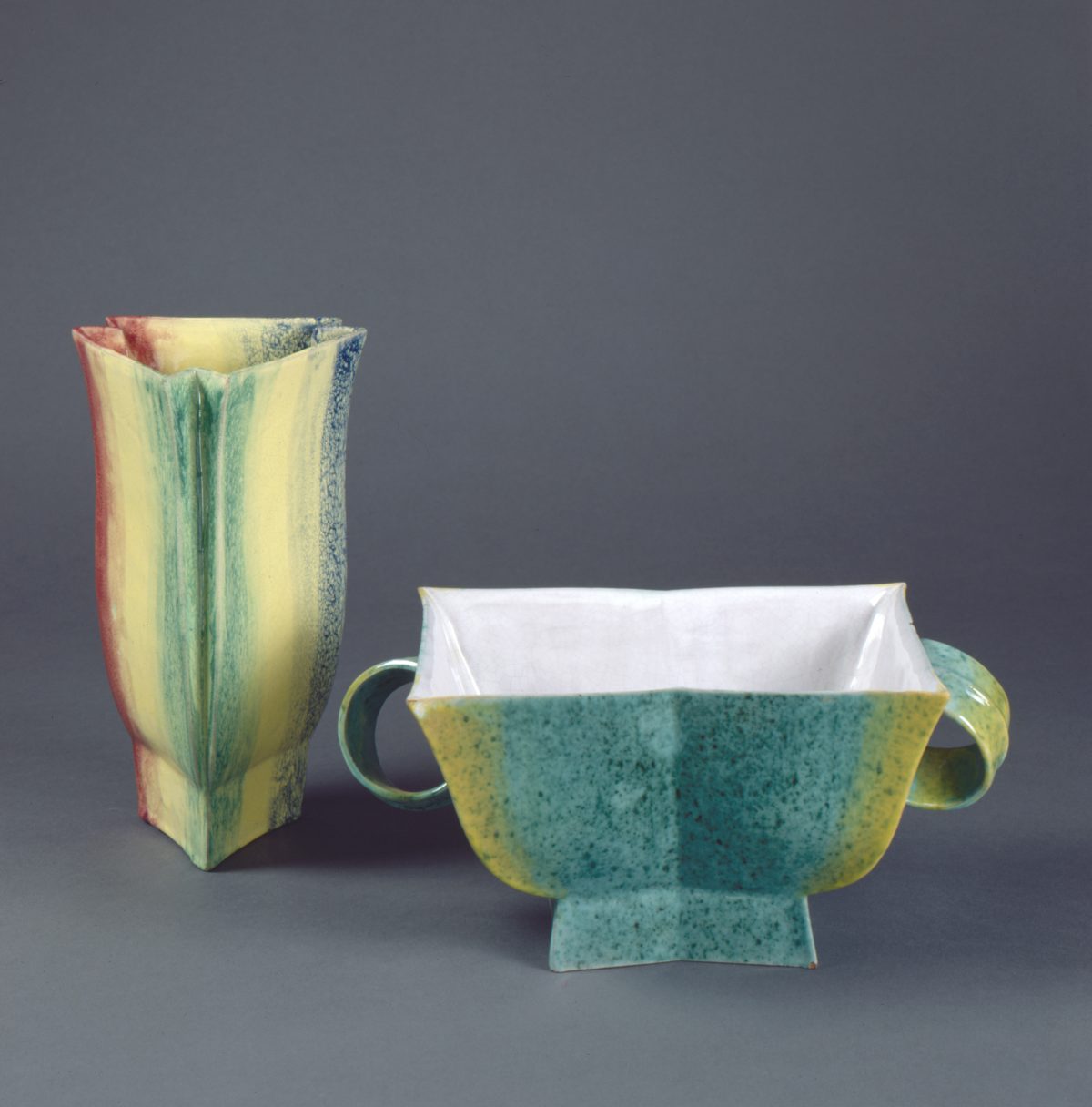 Jesser, Hilda, Vase Modell 868 und Jardinière Modell 872, 1921, Irdenware, glasiert, Herst.: Wiener Werkstätte, Wien, Foto: Die Neue Sammlung — The Design Museum
Jesser, Hilda, Vase Modell 868 und Jardinière Modell 872, 1921, Irdenware, glasiert, Herst.: Wiener Werkstätte, Wien, Foto: Die Neue Sammlung — The Design MuseumFrom 1916 onwards, the versatile artist Hilda Jesse delivered for the Viennese company Wiener Werkstätte both design concepts and completed works in diverse fields of handicraft. She designed only very few ceramic items. However, these were her most successful products. In her work, Hilda Jesser took the utmost care to ensure the serviceability of the goods and remained – contrary to the taste conventions of the time – reserved when it came to the use of colour and decoration and rejected all forms of gadgetry.
- Hella Jongerius
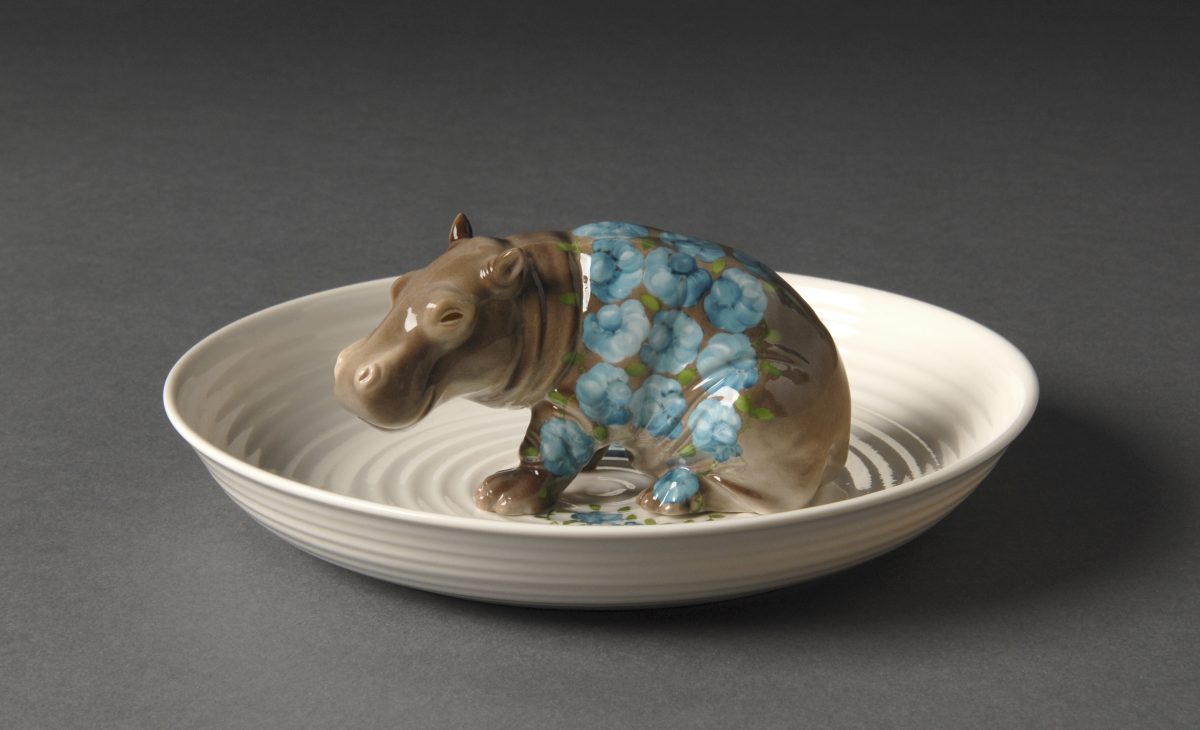 Jongerius, Hella, Schale mit Nilpferd, 2004, Porzellan, weißer Scherben, gegossen, handbemalt, Herst.: Porzellanmanufaktur Nymphenburg, München, Foto: Die Neue Sammlung — The Design Museum
Jongerius, Hella, Schale mit Nilpferd, 2004, Porzellan, weißer Scherben, gegossen, handbemalt, Herst.: Porzellanmanufaktur Nymphenburg, München, Foto: Die Neue Sammlung — The Design MuseumHella Jongerius wählte für ihre bekannte Serien der "Tierschalen" acht von siebenhundert Tierfiguren aus dem Formenarchiv der Nymphenburger Porzellanmanufaktur und platzierte sie in Schalen. Die naturalistische Bemalung von Schnecke, Vogel, Nilpferd, Reh, Hase, Frosch, Fuchs und Hund ergänzte sie jeweils mit einem zweiten Muster aus dem Dekorrepertoire von Nymphenburg – ganz gleich, ob es sich dabei ursprünglich um die Bemalung einer Suppenterrine oder das Federkleids eines Perlhuhns handelt.
-
- K
- Francis Kéré
1965
Diébédo Francis Kéré steht wie kaum ein anderer Architekt für das Zusammendenken konstruktiver, sozialer und kultureller Aspekte des Bauens.
Für die realisierten Bauprojekte in seiner Heimat Burkina Faso erhielt er zahlreiche internationale Preise – darunter schon 2004 den Aga Khan Award for Architecture. In seinen Gebäuden vereint er seine Ausbildung an der TU Berlin mit den traditionellen Baumethoden Afrikas zu einem neuen, innovativen Ansatz. - Ernst Ludwig Kirchner
1880 - 1938
 Ernst Ludwig Kirchner, recto: Mädchenakt im Interieur (Fränzi?), um 1910, Aquarell und Deckfarben, 450 x 350 mm © Staatliche Graphische Sammlung München
Ernst Ludwig Kirchner, recto: Mädchenakt im Interieur (Fränzi?), um 1910, Aquarell und Deckfarben, 450 x 350 mm © Staatliche Graphische Sammlung MünchenThe painter and draughtsman Kirchner is the most famous representative of the group of artists known as Die Brücke (The Bridge), which was founded in 1905 in Dresden. Their aim was a return to a form of art that was free from academic rules and regulations. Artistic spontaneity and uninhibited colourfulness characterise the painting here, which is one of Kirchner’s principal works stemming from his time in Dresden.
- Astrid Klein
In her large-scale collages of the late 1970s, Astrid Klein combined depictions of violence from the mass media with text legends that stand in extreme contrast with the cruelty shown in the images. When the artist superimposes a fragment of text from the Bible, ‘that perfect love casts out fear’, over an apparent scene of rape, the crime is hardly downplayed. Quite the opposite: the cynicism of the collage of image and text inflames and reinforces the horror all the more, cutting through our desensitization to everyday violence and its constant presence in the media.
- Wilhelm von Kobell
1766 - 1855
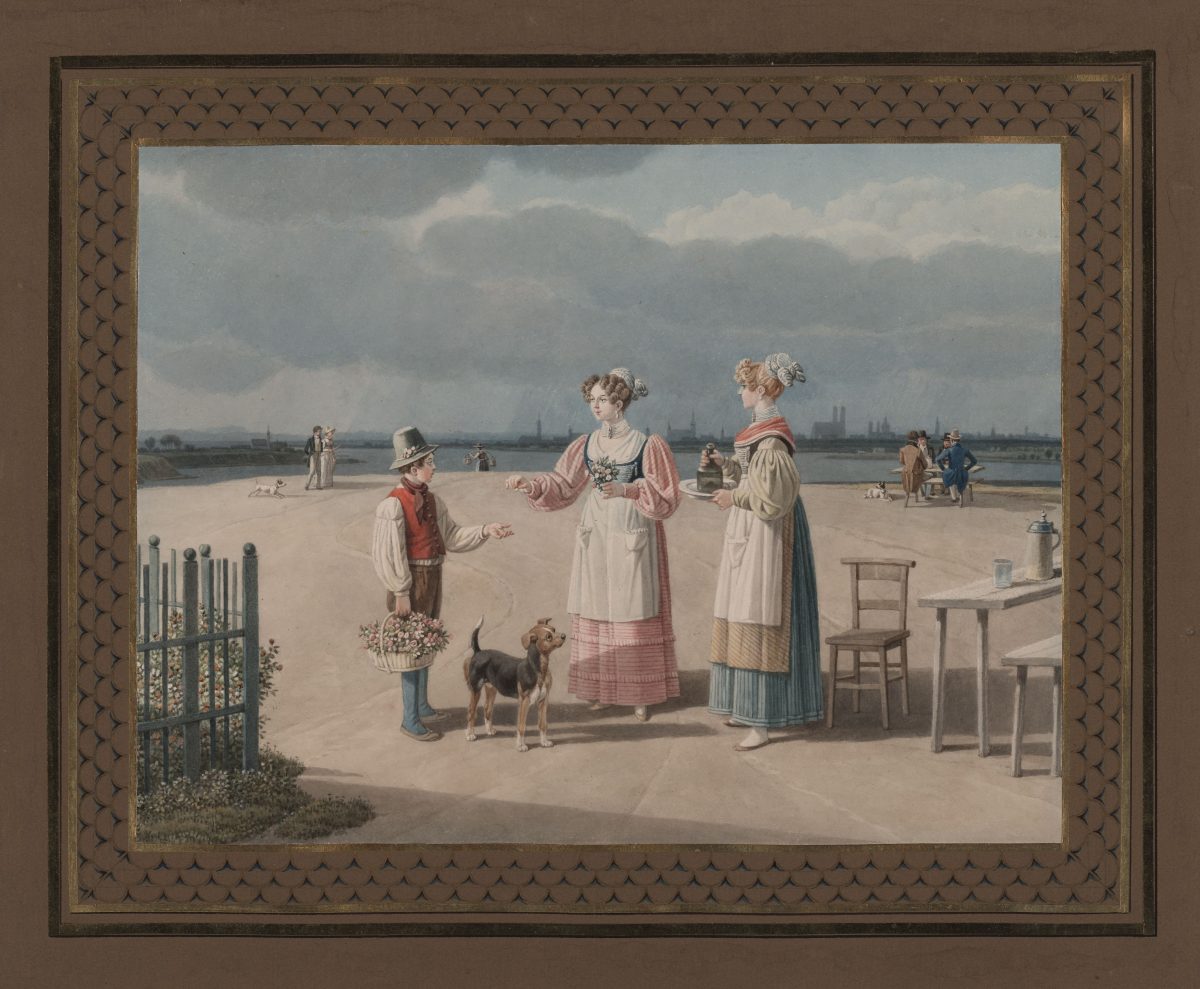
Wilhelm von Kobell, Terrasse bei Föhring, um 1827, Bleistift, Aquarell, 197 x 262 mm Blattmaß © Staatliche Graphische Sammlung München
- Franz Kobell
1749 - 1825
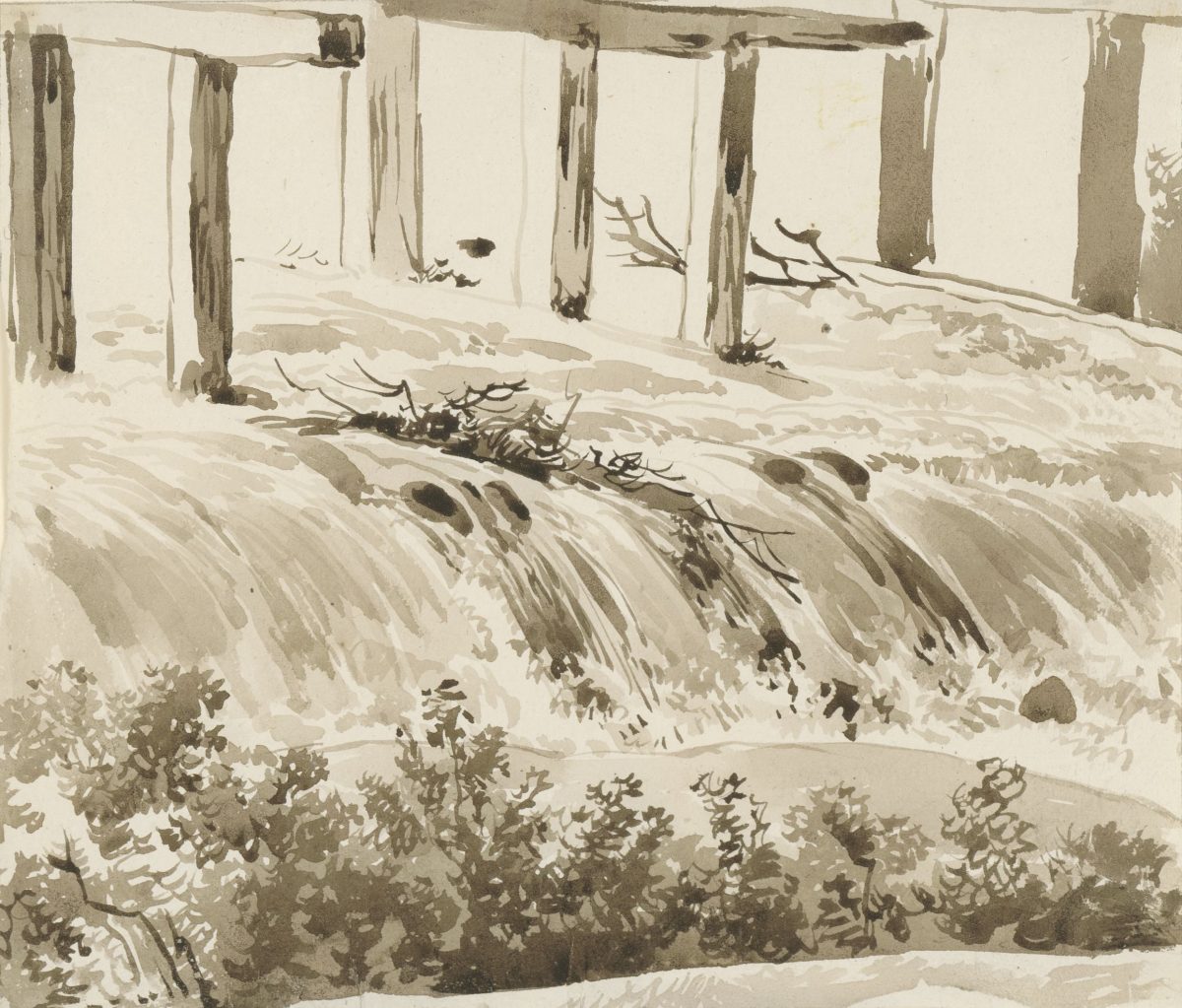
Franz Kobell, Kleiner Wasserfall mit Buschwerk im Vordergrund, zwischen 1800–1817, Pinsel in Braun, 181 x 211 mm Blattmaß © Staatliche Graphische Sammlung München
- Joseph Anton Koch
1768 - 1840
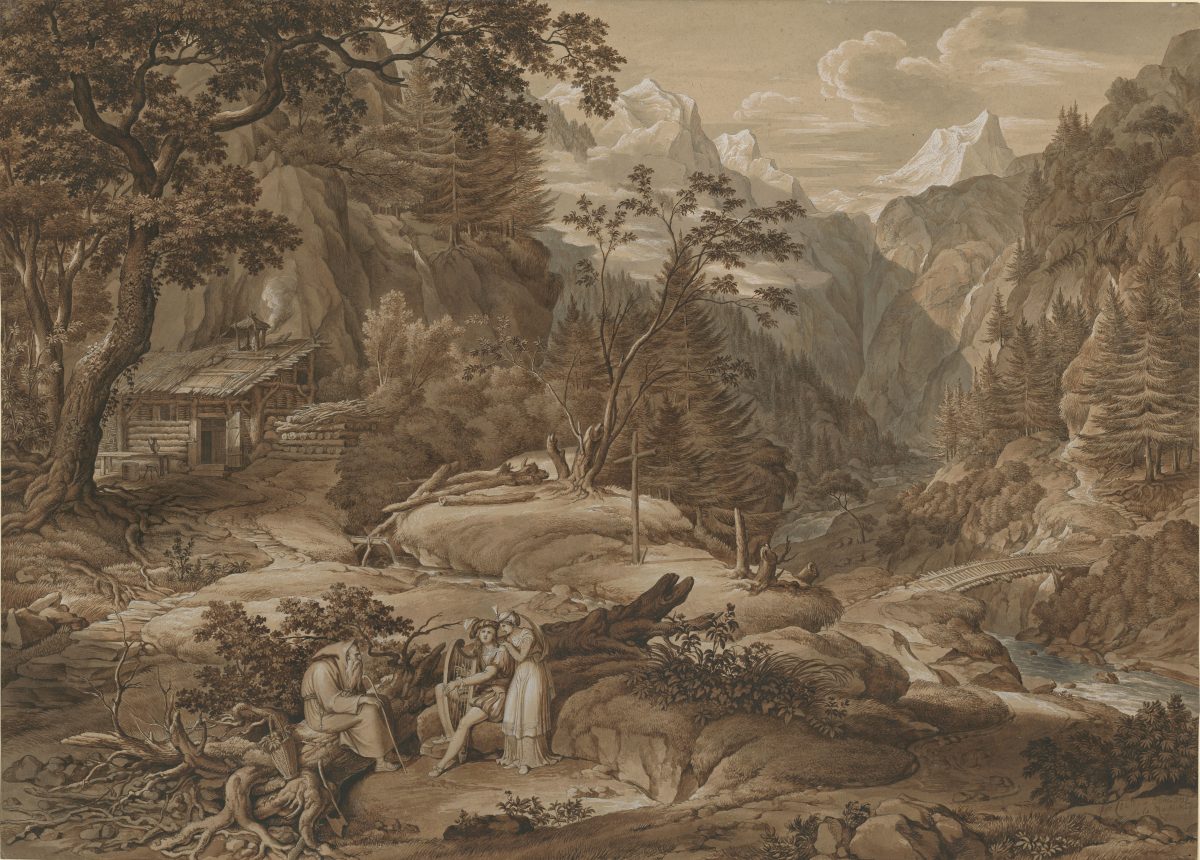
Joseph Anton Koch, Hüon und Amanda bei dem Einsiedler Alfonso, 1798/99 Szene aus Wielands Oberon, 8. Ges., Sepia laviert mit etwas Blau, Grün, Grau und Weiß, brauner und grauer Pinsel, Deckweiß, Feder in Schwarz, 535 x 751 mm Blattmaß © Staatliche Graphische Sammlung München
- Käthe Kollwitz
1867 - 1945
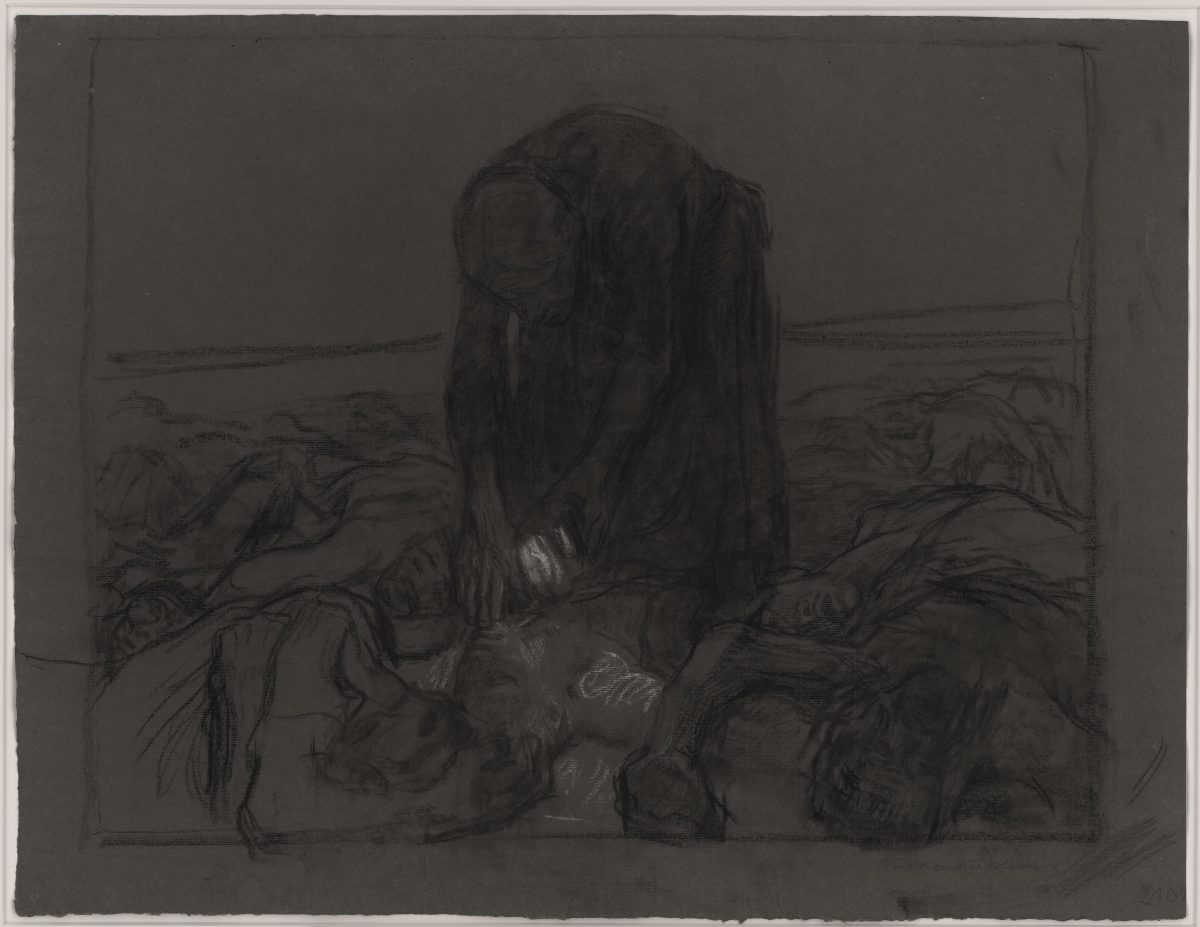 Käthe Kollwitz, 1867 – 1945, Schlachtfeld, 1907, Kohle und weiße Kreide auf grauem Papier, 456 x 595 mm © Staatliche Graphische Sammlung München
Käthe Kollwitz, 1867 – 1945, Schlachtfeld, 1907, Kohle und weiße Kreide auf grauem Papier, 456 x 595 mm © Staatliche Graphische Sammlung MünchenThere is hardly any other oeuvre at the beginning of the 20th century that expresses more memorably the ills in German society before the outbreak of the First World War than that of Käthe Kollwitz. The drawing here is a preliminary study related to the sixth sheet of her central cycle Bauernkrieg (1902 – 1908) (Peasants' War).
- Willem de Kooning
1904 - 1997
The American painter and draughtsman is one of the most significant representatives of Abstract Expressionism – that is, of highly expressive and vividly colourful painting, through which US-American art established itself first and foremost within the ranks of the Avantgarde. De Kooning’s semi-abstract, semi-figurative drawing should be seen in the context of his famous Woman-Series created in the 1950s.
- Germaine Krull
Germaine Krull first trained in photography in Munich. Later, after sojourns in Moscow, Berlin, and Amsterdam, she moved to Paris, where she worked as a photojournalist and became a successful advertising and portrait photographer. Her significance as an avantgarde artist is partly due to her portfolio Métal (1928), in which she took cranes, bridges, machines, and the Eiffel Tower as her subject matter. Through unusual camera angles and cropped details, Krull stylized the gigantic iron constructions, presenting them as dynamic monuments to modern life.
- Beate Kuhn
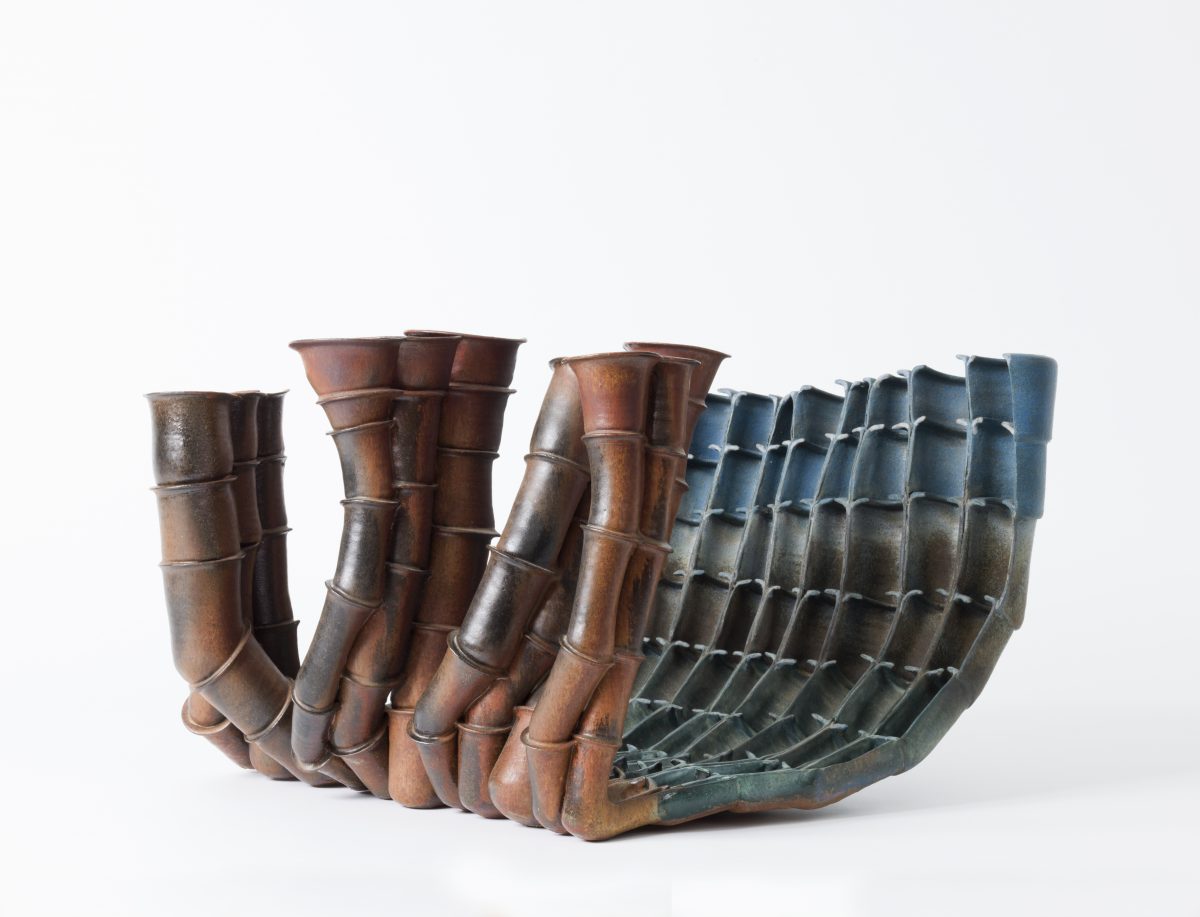 Kuhn, Beate, Keramikobjekt „Bäume vom Himmel“, 1991, Steinzeug, roter Scherben, gedreht und montiert, braun, blau, schwarz glasiert, Herst.: Beate Kuhn, Foto: Die Neue Sammlung — The Design Museum
Kuhn, Beate, Keramikobjekt „Bäume vom Himmel“, 1991, Steinzeug, roter Scherben, gedreht und montiert, braun, blau, schwarz glasiert, Herst.: Beate Kuhn, Foto: Die Neue Sammlung — The Design MuseumBeate Kuhn gehört mit ihrer unverkennbaren Handschrift und ihrer unerschöpflichen Fantasie zu den bedeutendsten deutschen Keramikern nach 1945. Mit den genuinen Mitteln und Techniken der Töpferei schuf sie ein Werk, das weit über die funktionelle Gebrauchskeramik hinausreicht und an die Entwicklungen der bildenden Kunst seit der Nachkriegszeit, von Picasso bis zur Serialität der Minimal Art, anschließt.
-
- L
- Wilhelm Leibl
1844 - 1900
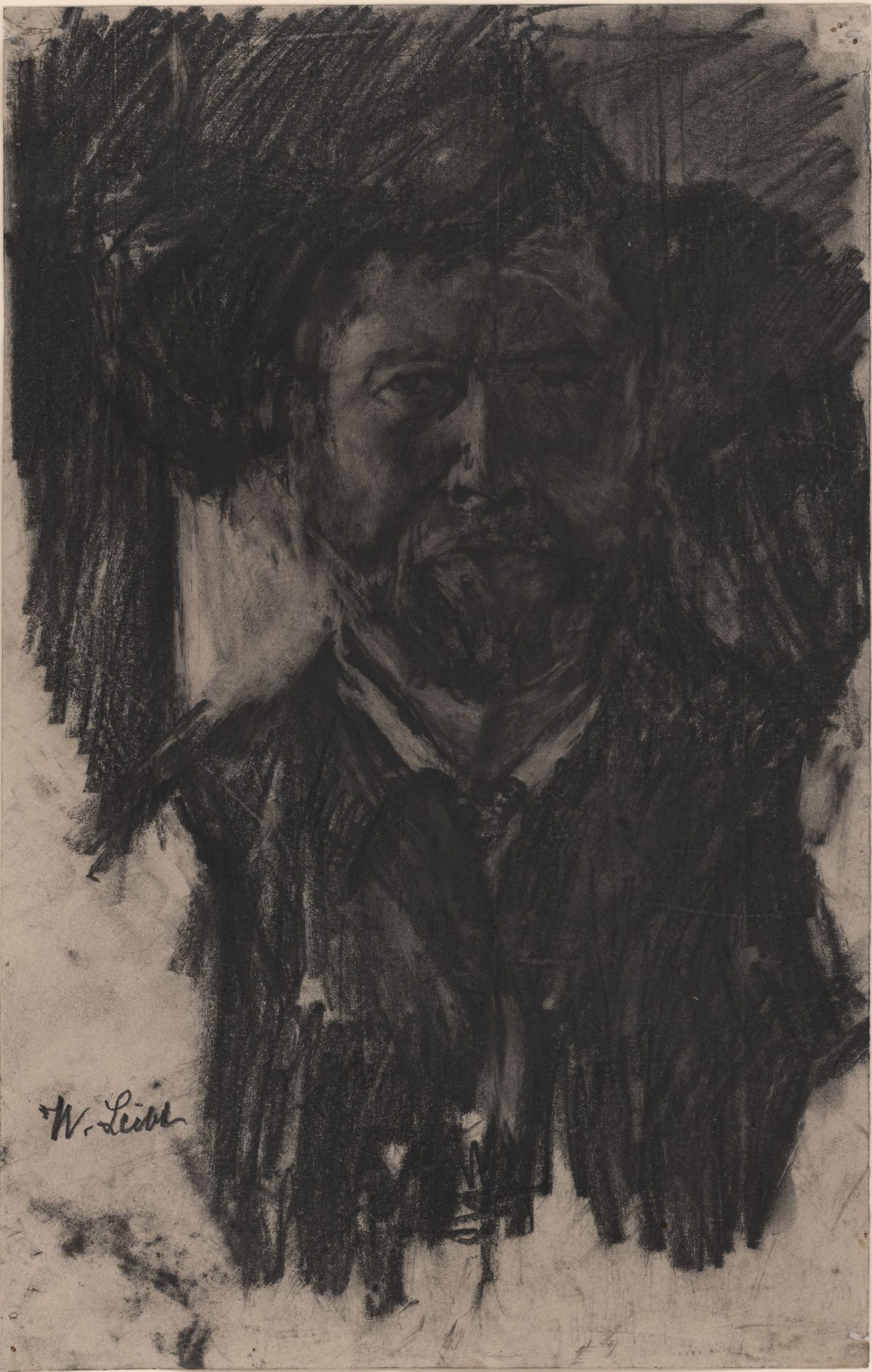
Wilhelm Leibl, Selbstbildnis, um 1895, Kohle, Bleistift, 330 x 210 mm Blattmaß © Staatliche Graphische Sammlung München
- Zoe Leonard
It is inconspicuous, often trivial-looking and everyday things which inspire in Zoe Leonard an almost scientific perseverance and an apparently tender respect. She makes them speak, as she has this Medicean Venus from Vienna. In addition to her interest in the subject, she is concerned with the act of seeing and the cultural conditions of our perception, which she seeks to make visible and palpable. Photography is never a likeness or a reproduction, but always a visual construct that reveals as much about its beholder as its subject.
- Max Liebermann
1847 - 1935
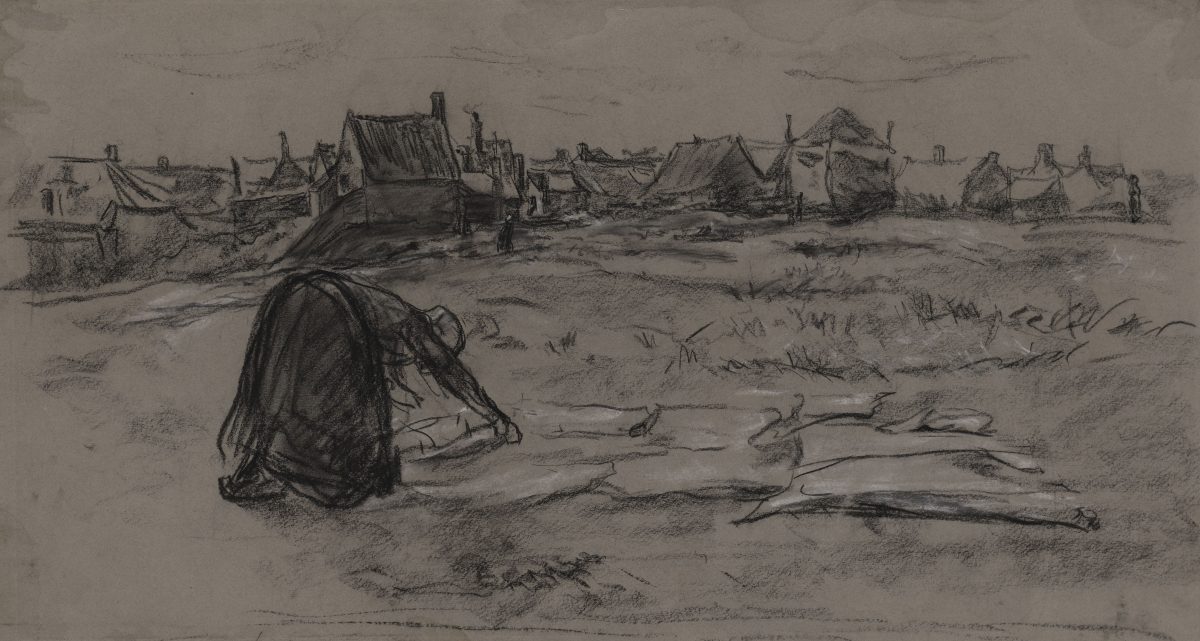
Max Liebermann, Die Bleiche, um 1889, Schwarze Kreide, weiß gehöht, 268 x 493 mm Blattmaß © Staatliche Graphische Sammlung München
- Hanna Löv
1901 - 1989

Die Architektin Hanna Löv war die erste weibliche Regierungsbaumeisterin in Bayern. Sie studierte ab 1919 an der TU München und arbeitete mit Robert Vorhoelzer bei der Oberpostdirektion München. Zusammen mit Erna Meyer und Walther Schmidt entwickelte sie in den 1920er Jahren eine neue Form der Küche, die „Münchner Küche“ – eine Kombination aus einer reinen Arbeitsküche und einer traditionellen Wohnküche.
-
- M
- Hans von Marées
1837 - 1887
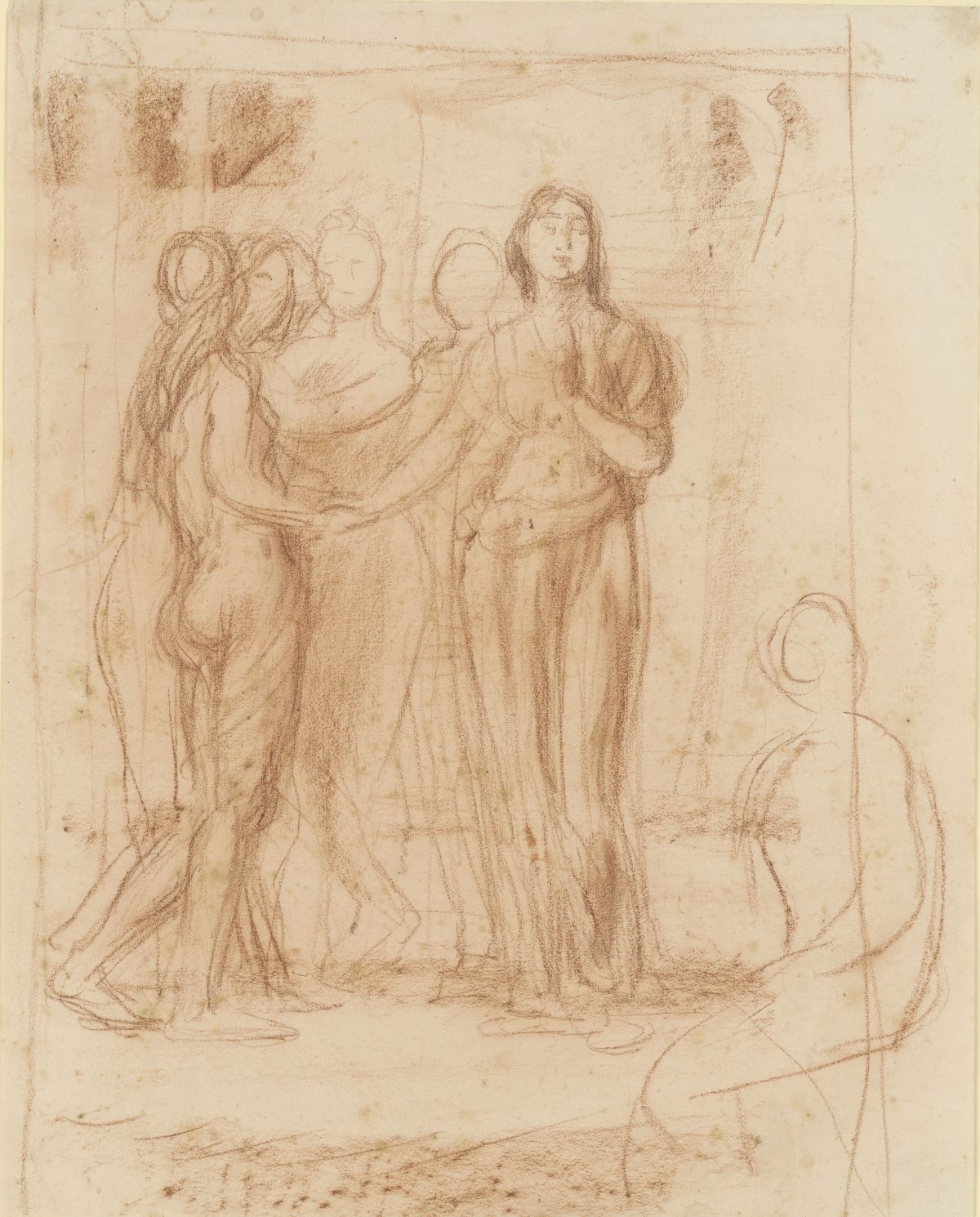
Hans von Marées, Frauengruppe, um 1885, Rötel, gewischt, 504 x 404 mm Blattmaß © Staatliche Graphische Sammlung München
- Walter de Maria
1935 - 2013
In Deutschland sorgte der US-amerikanische Künstler 1968 mit seiner Installation eines Erdraumes in der Galerie von Heiner Friedrich in München für Aufsehen, der Kunstgeschichte geschrieben hat. Das Interesse an einer Verbindung von Kunst und Natur kulminierte in der Einrichtung des Lightning Field in der Wüste von New Mexico 1977, zu der de Marias Zeichnung eine beinahe poetische Analogie bildet.
- Adolph von Menzel
1815 - 1805
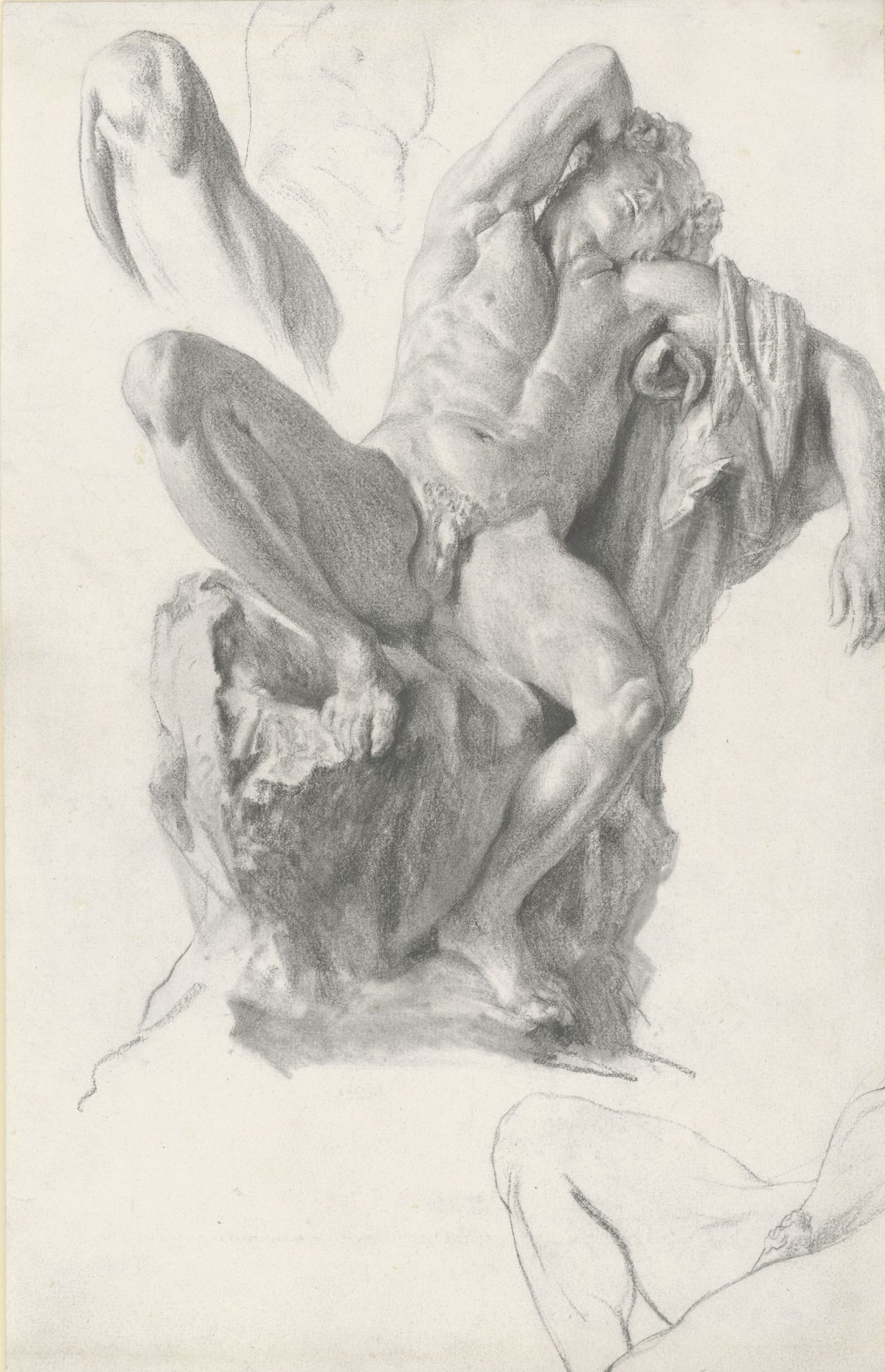
Adolph von Menzel, Der Barberinische Faun, 1874, Bleistift, 400 x 250 mm Blattmaß © Staatliche Graphische Sammlung München
- Olaf Metzel
The opening of the Pinakothek der Moderne coincided with the 30th anniversary of the massacre during the Olympic Games in Munich, which bore the motto ‘Joyous Games’. Against this background Olaf Metzel created a sculpture for the new museum that accentuates the stage-like aura of the stairs in its foyer: he dressed the single column on the middle block of stairs in shimmering cladding made of colourful acrylic glass. Warped plastic chairs in the interior lend something uncanny to the work and allude to the ambivalence of the children’s game to which the title refers (the term for ‘musical chairs’ in western Germany is ‘journey to Jerusalem’).
- Piet Mondrian
1872 - 1944
Piet Mondrian ranks as one of the most important representative of the Dutch group of artists known as De Stijl. The drawing– executed at the same time as his strictly geometric and abstract paintings – served soley as a means of earning a living. This explains the veristic attention to detail and the work’s striking naturalism.
-
- N
- Bruce Nauman
1941
Dem Umkreis der Konzeptkunst zugeordnet, hat der US-amerikanische Künstler ein vielschichtiges, gesellschaftskritisches Werk an Videoarbeiten, Performances, Skulpturen und Installationen mit einem irritierenden Sinngehalt geschaffen. Mit seinen radikalen, auf die Sinneswahrnehmung zielenden Arbeiten hat er die Kunst seit den 1960er-Jahren maßgeblich beeinflusst.
- Emil Nolde
1867 - 1956
The vividly colourful portrayals of nature by the Schleswig-Holstein artist Emil Nolde are among the most impressive representations in German art of the 20th century. The spectacles of nature, which he studied intensely in the flat landscape of his north German homeland with its broad horizons, were captured in highly atmospheric renditions of colour.
-
- O
- Albert Oehlen
1954
Enfant Terrible der Kunst der 1980er-Jahre, wird der deutsche Maler dem sogenannten Bad Painting zugeordnet. Seine Gemälde und Graphiken schockieren durch ihre gewollt nachlässige Malerei, die banale Motivik und eine scheinbare Interesselosigkeit. Dass diese Art Kunstverständnis nichts mit einer mangelnden künstlerischen Qualität zu tun hat, beweist Oehlens Zeichnung.
- Friedrich Olivier
1791 - 1859
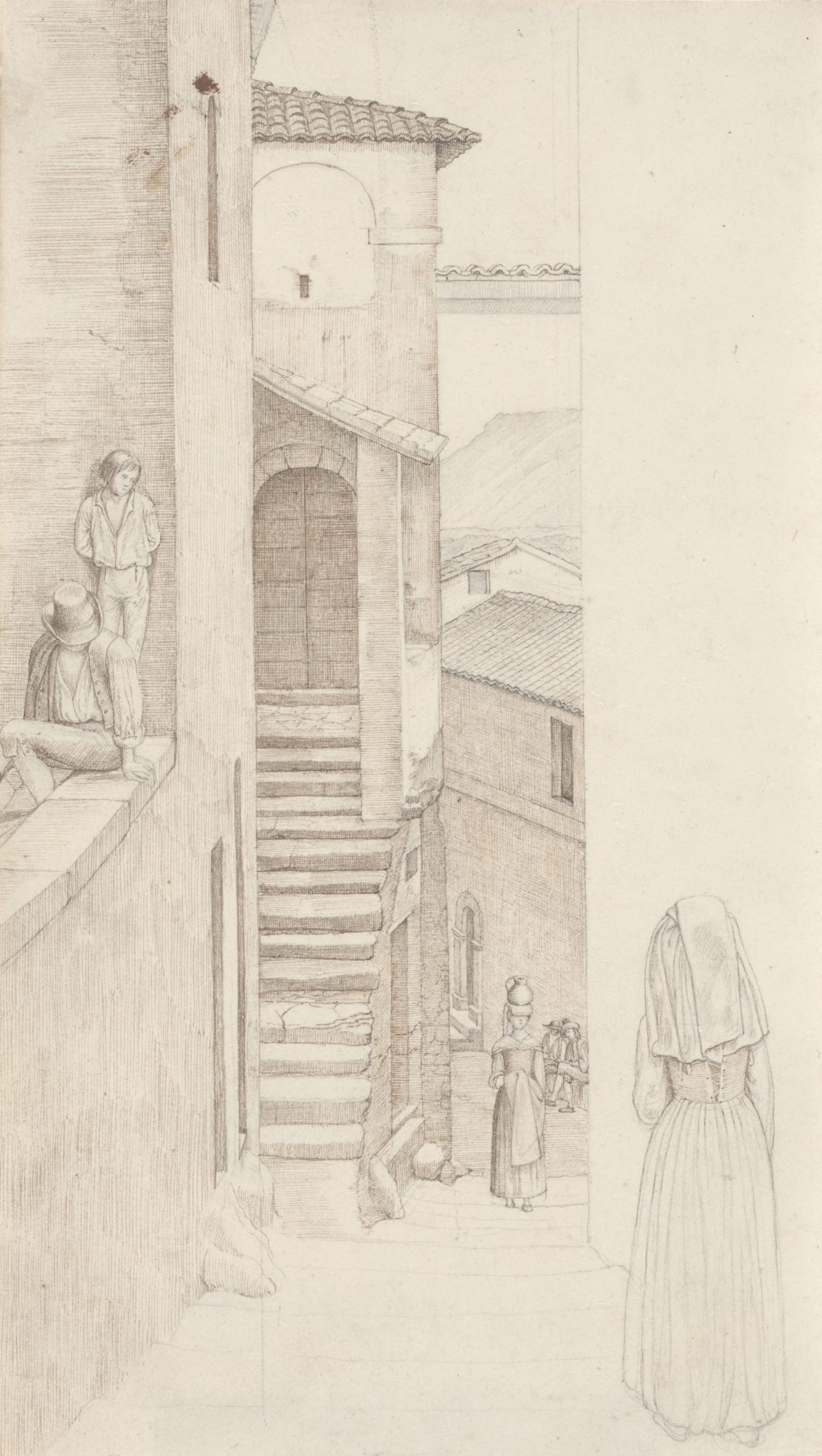
Friedrich Olivier, Straße in Olevano, 1819, Feder in Braun über Bleistift, 216 x 125 mm Blattmaß © Staatliche Graphische Sammlung München
- Ferdinand Olivier
1785 - 1841
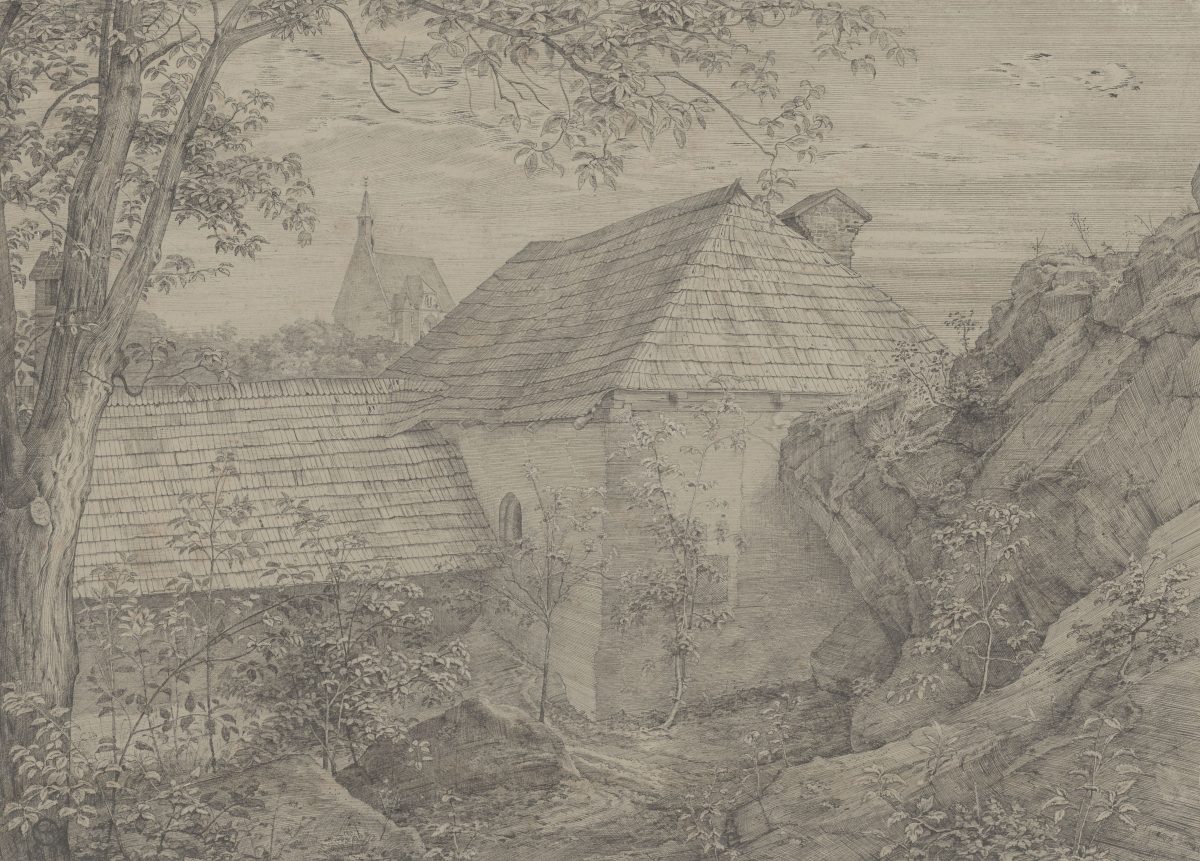
Ferdinand Olivier, Gehöftwinkel in Mödling, im Hintergrund die Spitalkirche, 1823, Feder in Schwarz, 327 x 453 mm Blattmaß © Staatliche Graphische Sammlung München
- Roman Ondak
The urge to measure the world is an old one. Measuring the Universe, a performative drawing that happens on the walls of an entire room, can be seen as a part of this tradition. At its core is the act of marking the height of a body, as parents do with their children in order to record the dimension of change across time. Ondak turns this otherwise private gesture into a public action: museum attendants record the height of every single museum visitor. As time passes, the marks accumulate into a wall drawing. Physical presence and transience are made tangible – with minimal means.
- Johann Friedrich Overbeck
1789 - 1869
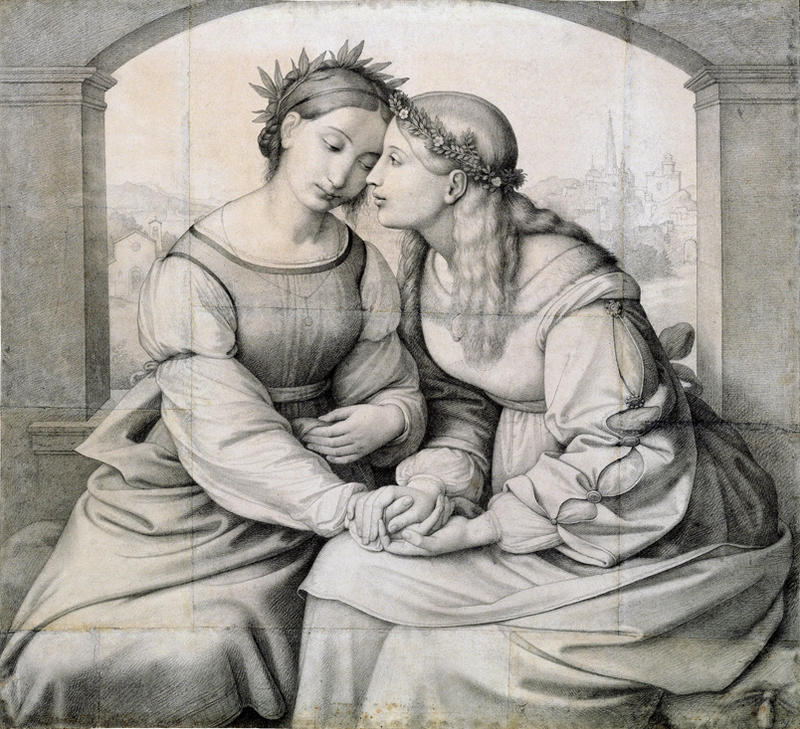
Johann Friedrich Overbeck, Italia und Germania, 1812/15 ff., Schwarze Kreide, 923 x 1012 mm /unten 1015 mm Blattmaß, 1250 x 1330 x 45 mm Rahmenmaß © Staatliche Graphische Sammlung München
- Brian O’Doherty
1928
Mit institutionskritischen Texten, allen voran seinem Essay „Inside the White Cube“, hat O’Doherty den Kunstdiskurs seit den 1960er-Jahren international stark geprägt. Weniger bekannt ist, dass der in den USA lebende Ire auch ein umfangreiches Œuvre an Malereien, Graphiken und Raumarbeiten geschaffen hat, wobei er konzeptuellen und performativen Strategien folgt, wie das „Porträt“ von Marcel Duchamp eindringlich bestätigt.
-
- P
- Blinky Palermo
1943 - 1977
Palermo gilt als früh vollendetes und jung verstorbenes Ausnahmetalent. In seiner kurzen Schaffenszeit gelang ihm die Entwicklung einer vollkommen eigenständigen Bildsprache, in deren Mittelpunkt eine subtile Balance zwischen abstrakter Farbfeldmalerei und dreidimensionalem Raum steht.
- A.R. Penck
1939 - 2017
Das Selbstbildnis zeigt den Künstler als einen selbstbewussten jungen Mann. Beeindruckend ist der sichere Strich, mit dem der aufstrebende Maler seine dynamische Zeichnung angelegt hat. Sein Studium der Alten Meister in Dresden ist ebenso offensichtlich wie die malerische Kraft, mit der Penck ein Werk schaffen sollte, das einen Höhepunkt der Kunst nach 1945 darstellt.
- Adrian Piper
Nine different couples regard us out of nine different images. With their radiant smiles they derive from the imaginary world of film, advertising, and the family album, all except for the one: the couple in the centre with their serious expression, poor clothing, and especially their dark skin colour troubles the overall effect. ‘Pretend not to know what you know’ – the sentence with which Adrian Piper combines the nine images lays bare what we all too easily push to the side: social injustice, discrimination, and our own prejudices against people outside of the white middle class.
-
- R
- Neo Rauch
The monumental painting "Kalimuna" by Neo Rauch simultaneously quotes large-scale Baroque genre scenes, whose expansive scale made them panoramas of society, and 19th century history paintings. It also conjures the murals and propaganda images of the 20th century. However, contrary to its forerunners, which were filled with pride or pathos, Rauch’s work expresses otherworldiness and uncertainty. The characters in the images appear stunned as they go about their daily work or perform rituals. The painting makes tangible the conflict between individual and society, as well as the contradictory relationship between nature and civilization.
- Man Ray
Man Ray had a radical influence on modern art, as a photographer, a painter, a filmmaker, and a maker of assemblages. In his photographic work, he experimented with cameraless photography, multiple exposures, montage, and manipulation. The elegant portfolio Électricité was originally a commission for the Paris electricity provider, intended to advertise electricity. In ten photogravures made from what were called rayographs, Man Ray makes light, vibration, energy, and tension visible – electricity here appears as a metaphor for modern life.
- Johann Christian Reinhart
1761 - 1847
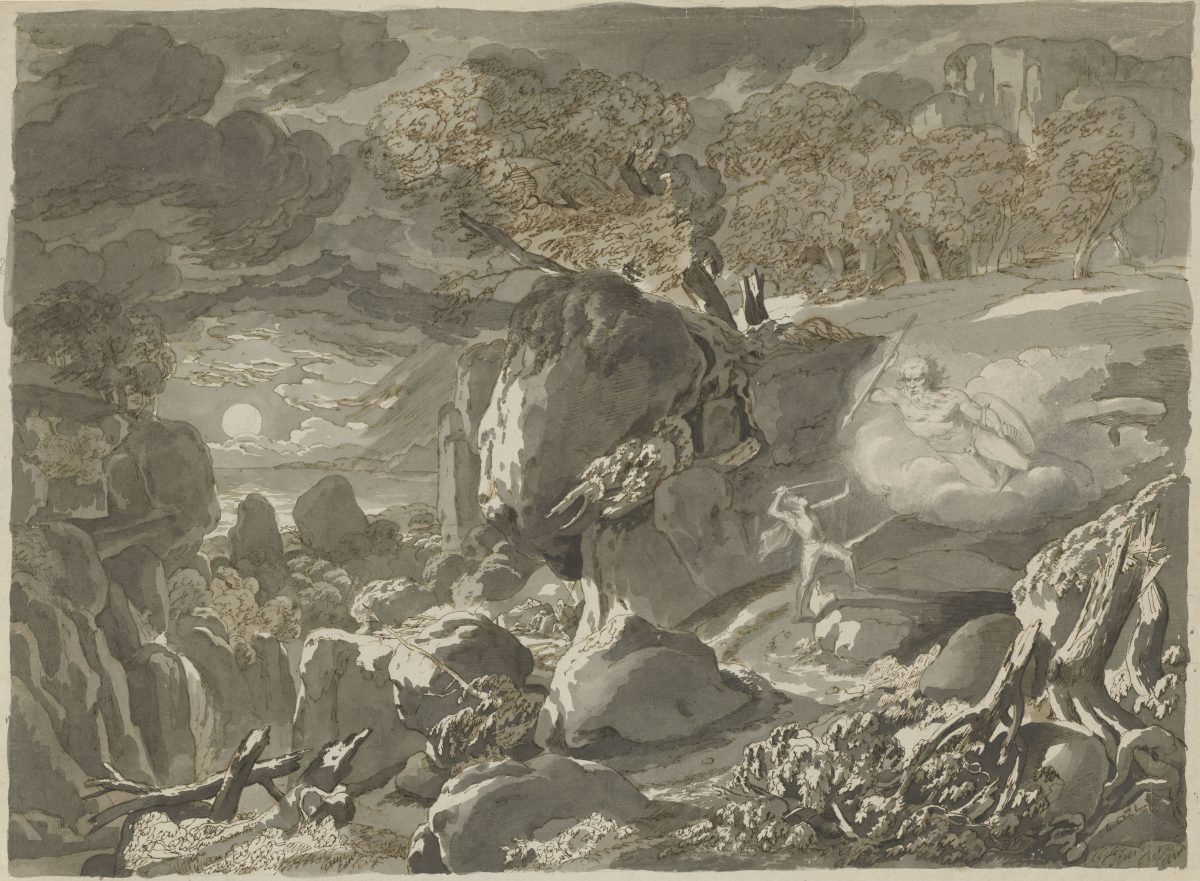
Johann Christian Reinhart, Fingals Kampf mit dem Geist von Loda, 1796, Bleistift, Feder und Pinsel in Braun und Schwarz, 588 x 808 mm Blattmaß © Staatliche Graphische Sammlung München
- Albert Renger-Patzsch
Between 1927 and 1935, Albert Renger-Patzsch took photographs of the industrial Ruhr region, capturing images of landscapes on the edge of cities, slagheaps, inner courtyards, suburban houses, and industrial and mining facilities. The series was the only major noncommissioned work that Renger-Patzsch ever carried out. With their reticent emotionality and compositional clarity, these images make an important contribution to the representation of modern industry and landscapes. Today, the Ruhr photographs can also be read as a visual commentary on contemporary discussions of urbanism, landscape conservation, and post-industrial landscapes.
- Werner Rohde
By his own account, Rohde, who came from a family of church painters, saw photography as a chance to develop freely as an artist. Rohde first worked as a fashion photographer, but his work became increasingly free in form, playing with theatrical masquerades and staged identities. Elaborately costumed figures and still lifes make his photographs look like citations from films of the 1920s and 1930s. In 1929, Carnival was included in the travelling exhibition Film und Foto, alongside six other photographs by Rohde.
- Carl Rottmann
1797 - 1850
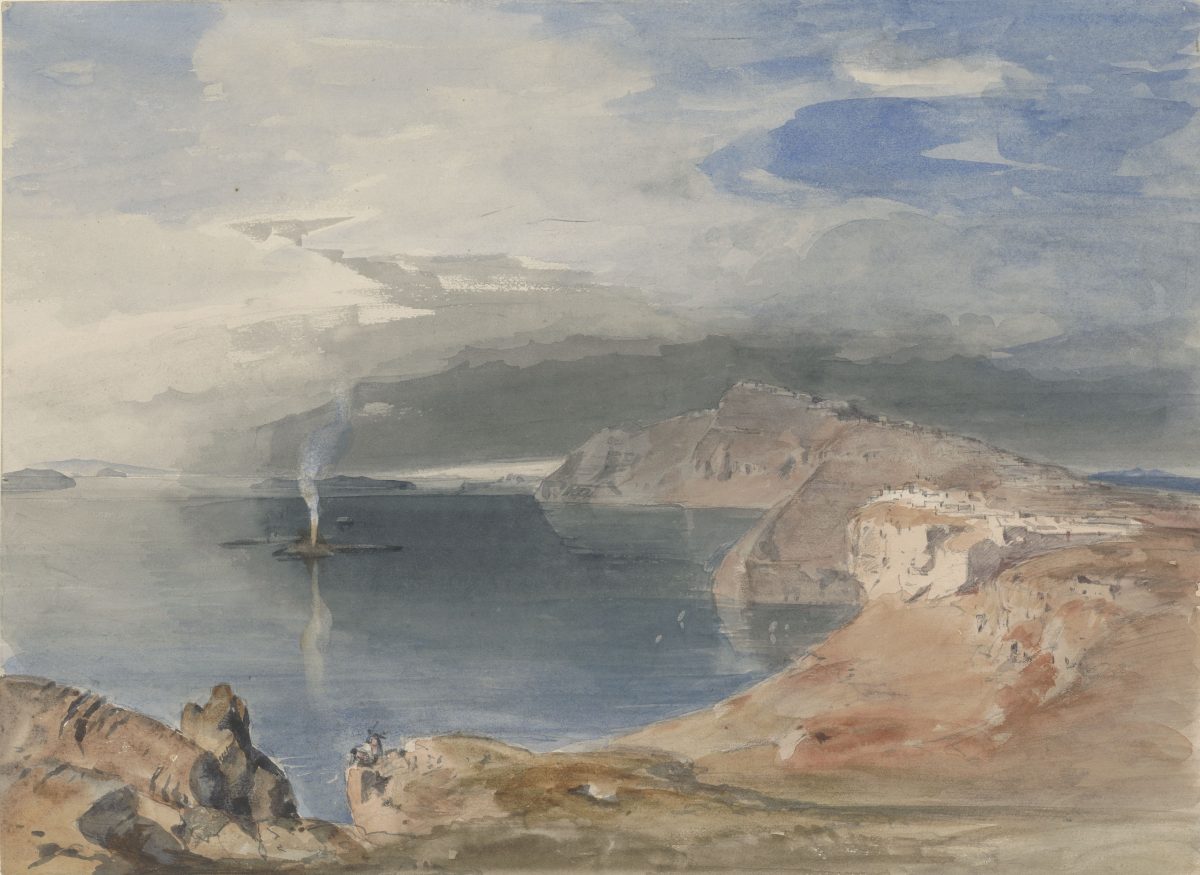
Carl Rottmann, recto: Santorin, verso: Santorin (Skizze), 1845, Bleistift und Aquarell, 277 x 381 mm Blattmaß © Staatliche Graphische Sammlung München
- Sep Ruf
1908 - 1982
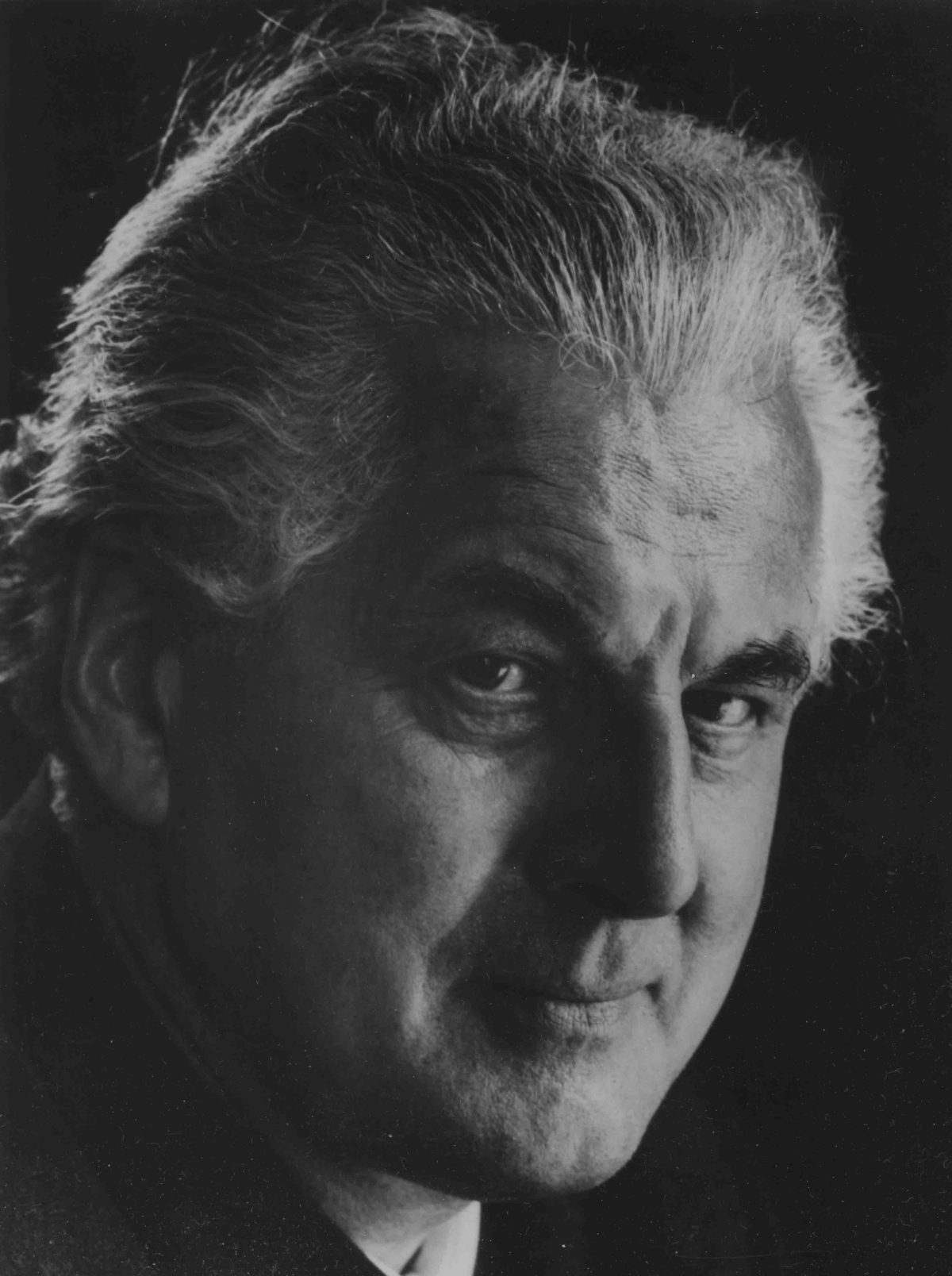
Sep Ruf zählt zu den bedeutendsten Architekten der deutschen Nachkriegsarchitektur. Er lehrte an der Akademie der Bildenden Künste in Nürnberg und später in München, wo er 1958 Präsident wurde. Mit seinen leichten, transparenten Bauten, die sich an Ideen des Bauhaus orientierten und jegliche Art von monumentalen Gesten vermieden, prägte er nach dem zweiten Weltkrieg vor allem das Stadtbild von München, Nürnberg und Bonn und trug maßgeblich zur baulichen Repräsentation der jungen deutschen Demokratie bei.
- Johann Moritz Rugendas
1802 - 1858
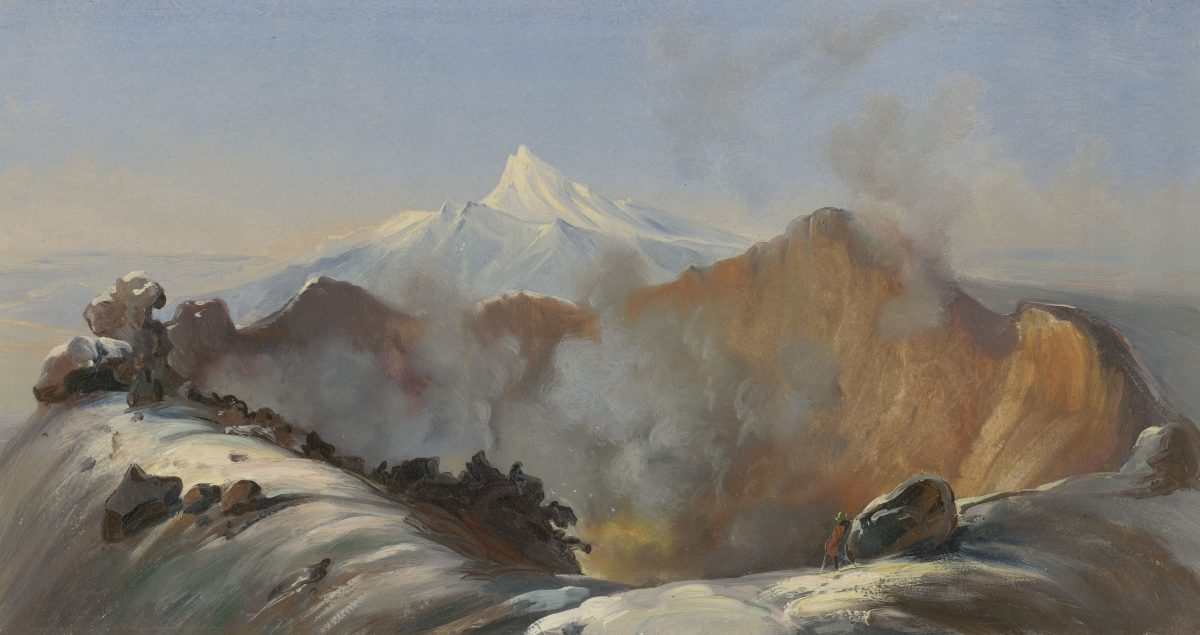
Johann Moritz Rugendas, Blick vom Krater des Vulkans von Colima Richtung Norden, Ölfarbe auf Papier, 221 x 416 mm Blattmaß © Staatliche Graphische Sammlung München
- Jacques Ruhlmann
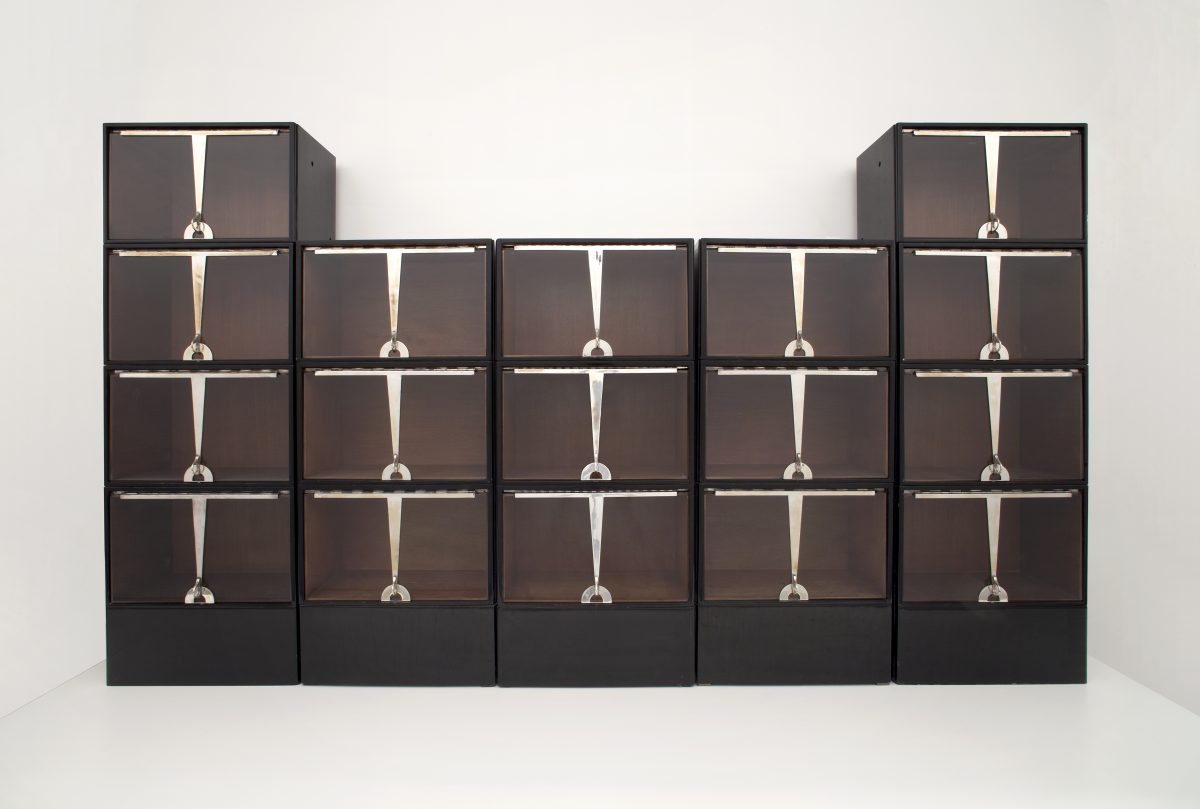 Ruhlmann, Jacques, Bücherschranksystem „Bibliothèque", um 1928, Holz, lackiert, Glas, Metall, verchromt, Herst.: Etablissements Ruhlmann, Paris, Foto: Die Neue Sammlung — The Design Museum
Ruhlmann, Jacques, Bücherschranksystem „Bibliothèque", um 1928, Holz, lackiert, Glas, Metall, verchromt, Herst.: Etablissements Ruhlmann, Paris, Foto: Die Neue Sammlung — The Design MuseumThe “Bibliothèque" marks the highlight of French Art Déco and, at the same time, a milestone in the development of element-and-system furniture. Handicraft perfection in the execution of the work in conjunction with the concept of free combinability of the individual case elements - here in lies the significance of this piece of furniture. In its constructive composition of system furniture consisting of elements screwed together, it concretises for the first time the development of modern furniture from wall cupboard to built-in wall cabinet.
-
- S
- August Sander
In his epochal work People of the Twentieth Century, August Sander devoted an entire chapter to architects as a human type. Here, Sander depicts Hans Poelzig in seated posture, as he did with most of the architects he portrayed. Poelzig was the co-founder of the Neue Sachlichkeit school of architecture: his three-piece suit, bowtie, and the cigar loosely held in the left hand point to his status within the prosperous bourgeoisie, but his unusual haircut and striking spectacles emphasize his artistic, avant-garde attitude.
- Michael Schmidt
This group of works of 163 photographs was made between 1991 and 1994. Presented in a dense sequence and framed in iron, the viewer is enveloped by a nearly endless series of images: dreary cityscapes, landscapes, still lifes, and anonymous portraits are mixed with reproductions of historical photos. The latter are images of mass parades, politicians’ portraits, and historical events and can be read as bits and pieces of information or scraps of memory connected to 20th century German history. Yet this compendium remains fragmentary, it resists assembly into a unified whole.
- Paul Schmitthenner
1884 - 1972
Paul Schmitthenner war Vertreter der ersten Stuttgarter Schule und Mitbegründer der konservativen Architektenvereinigung „Der Block“, die sich als Gegenmodell zur avantgardistischen Vereinigung „Der Ring“ konstituierte. Ab 1918 war er Professor an der Technischen Hochschule Stuttgart. Sein Entwurf zur „Gartenstadt“ gilt als große städtebauliche Leistung des frühen 20. Jahrhunderts. In seinen Publikationen über preiswerte und gesunde Wohnkonzepte beschäftigte er sich unter anderem mit ersten Leitgedanken zum ökologischen Bauen.
- Elisabeth Schmitthenner
1921 - 2017
Die Architektin Elisabeth Schmitthenner war die Herausgeberin des Lehrbuchs „Gebaute Form“, das sie mit ihrem Ehemann Paul Schmitthenner als Bild- und Textserie entwickelte. Sie studierte unter Theodor Fischer und Paul Bonatz an der Technischen Hochschule in Stuttgart und machte sich 1949 in ihrer Heimatstadt Neustadt in Holstein selbstständig. Schmitthenner gilt als eine der Architektinnen, die sich in der von Männern dominierten Architekturwelt behaupten und ihr eigenes Büro führen konnte.
- Paul Schneider-Esleben
1915 - 2005
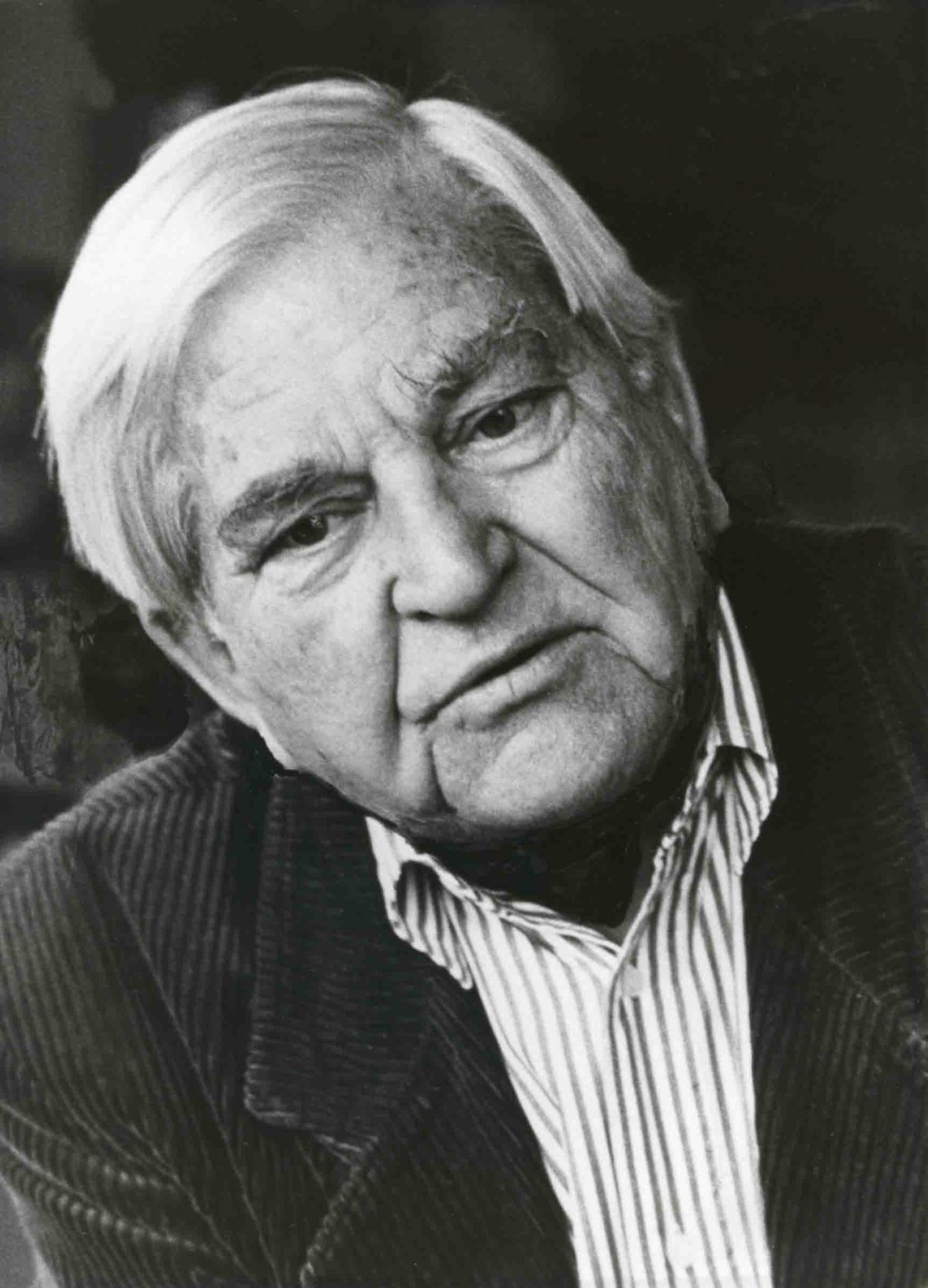
Der Architekt, Designer und Künstler Paul Schneider-Esleben war ein Vertreter der deutschen Nachkriegsmoderne. Bekannt wurde er vor allem durch funktionalistische High-Tech-Architektur und Megaprojekte in Beton. Von 1961-1970 lehrte er an der Hamburger Hochschule für Bildende Künste. Später beteiligte er sich an der anhaltenden Debatte um den Denkmalwert der Nachkriegsmoderne.
- Julius Schnorr von Carolsfeld
1794 - 1872
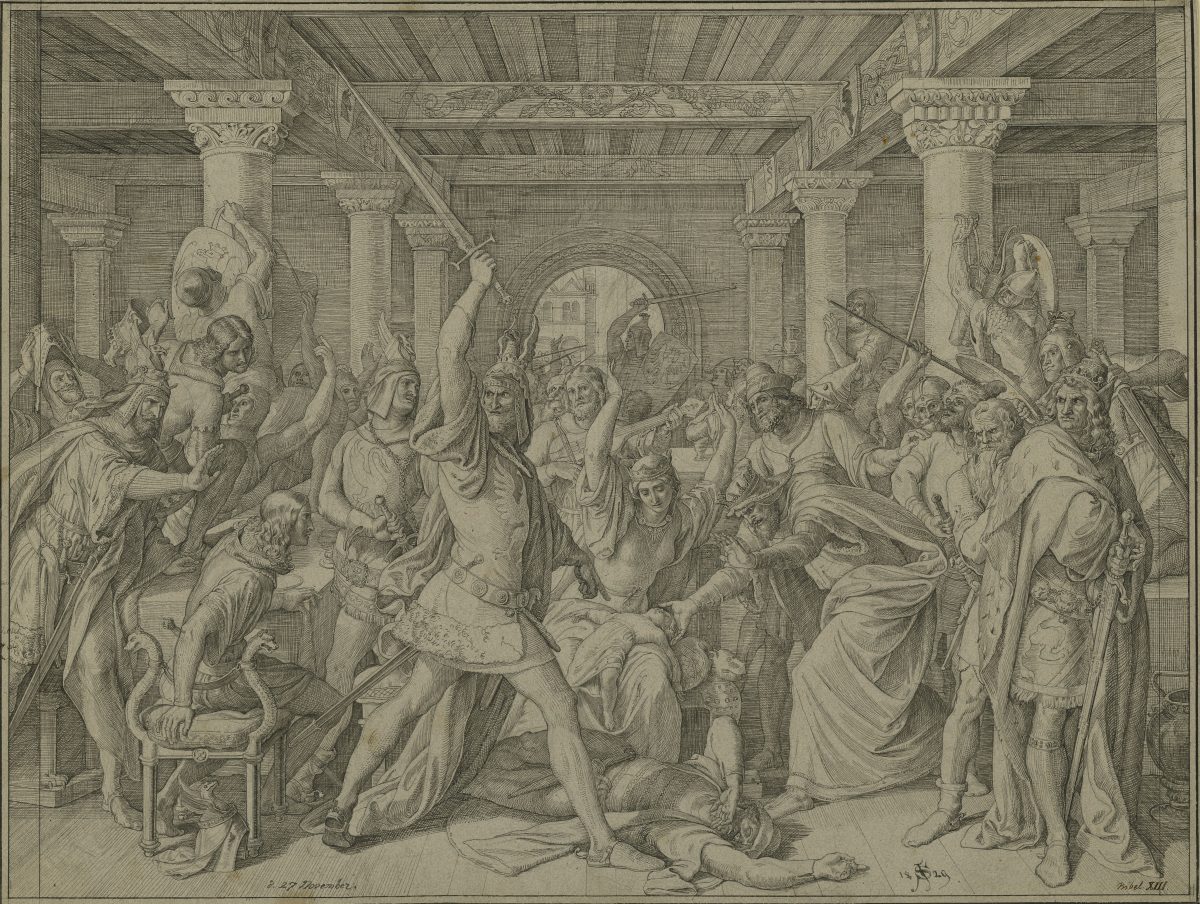
Julius Schnorr von Carolsfeld, Hagen eröffnet das Blutbad, Nibelungenlied, 13. Gesang, 1829, Feder in Schwarzgrau über Bleistift, 429 x 569 mm Blattmaß © Staatliche Graphische Sammlung München
- Moritz von Schwind
1804 - 1871
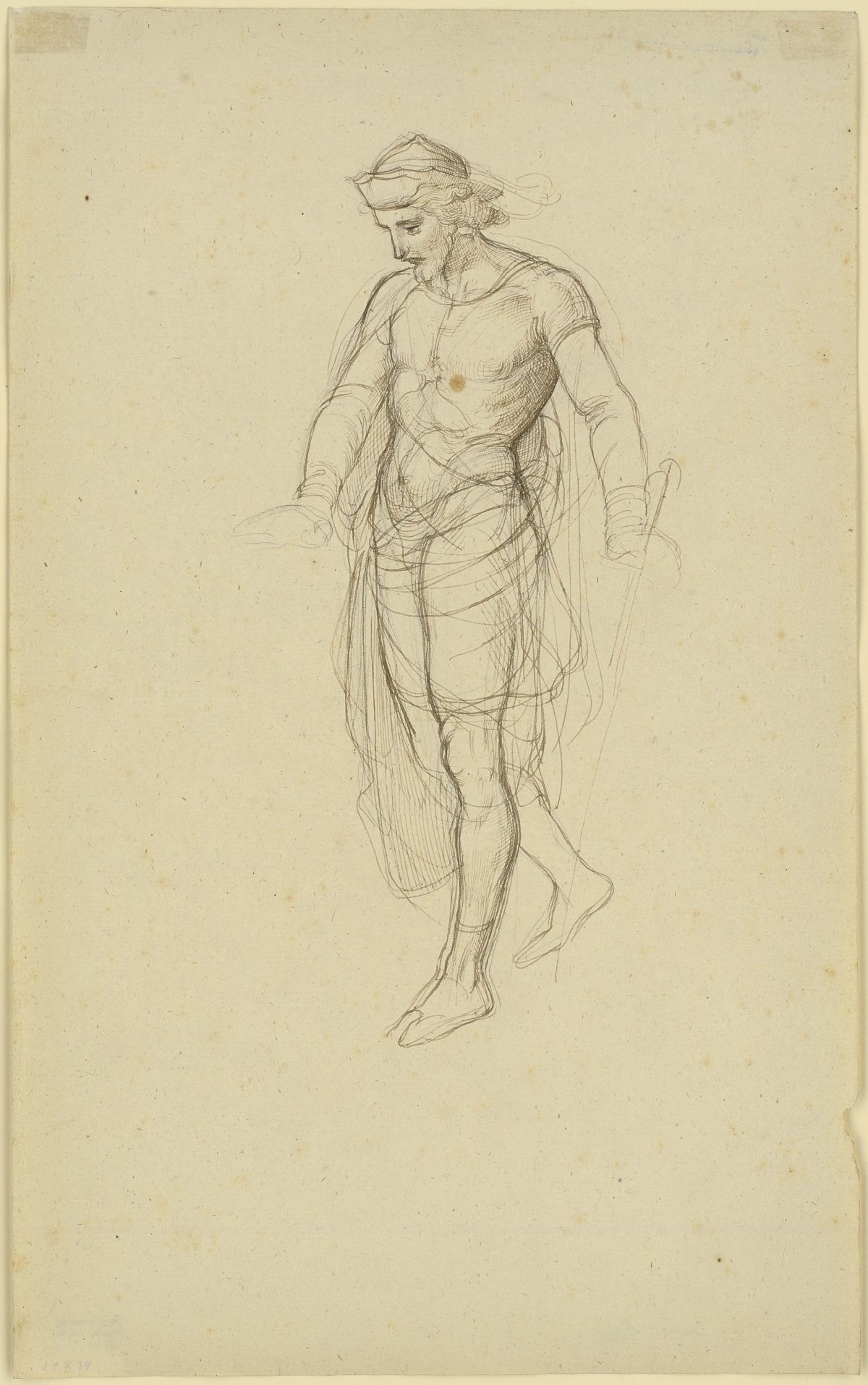
Moritz von Schwind, Kompositionsstudien zu David (David und Abigail), um 1830, Feder in Braun über Bleistift, 340 x 210 mm Blattmaß © Staatliche Graphische Sammlung München
- Friedrich Seidenstücker
Friedrich Seidenstücker was among the most important chroniclers of Berlin’s everyday life during the Weimar Republic. His photographs narrate inconspicuous events and incidents, telling of easy Sunday pleasures and exhausting working lives, children’s games on the street and crowds in railway stations or at the zoo. Seidenstücker casts an ironic and sometimes humorous eye on people and life in the metropolis. However, in the background and at the margins of his photographs, the social reality of the 1920s and 1930s can clearly be seen.
- Georges Seurat
1859 - 1891
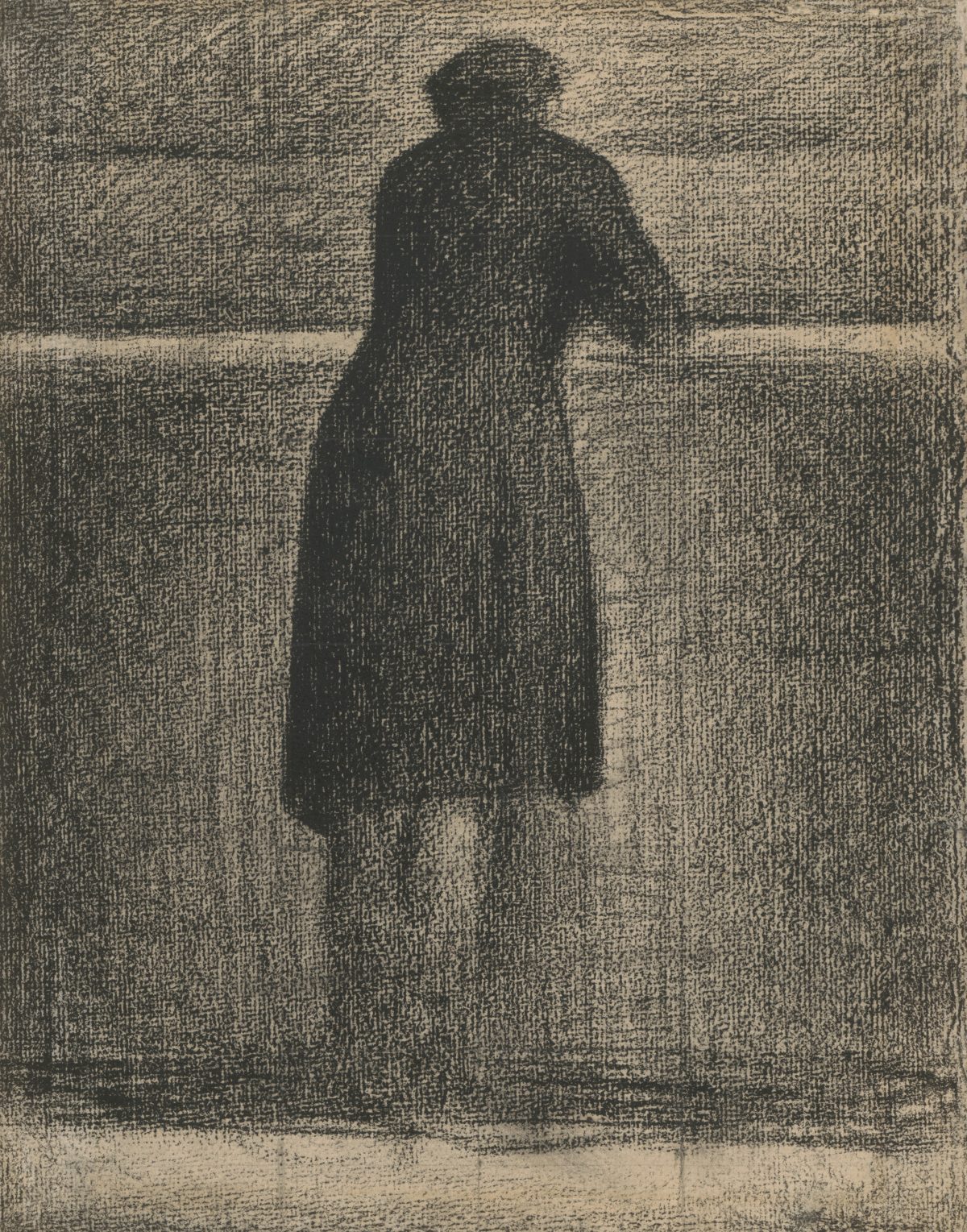
Georges Seurat, Mann an der Seine-Brüstung vor dem Invalidendom, 1880 - 1881, Conté-Kreide, 310 x 240 mm Blattmaß © Staatliche Graphische Sammlung München
- David Shrigley
The artist’s cartoonish, awkward-looking drawings reflect their radical confinement to bare essentials. But they are simple only at first glance, and reason alone is incapable of fully grasping them. Shrigley ’s approach is similar to that of children who reveal the strange, the terrible, and the meaningless alike without prejudice. With a disarming, often black sense of humour, the artist devotes himself to the banalities of everyday human life. LOOK AT THIS reverses the viewer ’s expectations by commanding us to notice the art.
- Alma Siedhoff-Buscher
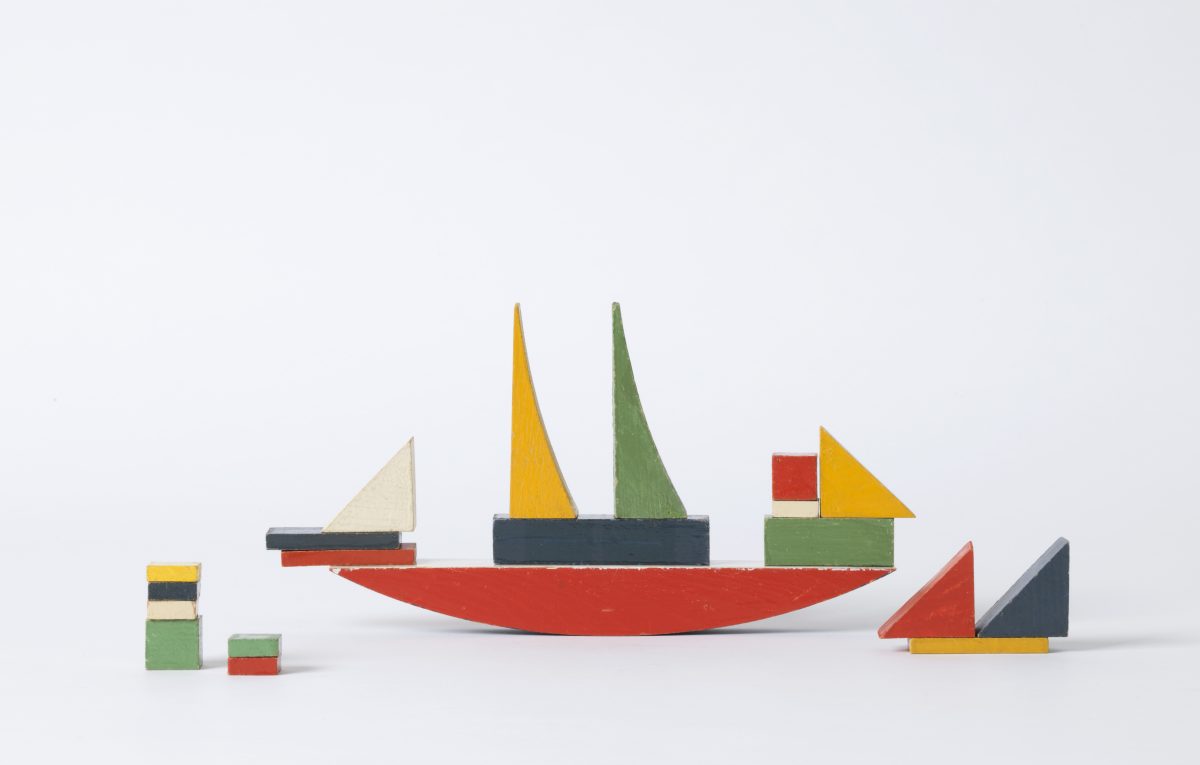 Schiffbauspiel, 1923, Holz, lackiert, Herst.: Staatliches Bauhaus, Weimar, Foto: Die Neue Sammlung — The Design Museum
Schiffbauspiel, 1923, Holz, lackiert, Herst.: Staatliches Bauhaus, Weimar, Foto: Die Neue Sammlung — The Design MuseumIn her "Ship-building Game" – produced in two versions – Alma Siedhoff-Buscher combined the design principles of Bauhaus with modern approaches to education and her own personal views on the need for modern toys to be designed to satisfy children’s curiosity and urge to explore.
- Santiago Sierra
1966
Die gesellschaftskritischen Werke des spanischen Installations- und Konzeptkünstlers provozieren, indem sie die Grenzen der westlichen Wertvorstellungen spürbar aushebeln. Insbesondere in seinen Raumarbeiten lassen sich seine künstlerischen Fragestellungen am eigenen Körper nacherleben.
- Kiki Smith
 Kiki Smith, Sueño, 1992, Radierung auf Aquatinta auf handgeschöpftem Echizen-Kouzo-Kizuki-Papier, 1057 x 1940 mm © Kiki Smith, courtesy Pace Gallery
Kiki Smith, Sueño, 1992, Radierung auf Aquatinta auf handgeschöpftem Echizen-Kouzo-Kizuki-Papier, 1057 x 1940 mm © Kiki Smith, courtesy Pace GalleryIm Zentrum des Schaffens der US-amerikanischen Bildhauerin und Graphikerin steht die Befragung der Konditionen des menschlichen Daseins. Mit ihrer Radierung gelang ihr die maßstabsgetreue Übertragung des menschlichen Körpers auf eine Druckplatte, eindrucksvoll und zugleich zerbrechlich wirkend durch die fehlende Darstellung seiner umhüllenden Hautschicht.
- Matti Suuronen
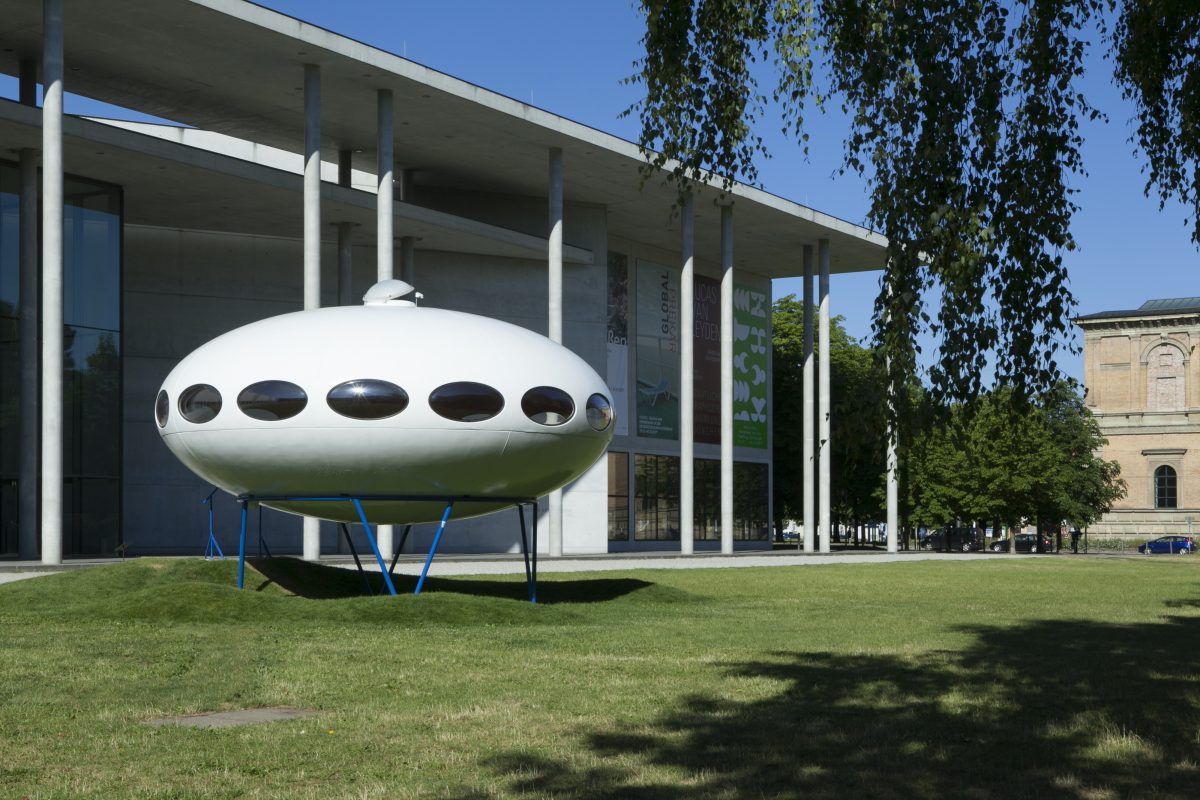 Suuronen, Matti, Kunststoffhaus FUTURO, 1968, Glasfaserverstärkter Kunststoff, Metall, Herst.: Polykem Ltd., Finnland, Foto: Die Neue Sammlung — The Design Museum
Suuronen, Matti, Kunststoffhaus FUTURO, 1968, Glasfaserverstärkter Kunststoff, Metall, Herst.: Polykem Ltd., Finnland, Foto: Die Neue Sammlung — The Design MuseumThe design icon of the space age — the plastic house FUTURO developed by Matti Suuronen and originally conceived as a ski lodge. With its ellipsoid shape, it embodies the visions of the future held in the 1960s, when new materials were the prime focus of visionary designs for mobile living spaces. Shaped by confidence in science and technology and the conquest of outer space, it symbolises the search for new, functional, efficient and mass-producible housing, which prevailed at that time.
-
- T
- Fiona Tan
What constitutes the egomatter? In this video installation, simultaneously projected on four screens, the artist, who is from Australia, uses 250 filmed portraits to develop a sociocultural study of German society taken at the beginning of the 21st century in Berlin. The work in black-and-white is a conscious reference to August Sander ’s People of the Twentieth Century (p. 129). The limited field of view, the silence and tension of the filmed persons creates a high degree of concentration and intensity, and a constant dialogue takes place between those portrayed and the viewers.
- Christiane Thalgott
1942
Christiane Thalgott war als Münchner Stadtbaurätin von 1992 bis 2007 an vielen bedeutenden Entscheidungen – unter anderem über den Umbau des Hauptbahnhofs und den Ausbau des Mittleren Rings – beteiligt. Sie lehrte an der Universität Kiel und ab 1996 an der TU München, wo sie 2003 zur Honorarprofessorin ernannt wurde. Christiane Thalgott ist Schirmherrin des Förderpreises der Frauenbeauftragten, der jedes Jahr durch die Fakultät für Architektur der TU München vergeben wird.
- Gert & Uwe Tobias
1976
Das Spiel mit Farben und Formen charakterisiert die großformatigen collageartigen Werke der Künstlerbrüder, die sich auf die Arbeit mit verschiedenen Drucktechniken, insbesondere dem Holzschnitt, spezialisiert haben. Dabei revolutionieren sie traditionelle Techniken – etwa die Grisaillemalerei – und bilden eine ungewohnt neue Bildsprache des 21. Jahrhunderts aus.
- Henri de Toulouse-Lautrec
1864 - 1901
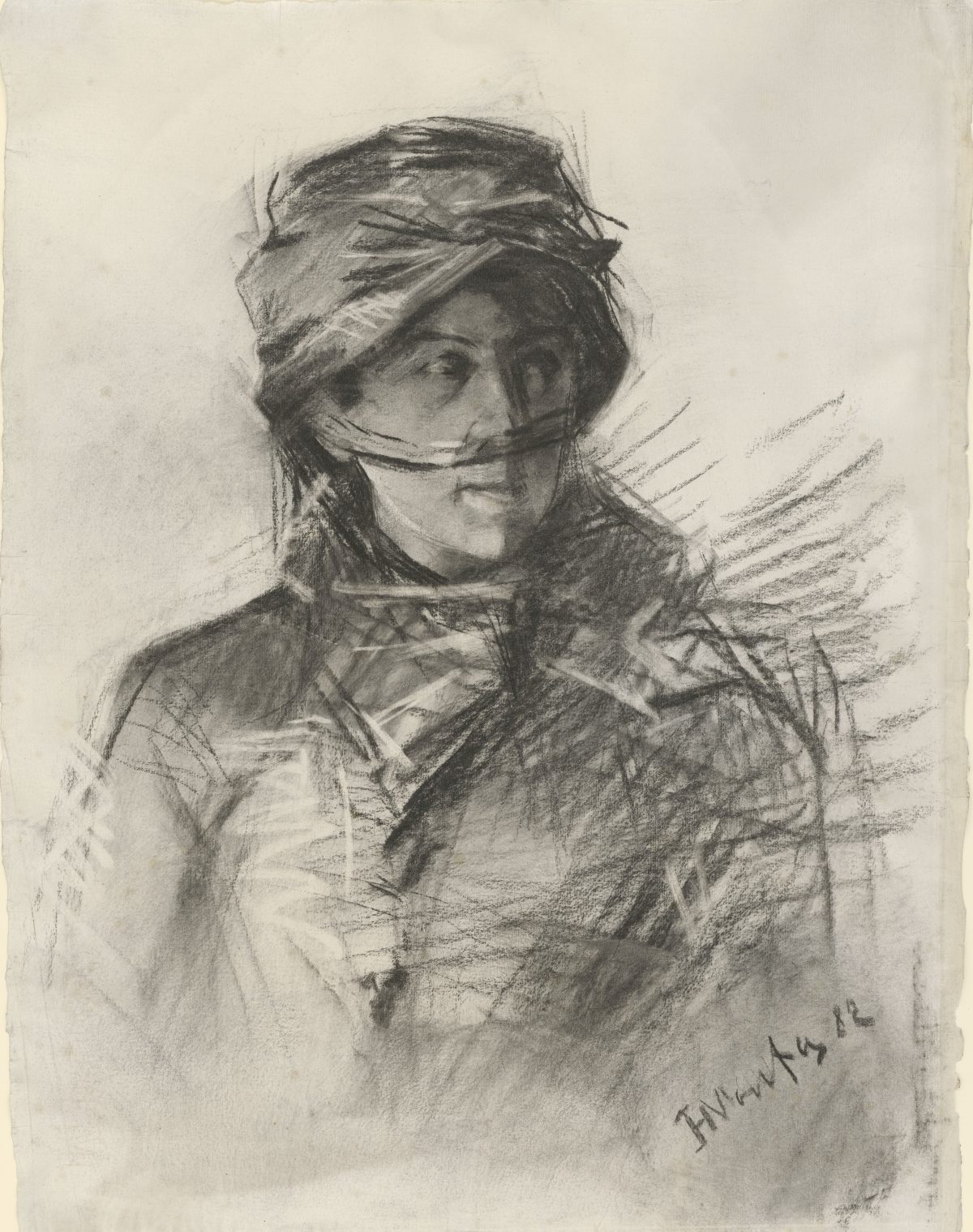
Henri de Toulouse-Lautrec, Portrait der Comtesse Émilie de Toulouse-Lautrec, 1882, Kohle, 630 x 478 mm Blattmaß © Staatliche Graphische Sammlung München
- Luc Tuymans
Scepticism and asceticism define Luc Tuymans’ paintings. His pictures revolve around the conditions of seeing. Three Moons shows a planetary constellation, a space that, under extended viewing, eludes concreteness. All orientation is lost in an indistinct shape filled with a blaze of light: the enormous appears tiny, depth is flattened, the significant becomes peripheral. The world is lost; it becomes a model, shadow, or afterimage. The image proves to be both illusion and delusion, it returns to a time before representation, to the origins of image-making.
-
- W
- Otto Wagner
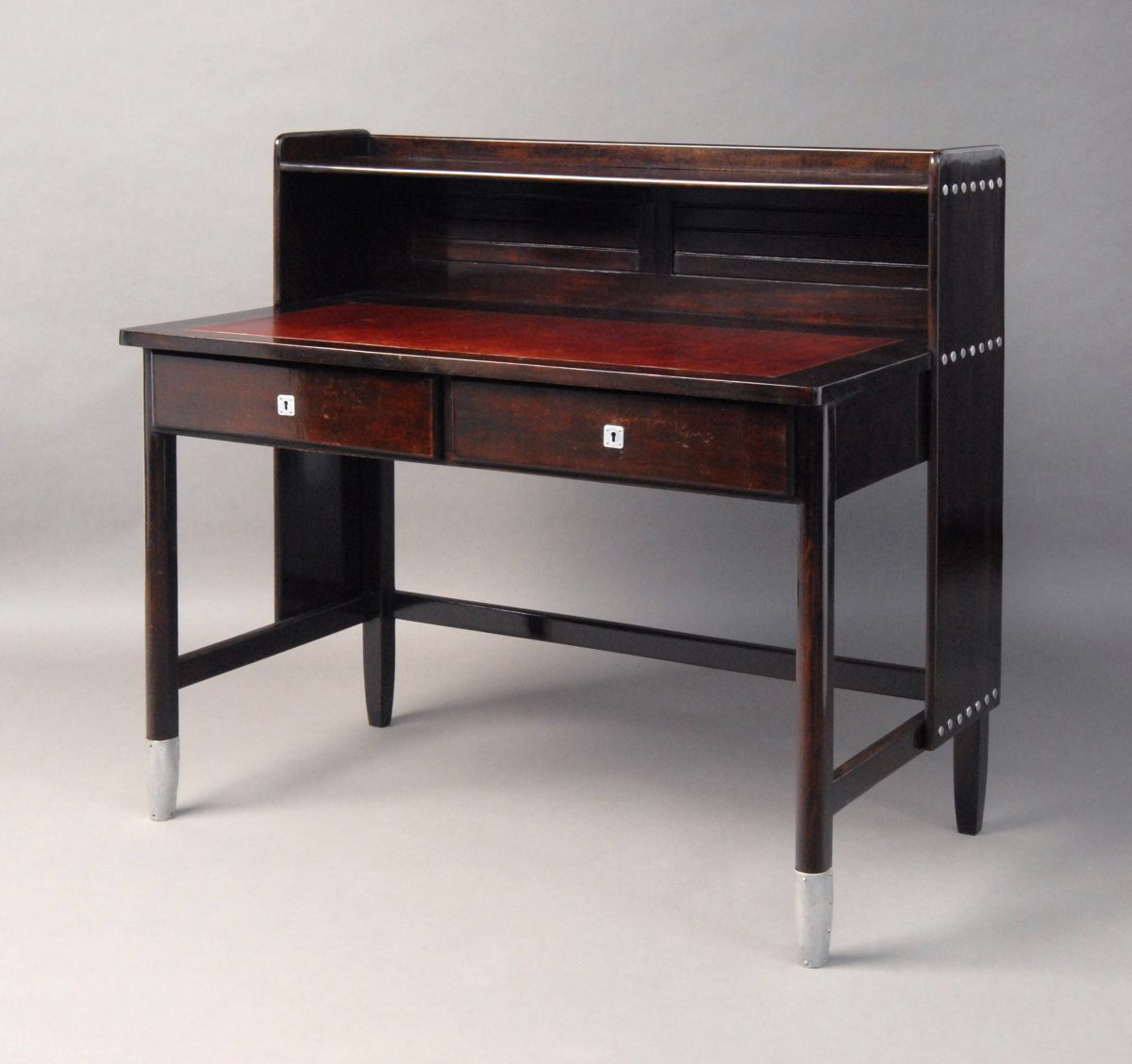 Wagner, Otto, Schreibtisch und Hocker der Wiener Postsparkasse, um 1904, Buchenholz, braun gebeizt, Aluminium, Herst.: Gebr. Thonet, Wien, Foto: Die Neue Sammlung — The Design Museum
Wagner, Otto, Schreibtisch und Hocker der Wiener Postsparkasse, um 1904, Buchenholz, braun gebeizt, Aluminium, Herst.: Gebr. Thonet, Wien, Foto: Die Neue Sammlung — The Design MuseumDie Möbelentwürfe für das Postsparkassenamt konstituieren zugleich den neuen Stil der Wiener Avantgarde, der die Konstruktion und Funktion der Möbel bewußt sichtbar macht, auf Stildekor im traditionellen Sinn verzichtet und auch modernste Materialien (Aluminium) einsetzt.
- Jeff Wall
In Form eines fotografischen re-enactment zeigt Jeff Wall einen aus Anatolien stammenden, jungen Mann, den er kurz zuvor kennengelernt hatte. Seine nachträglich in Szene gesetzte Ankunft ereignet sich in Mahmutbey, einem durch illegale Ansiedlungen und ausufernde Gewerbegebiete charakterisierten Vorort von Istanbul. Mahmutbey erscheint weder urban noch dörflich, sondern wie ein Passagenraum, der kaum Orientierung bietet. Die gewählte Ansicht öffnet den Blick in die Ferne, aber nicht zum Ziel der Reise, und ist wie ein Bildgedicht auf die Megapolis des späten 20. Jahrhunderts zu lesen.
- Gillian Wearing
Art, for Wearing, is about making social relationships visible. Her work – frank and unsparing, yet always respectful – shows people in staged situations. The result is a collection of portraits that strike a fine balance between the private and the public. In 1992–93, the artist stood on the street and asked passers-by to spontaneously commit to paper a thought that was important to them, and then to be photographed holding it. The combination of image and text creates a form of doubled address, casts doubt on our own perceptions and public image, and poses questions about truthfulness, projection, assimilation, and selfdetermination.
- Rachel Whiteread
1963
Thema der englischen Künstlerin ist der Raum, insbesondere der Leerraum, und seine emotionalen, sozialkritischen und politischen Konnotationen. Diesen visualisiert sie sowohl in Installationen im Außenraum und Mixed-Media-Installationen als auch auf der deutlich begrenzteren zweidimensionalen Fläche des Papiers.
- Garry Winogrand
The streets of the American big city served as a photographic hunting ground for Gary Winogrand. The life that played out there reflects the profound social upheavals of the 1960s. Winogrand often tended to prefer directing his camera towards the elegant young women who moved through these streets. Yet his wide-angle lens always also took in the wider context of a scene. Without hierarchizing them or moralizing, the photographer shows people from various ethnic groups and social classes and opens up our view to society in all its complexity.
- (Wolfgang Schulze) Wols
1913 - 1951
The surreal-like and, at the same time, both expressive and subtle art of the German painter and photographer, who was predominantly active in France, influenced significant trends in art in Europe after the Second World War. His works, which oscillated between form and non-form and expressed through a radically existentialist mode of expression, made him the pioneer of the Informel art movement.
-